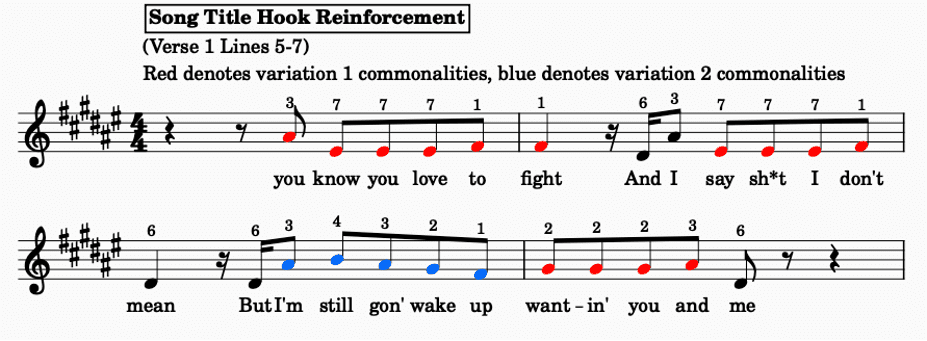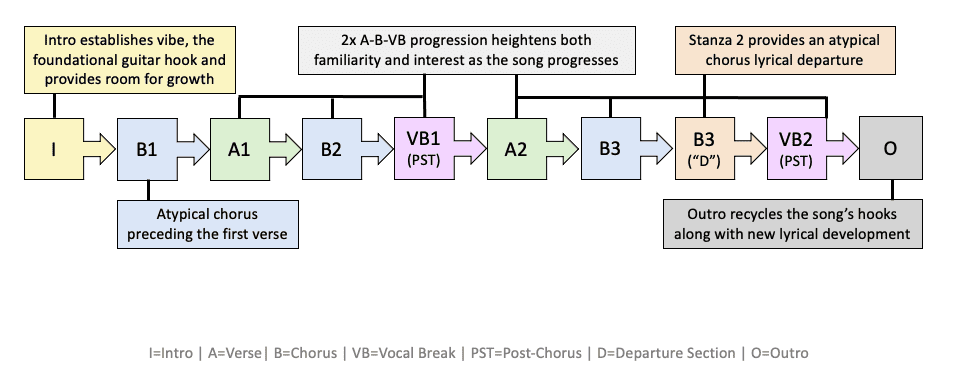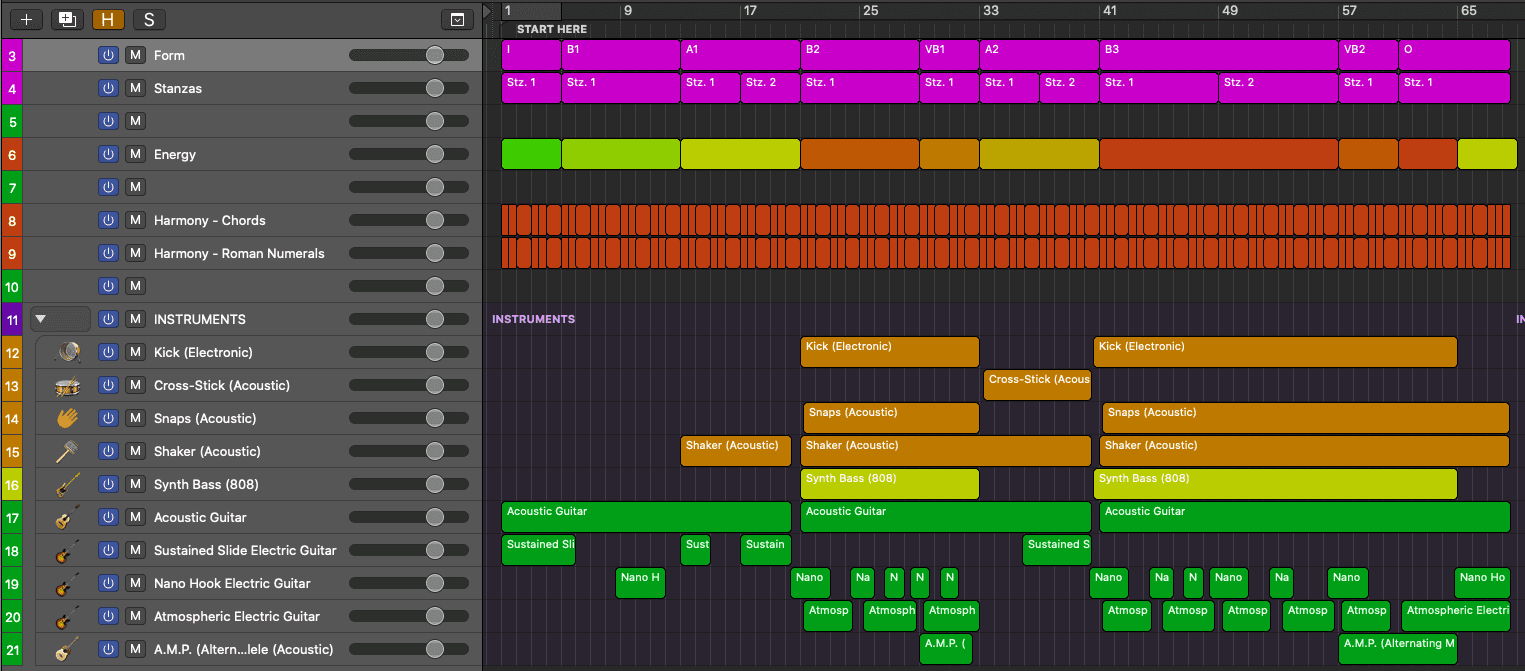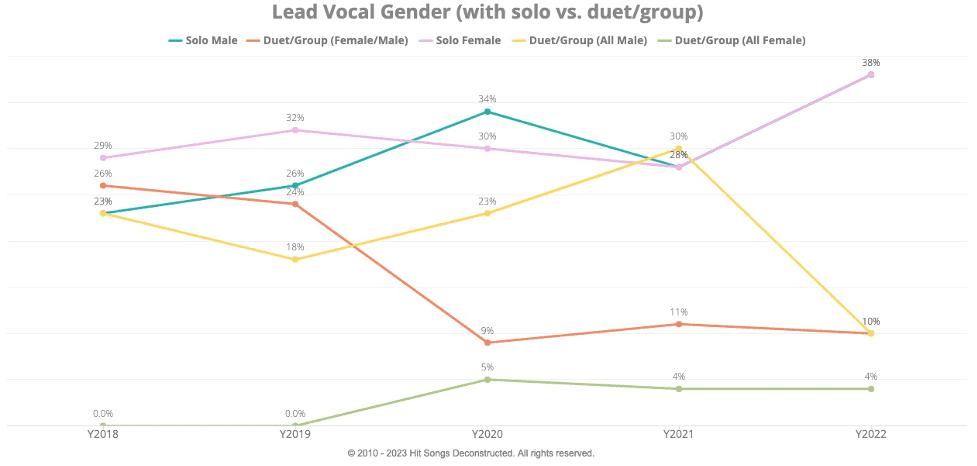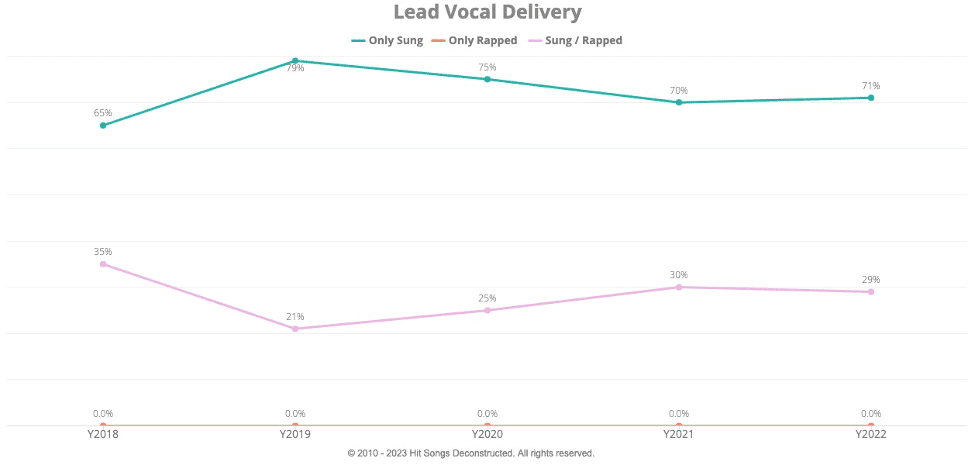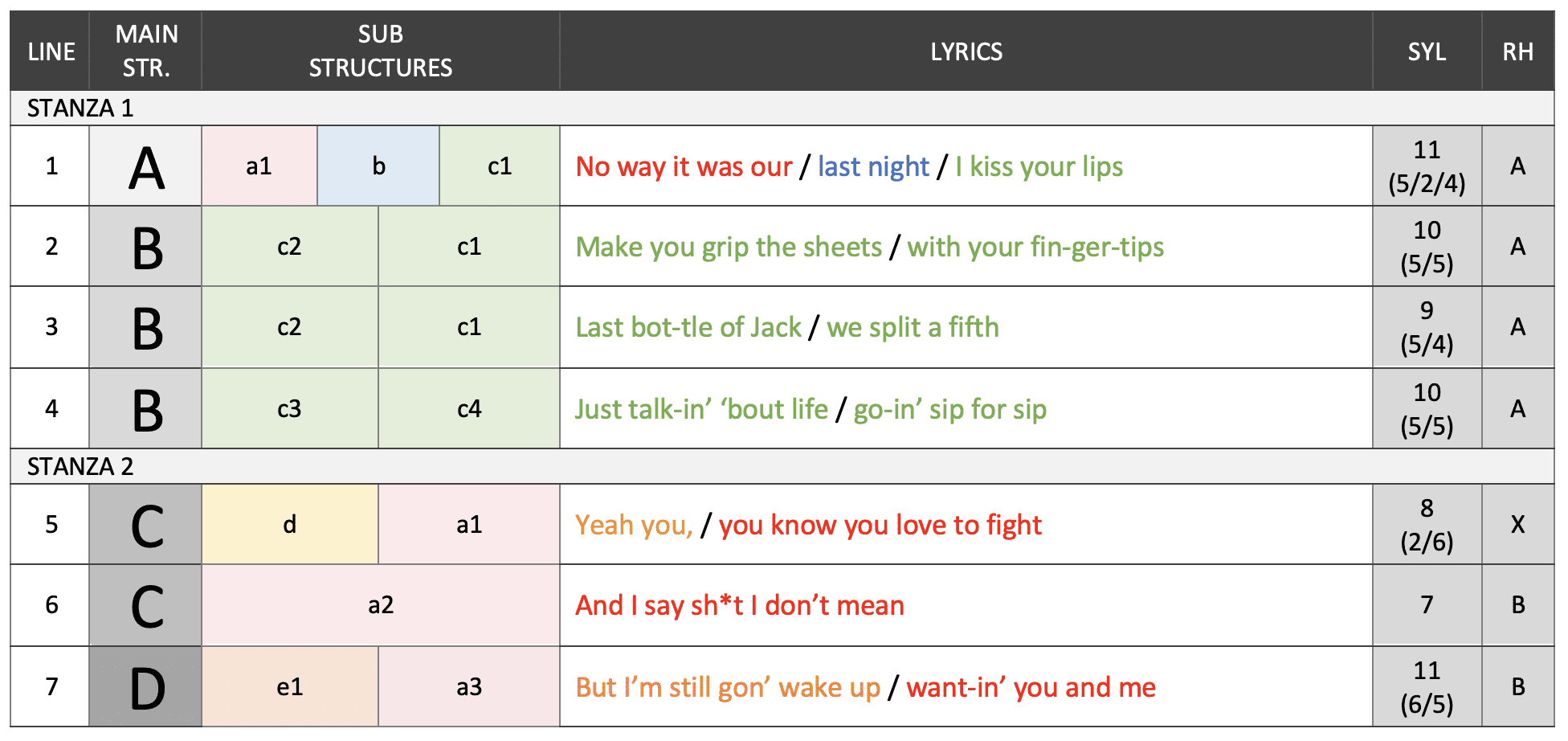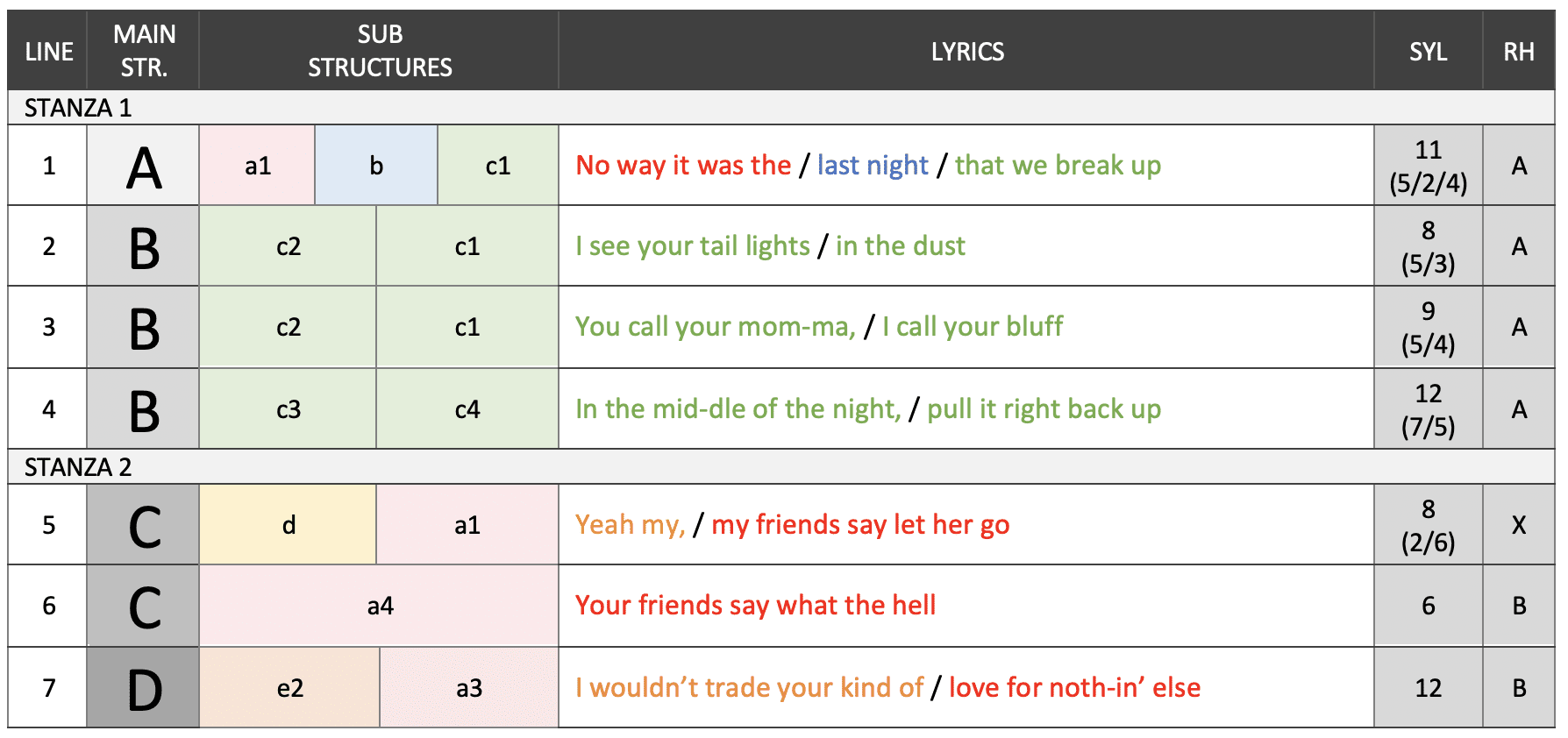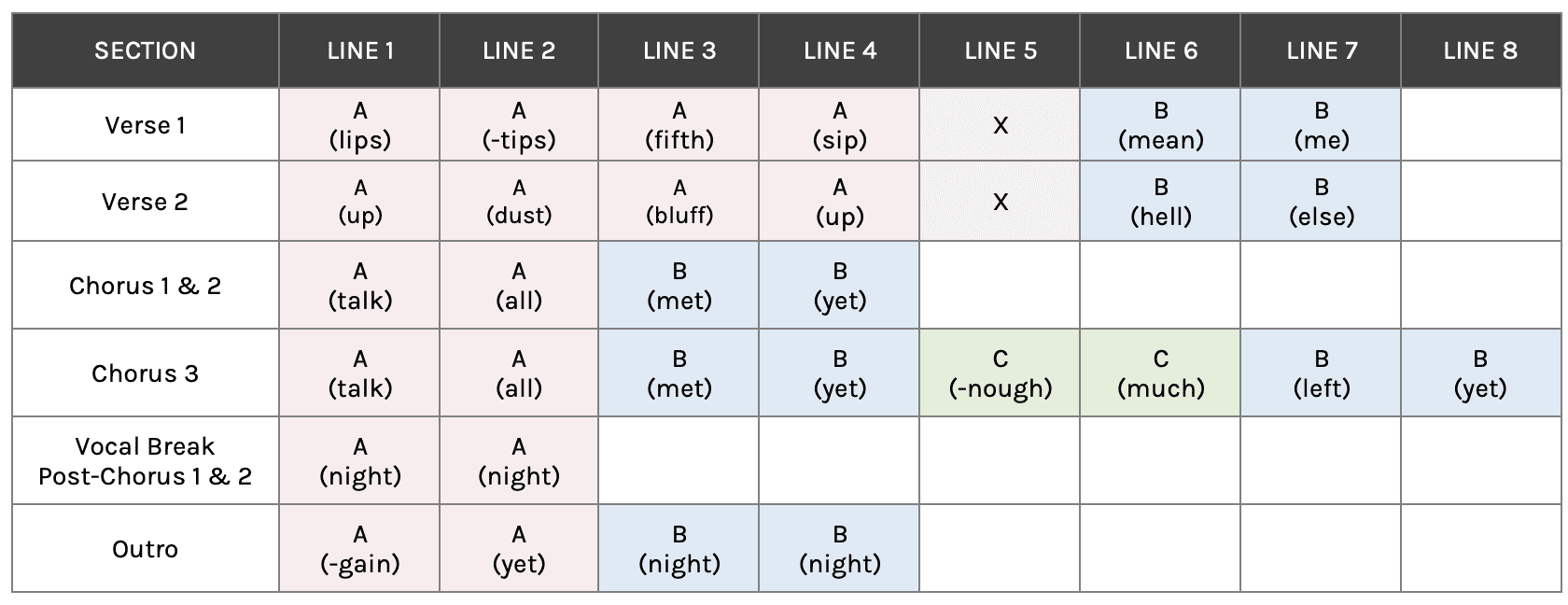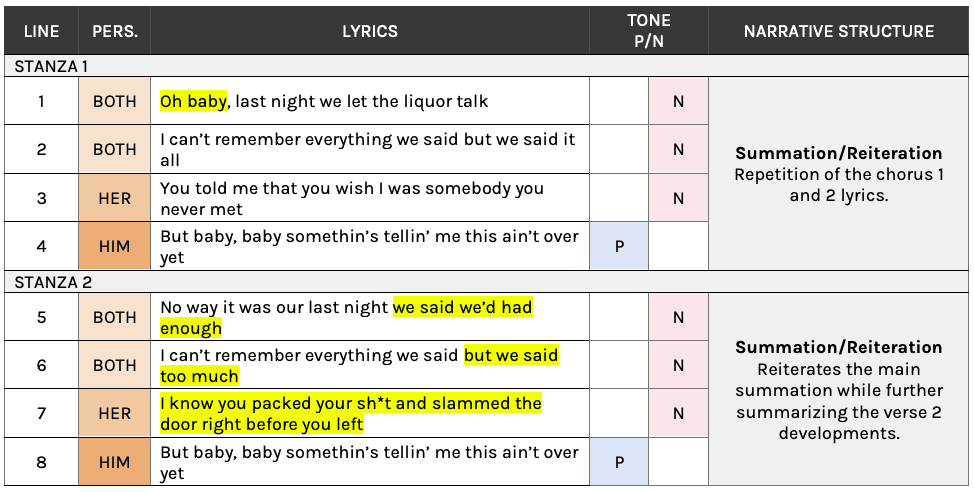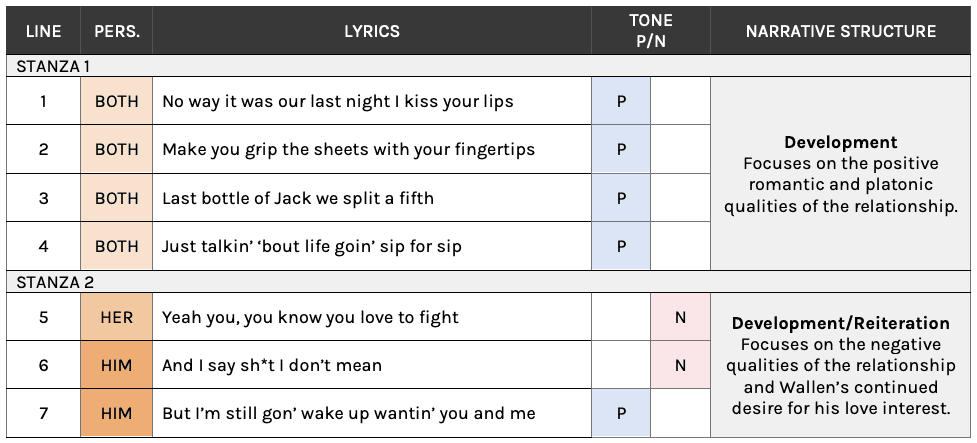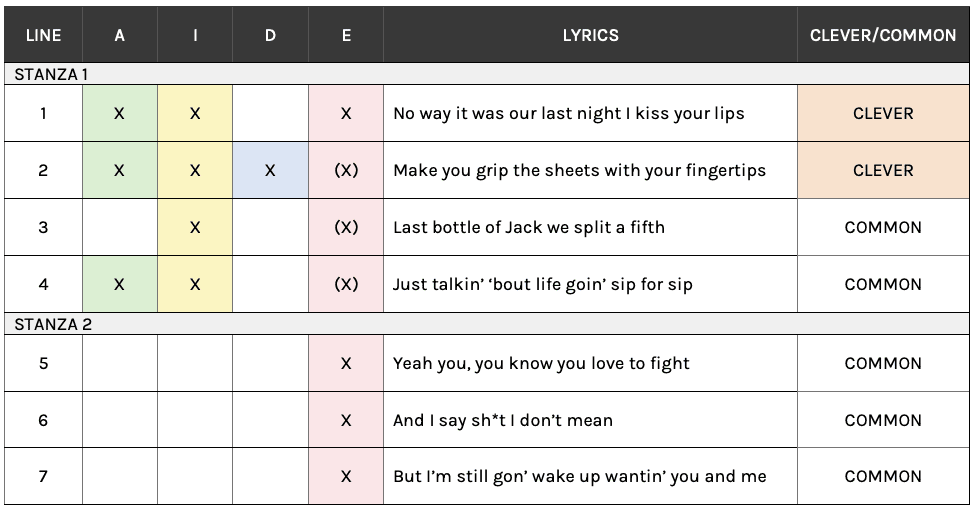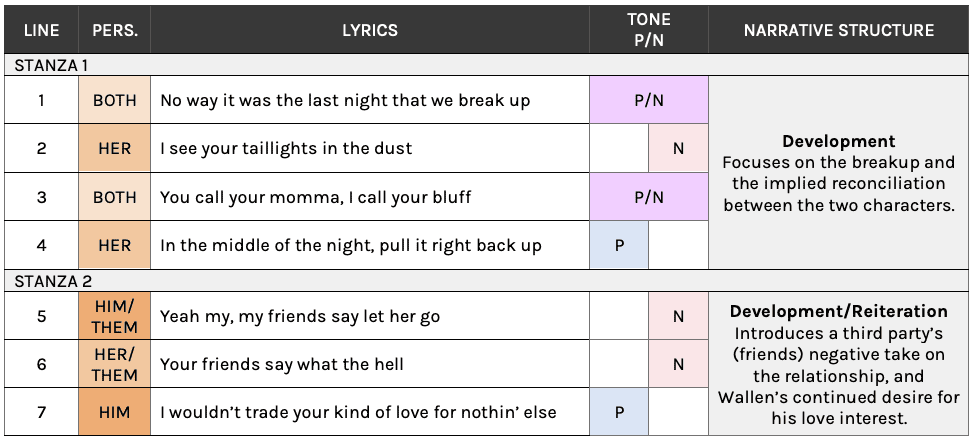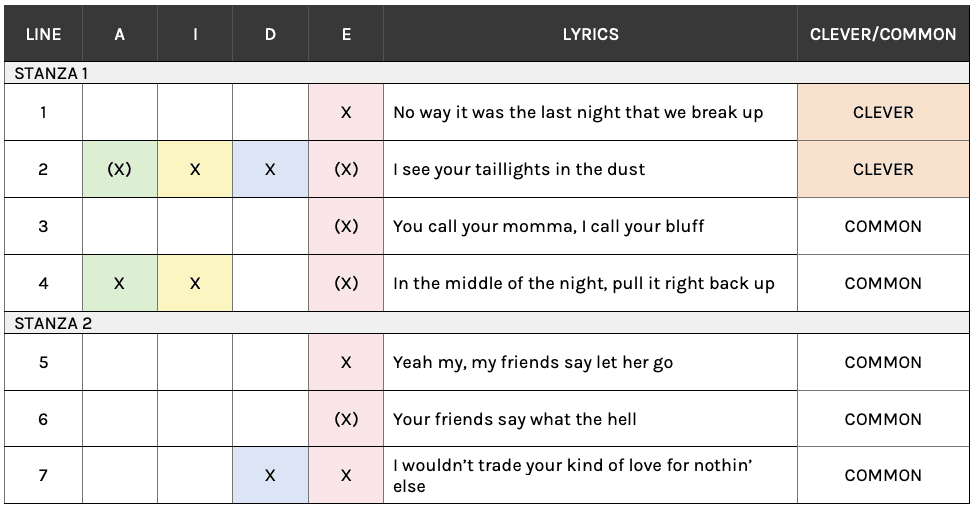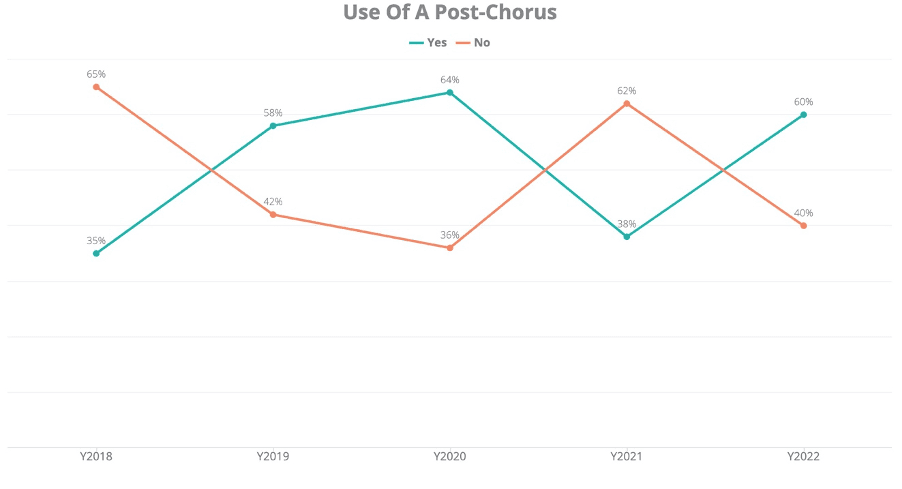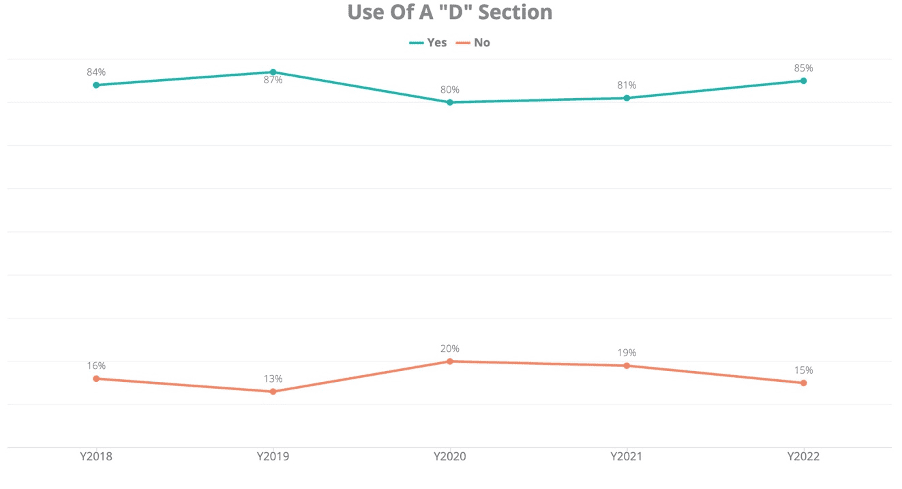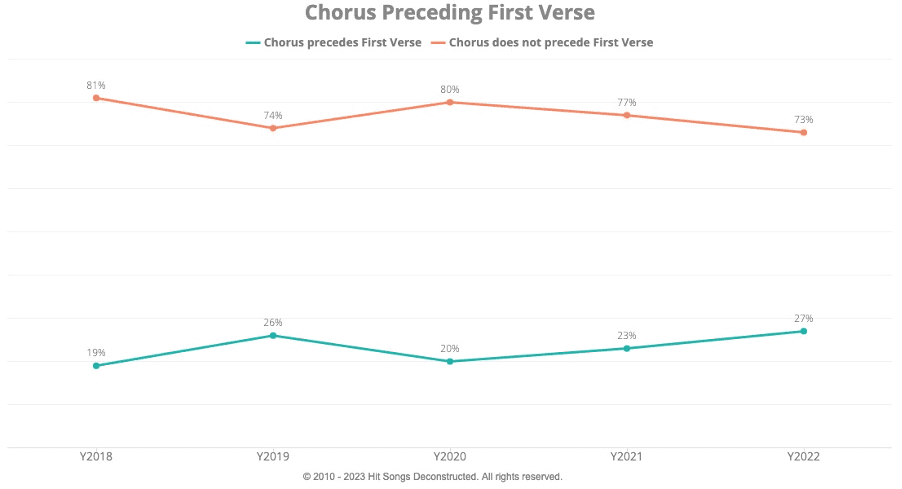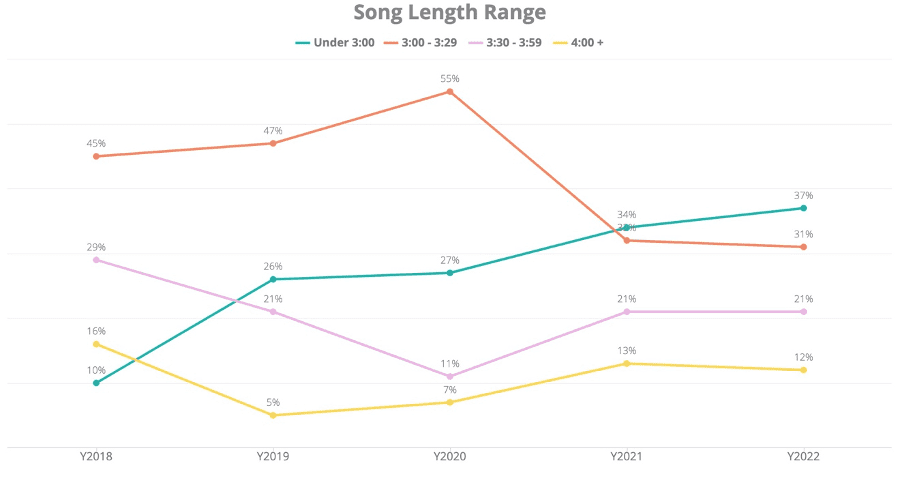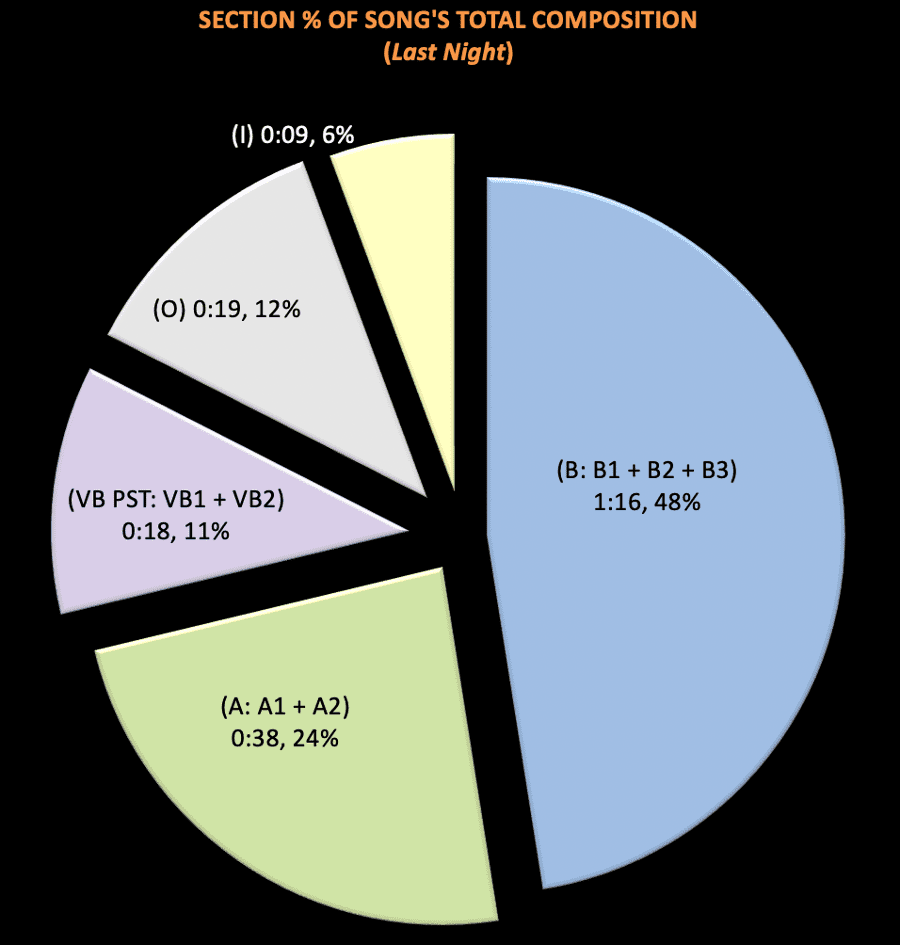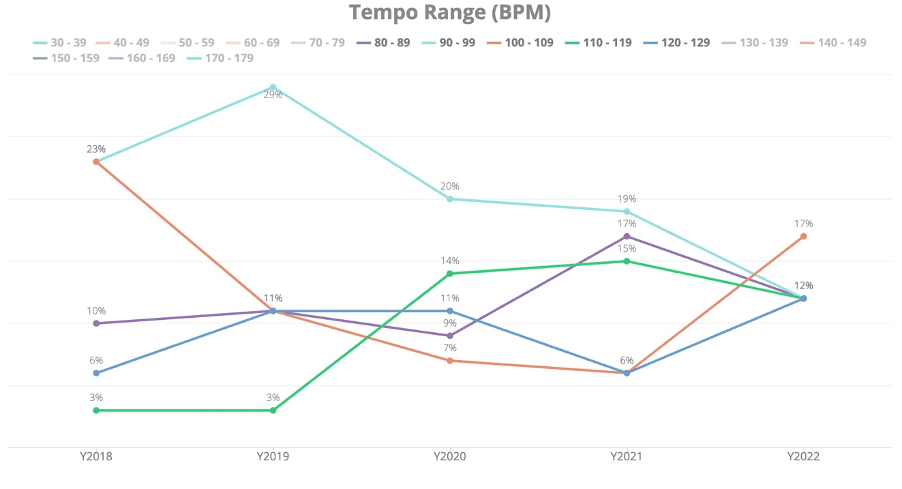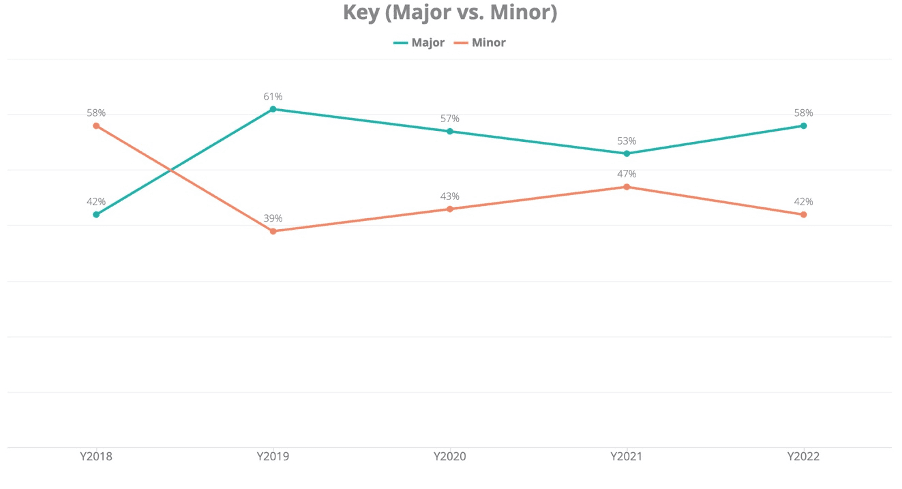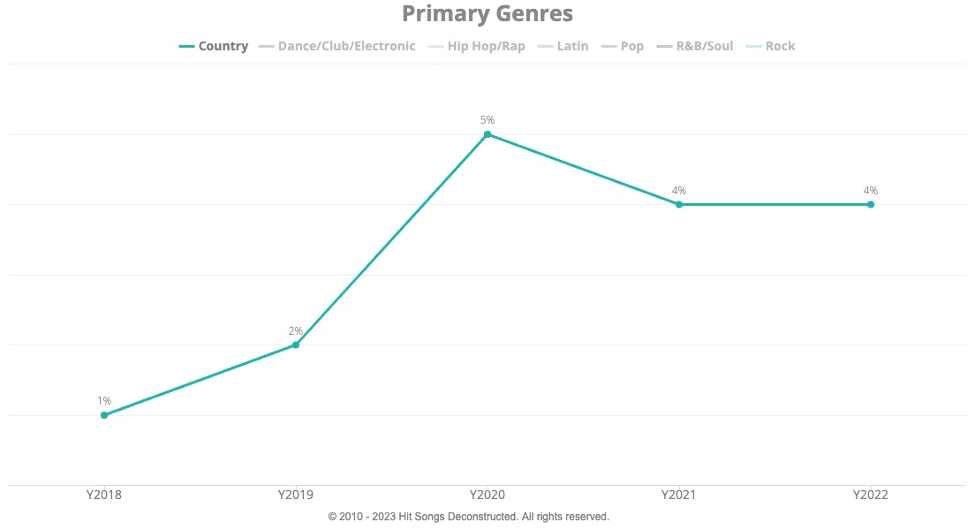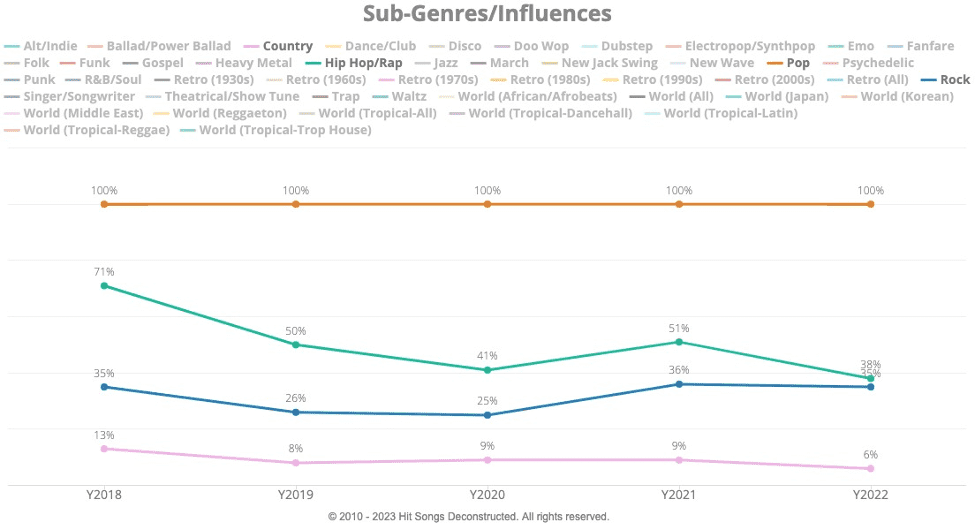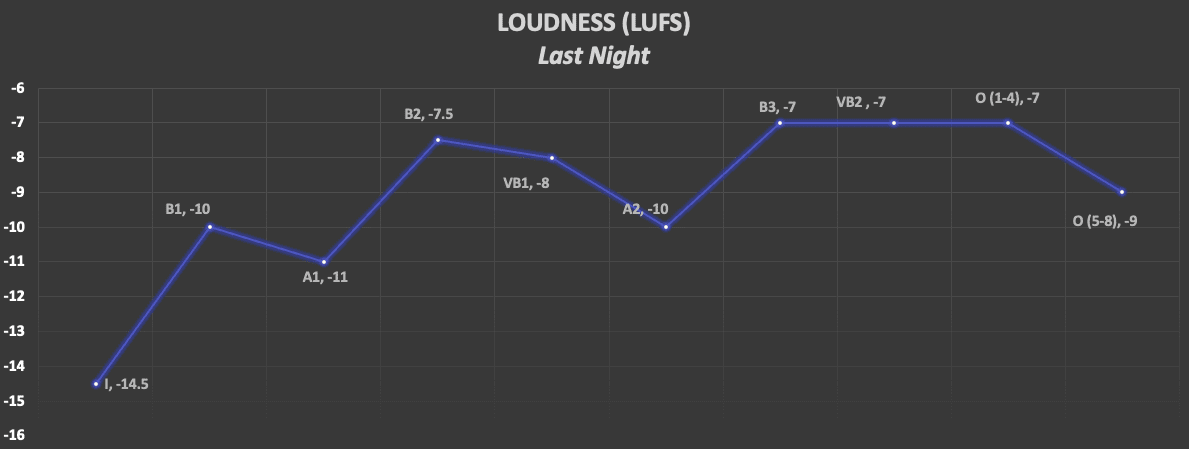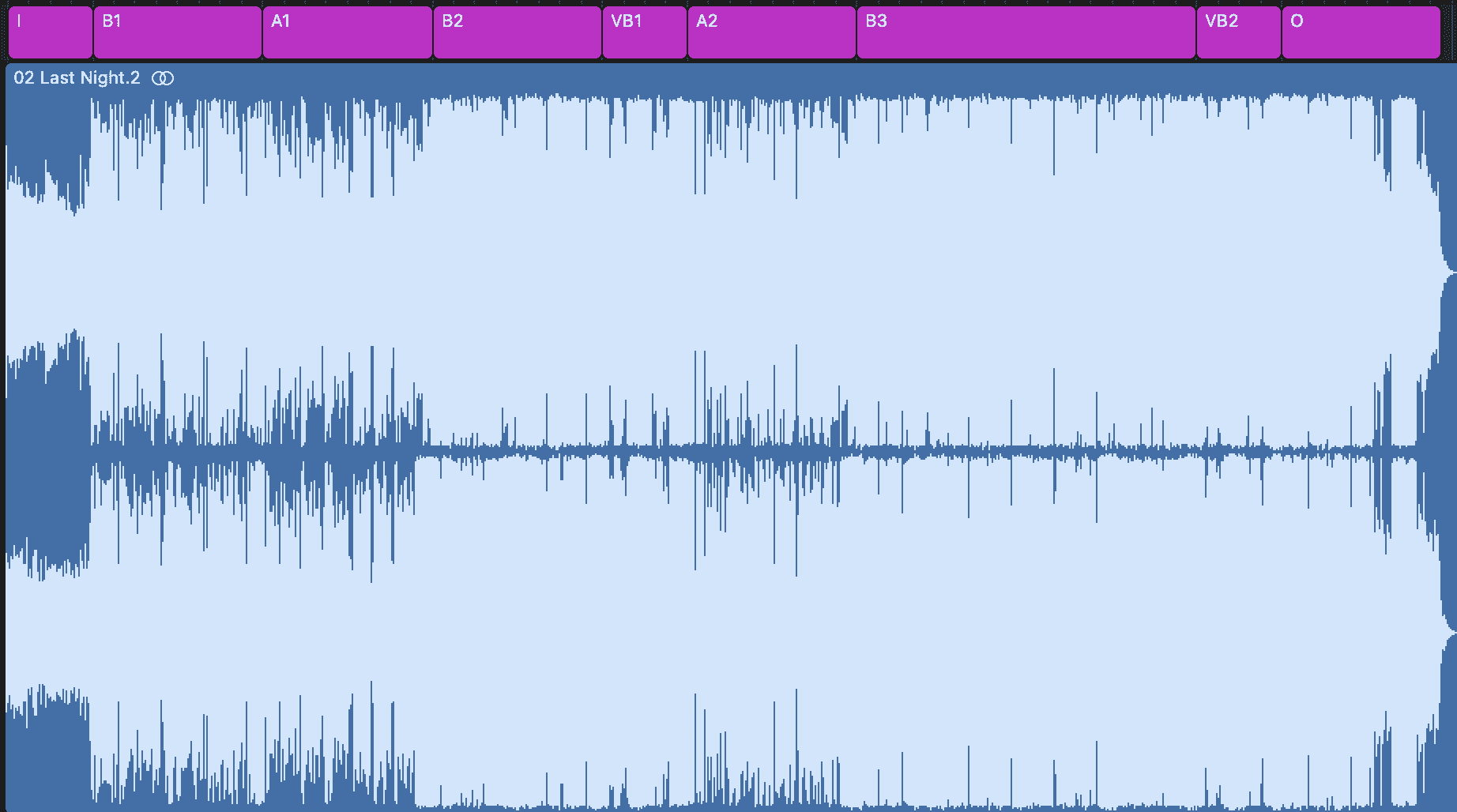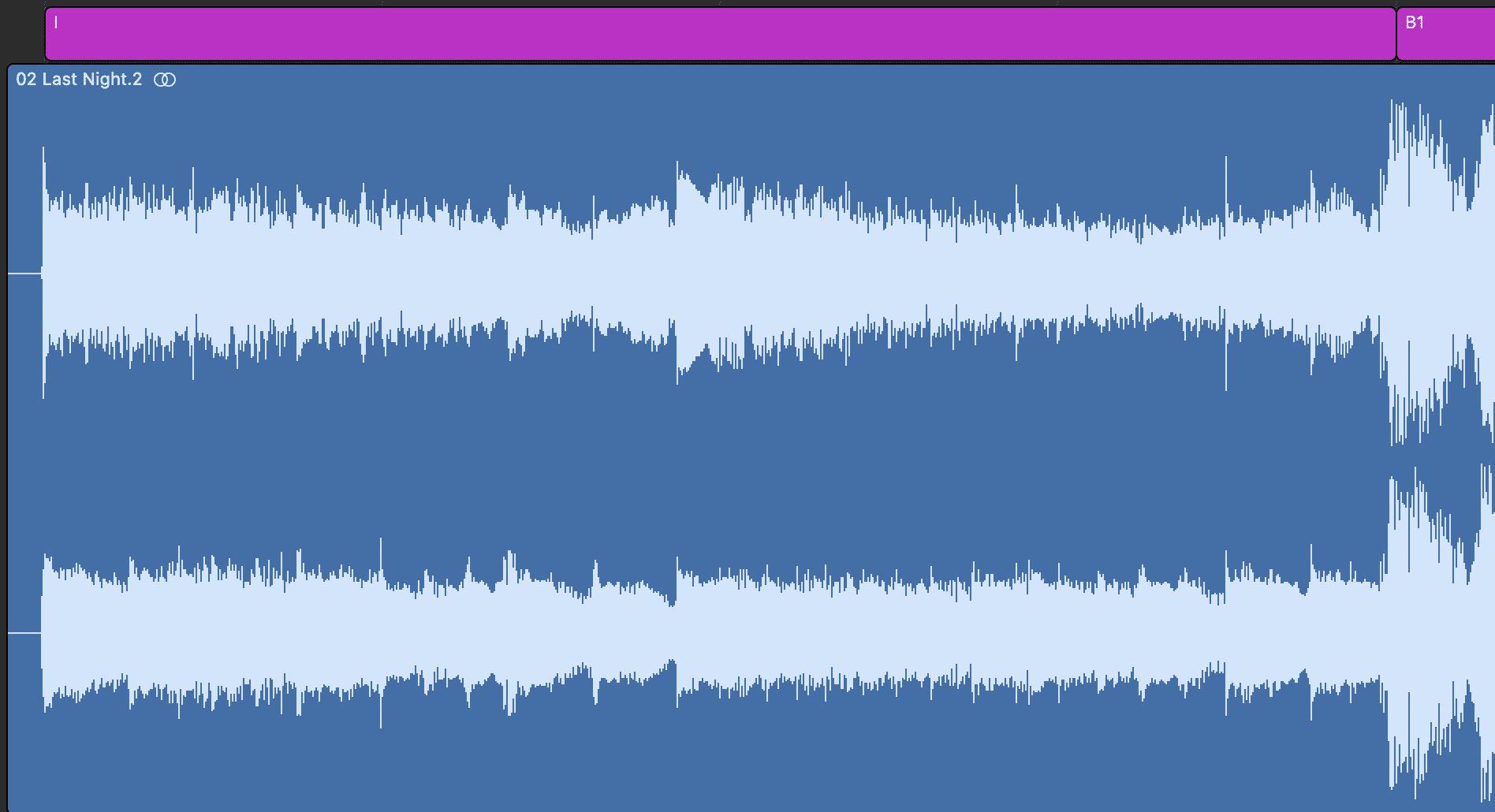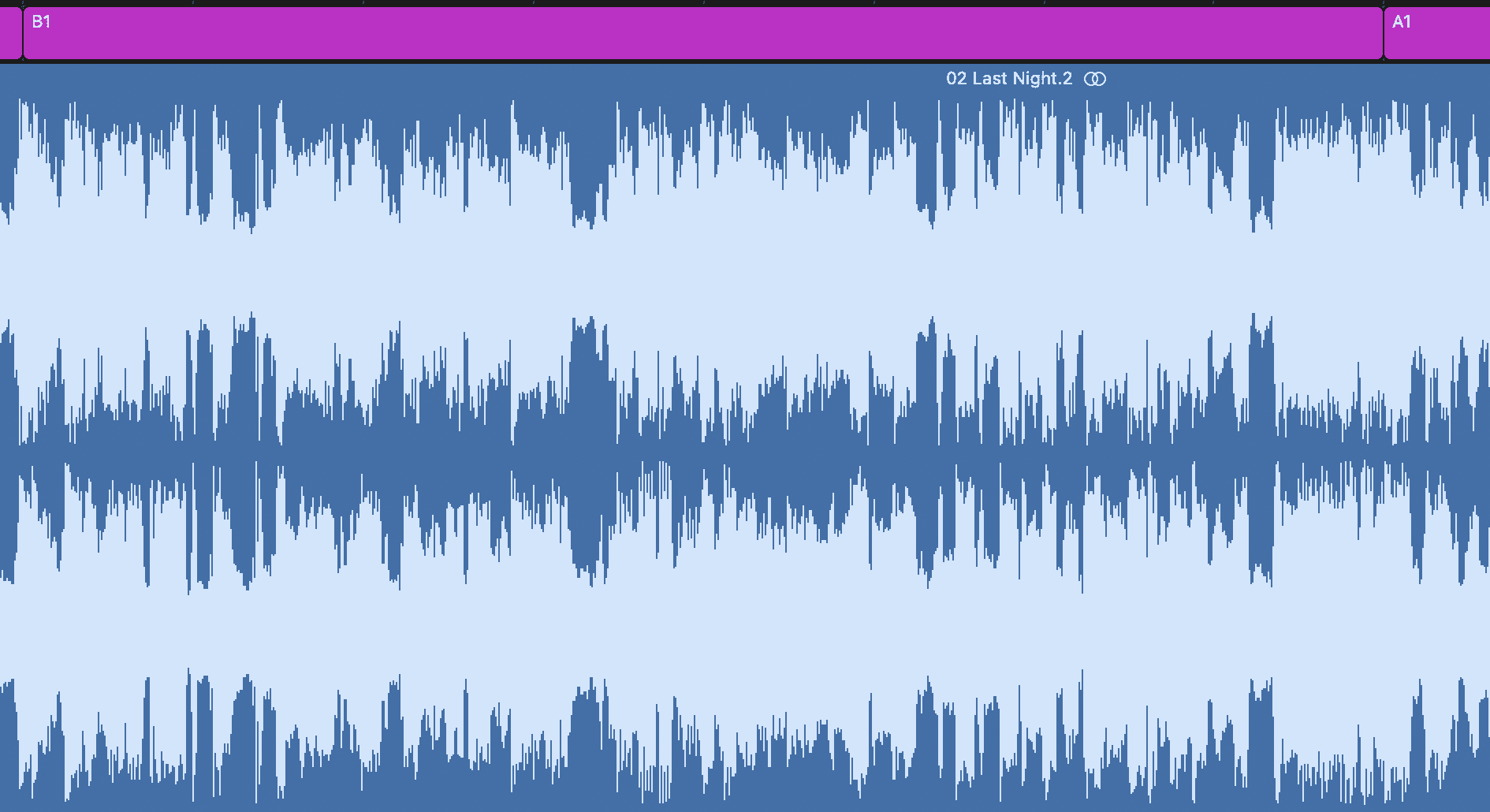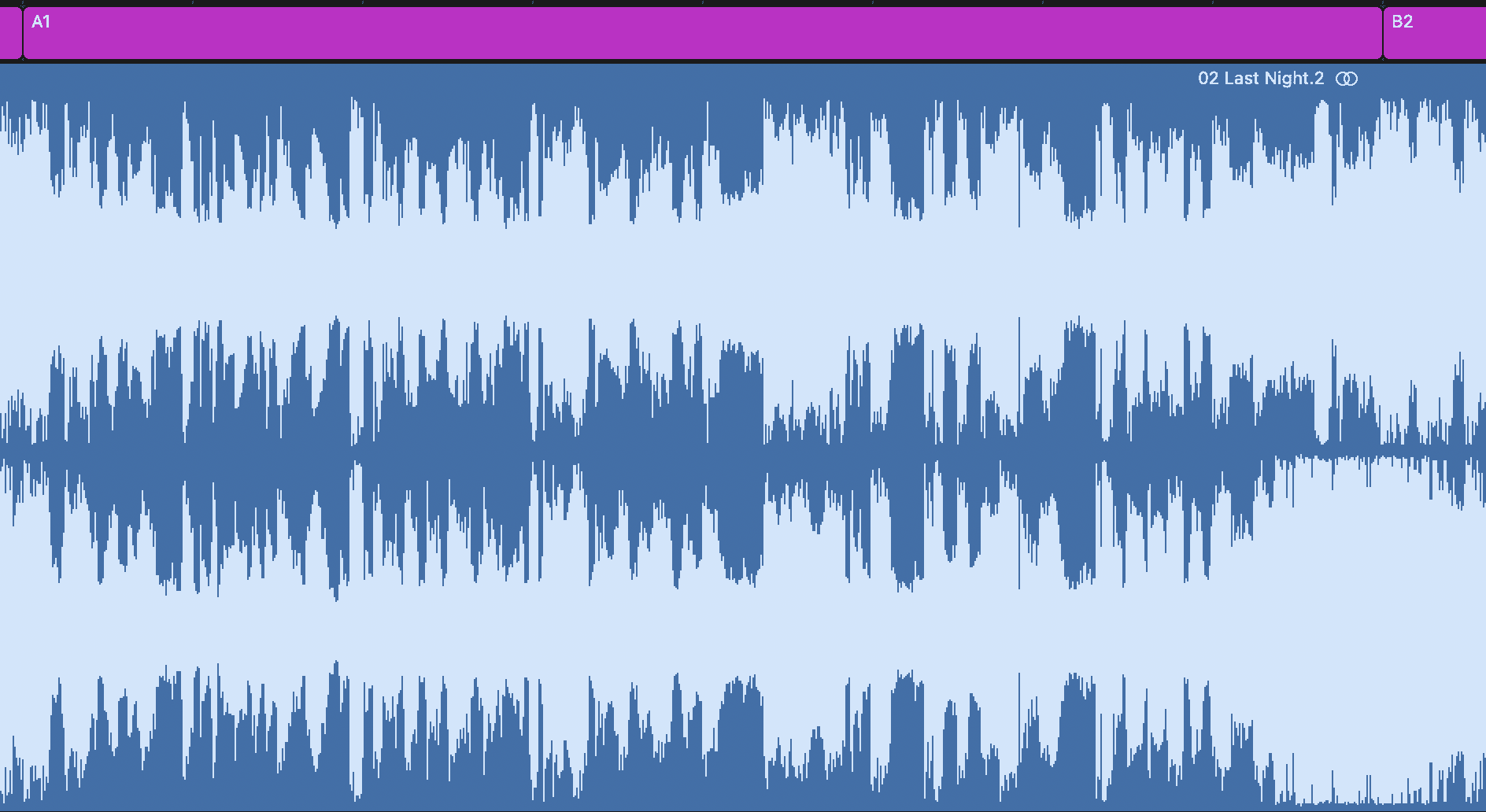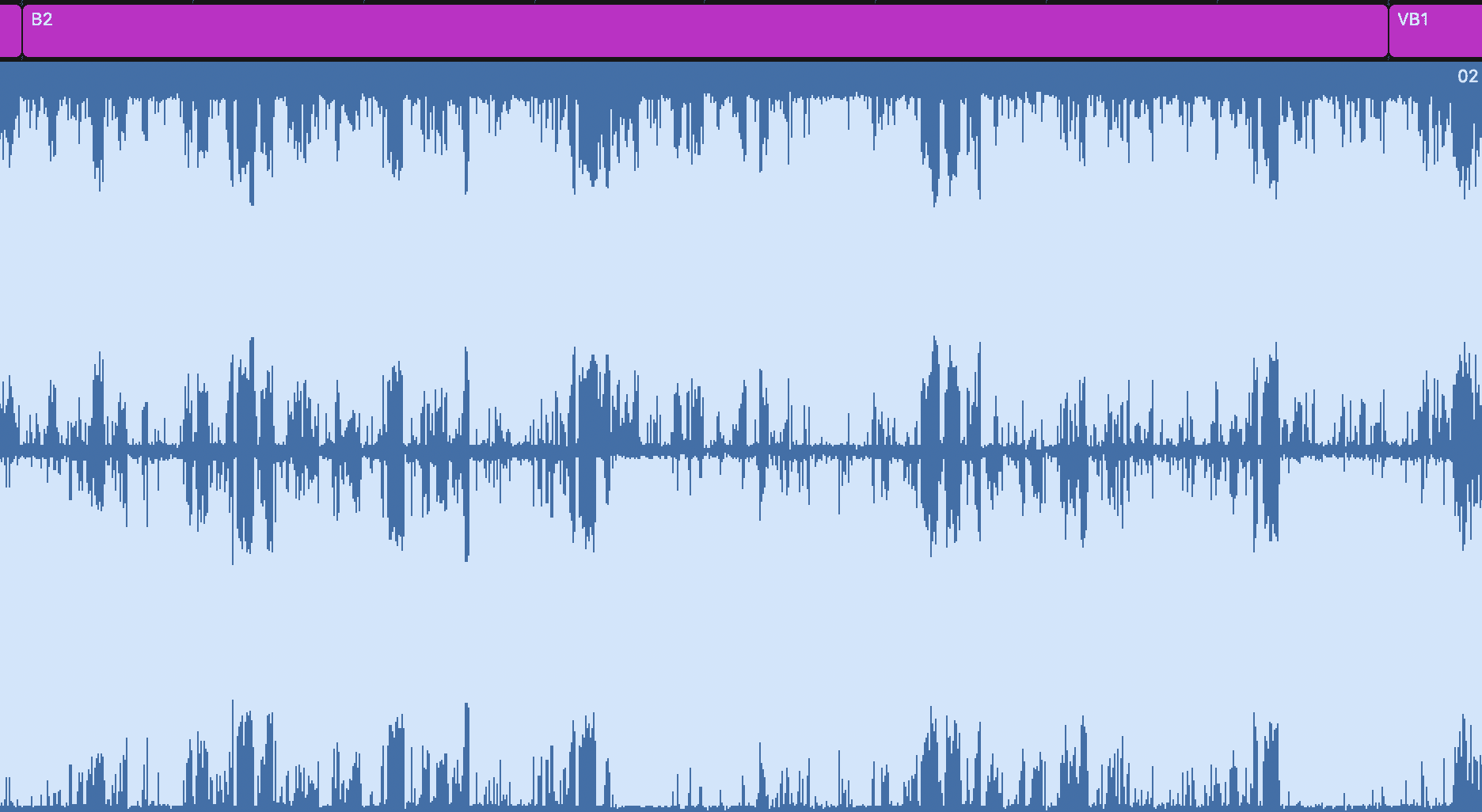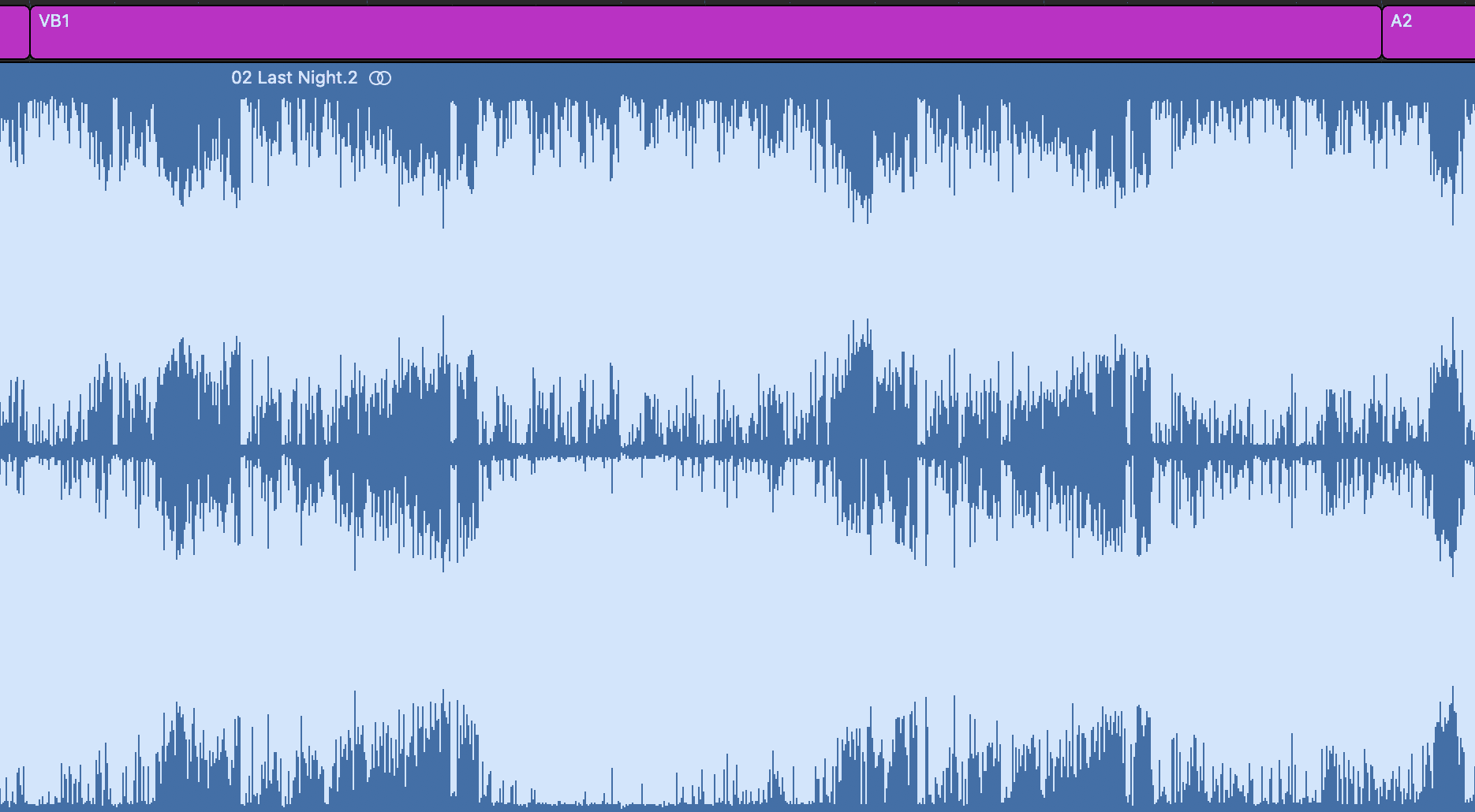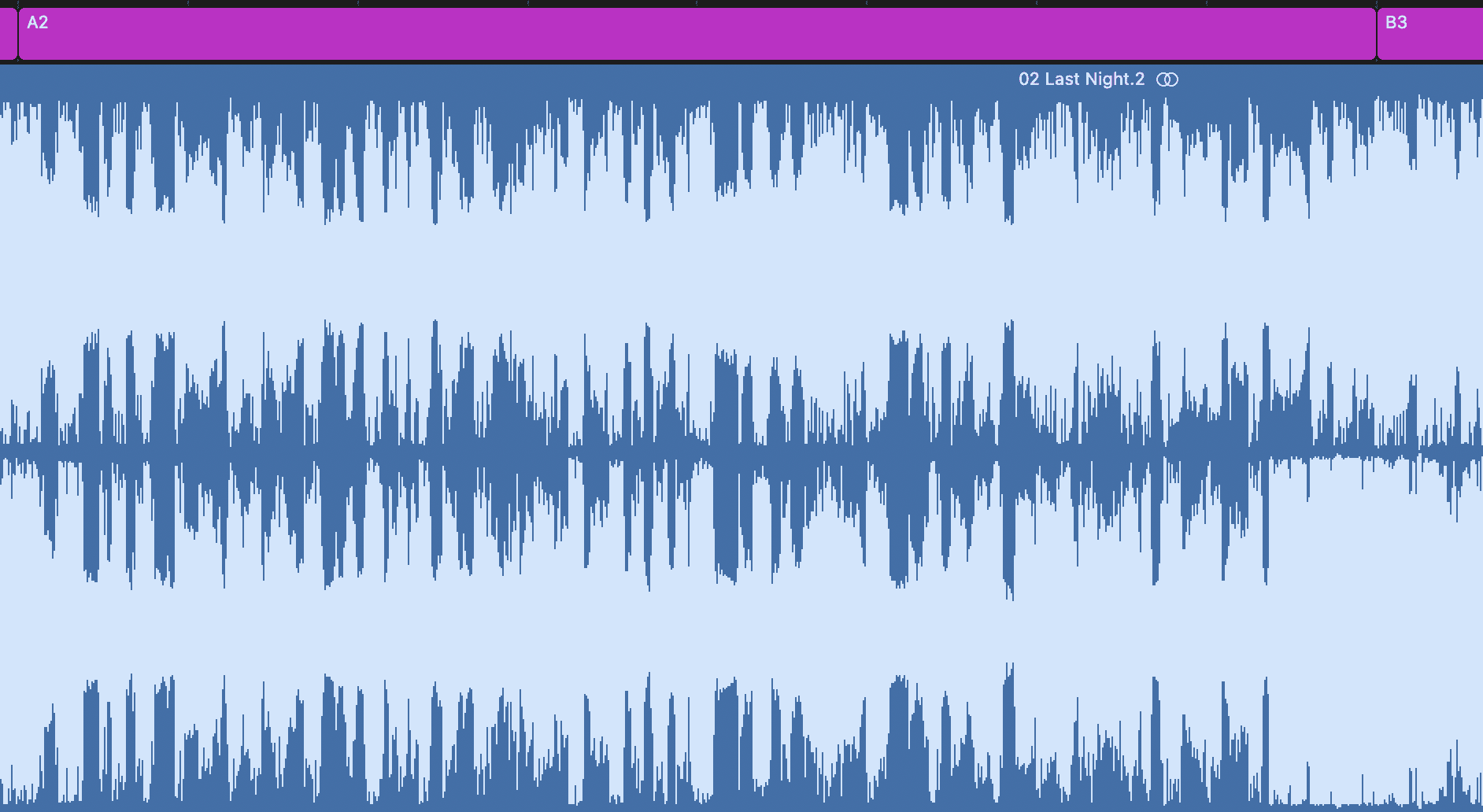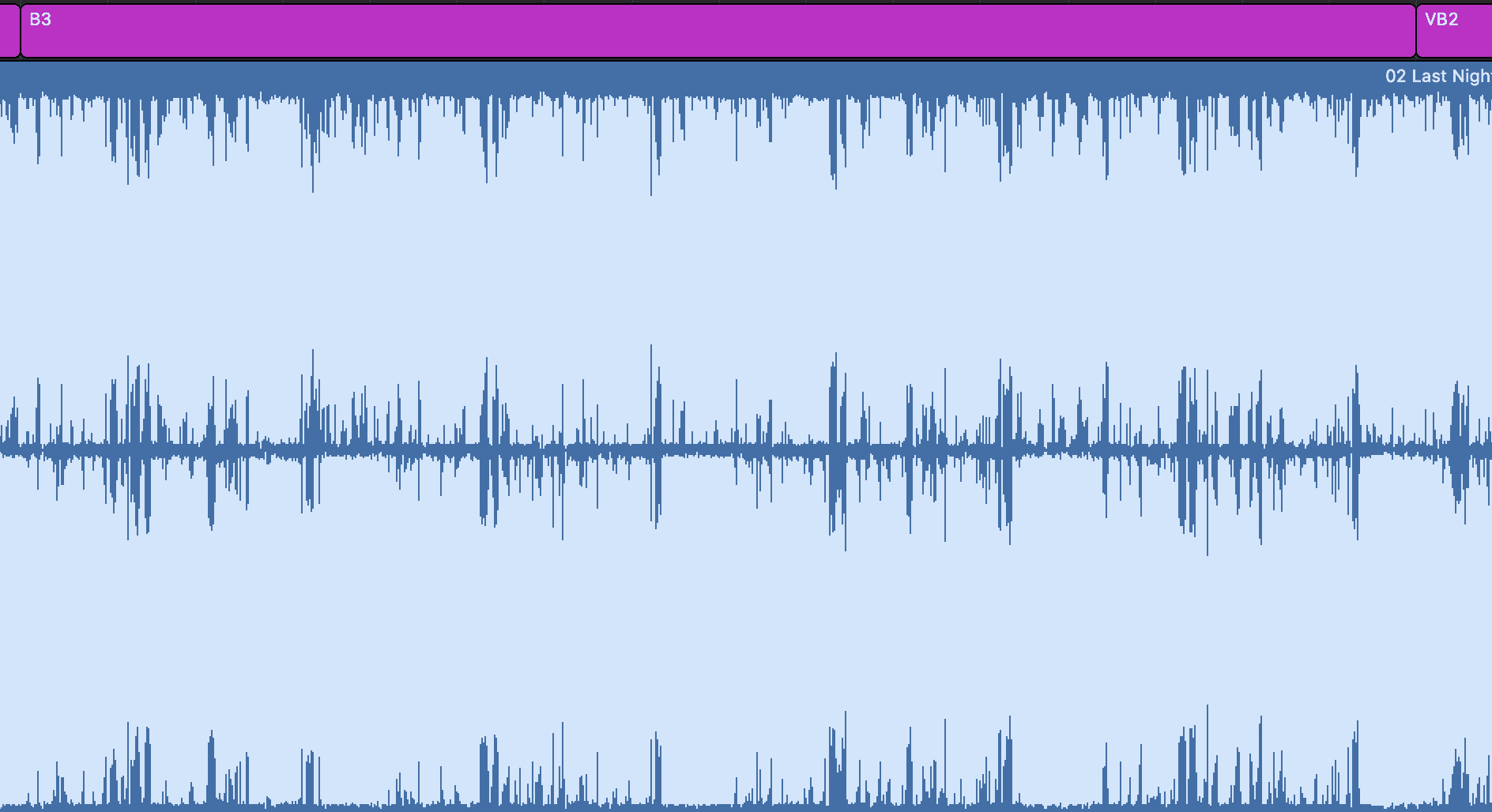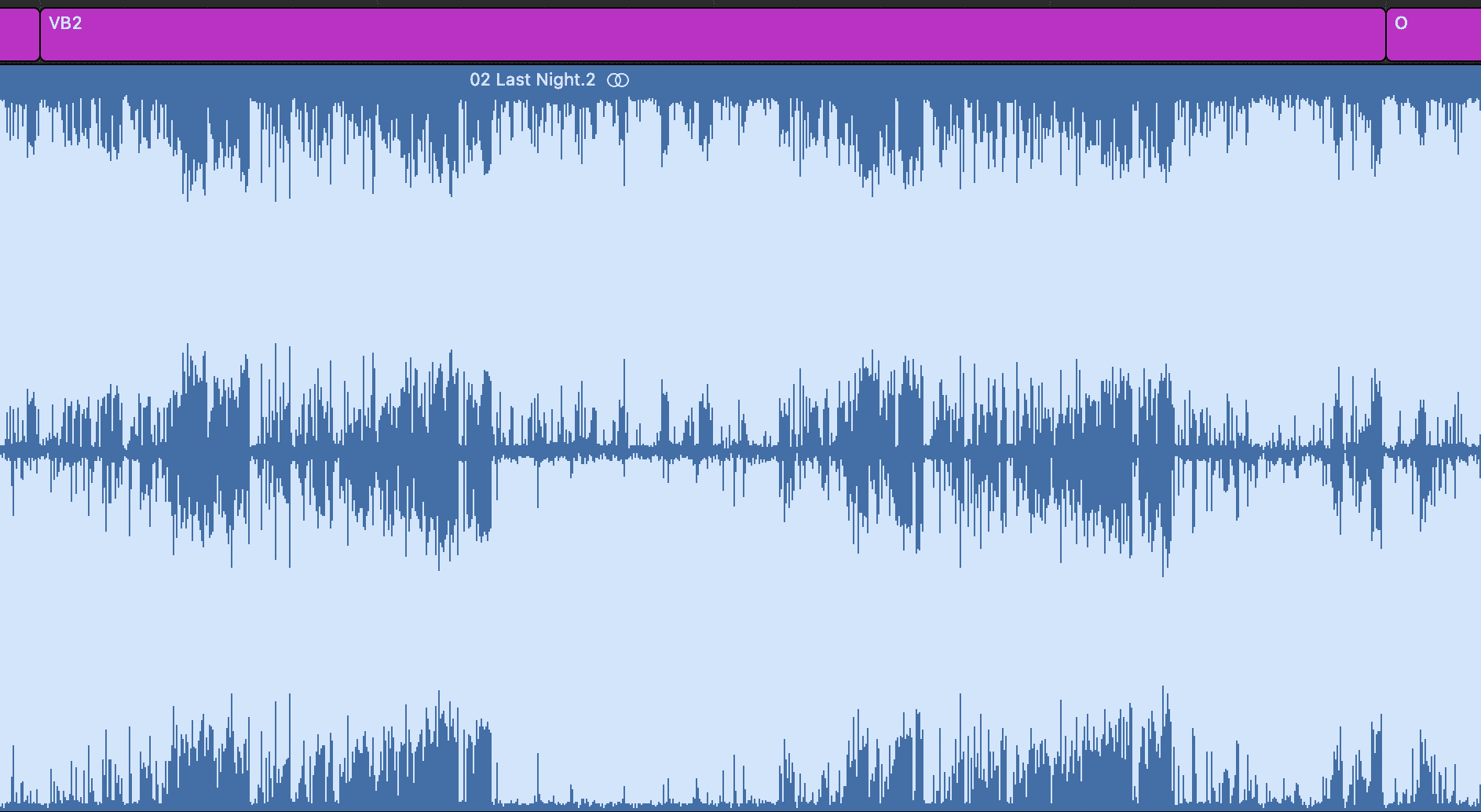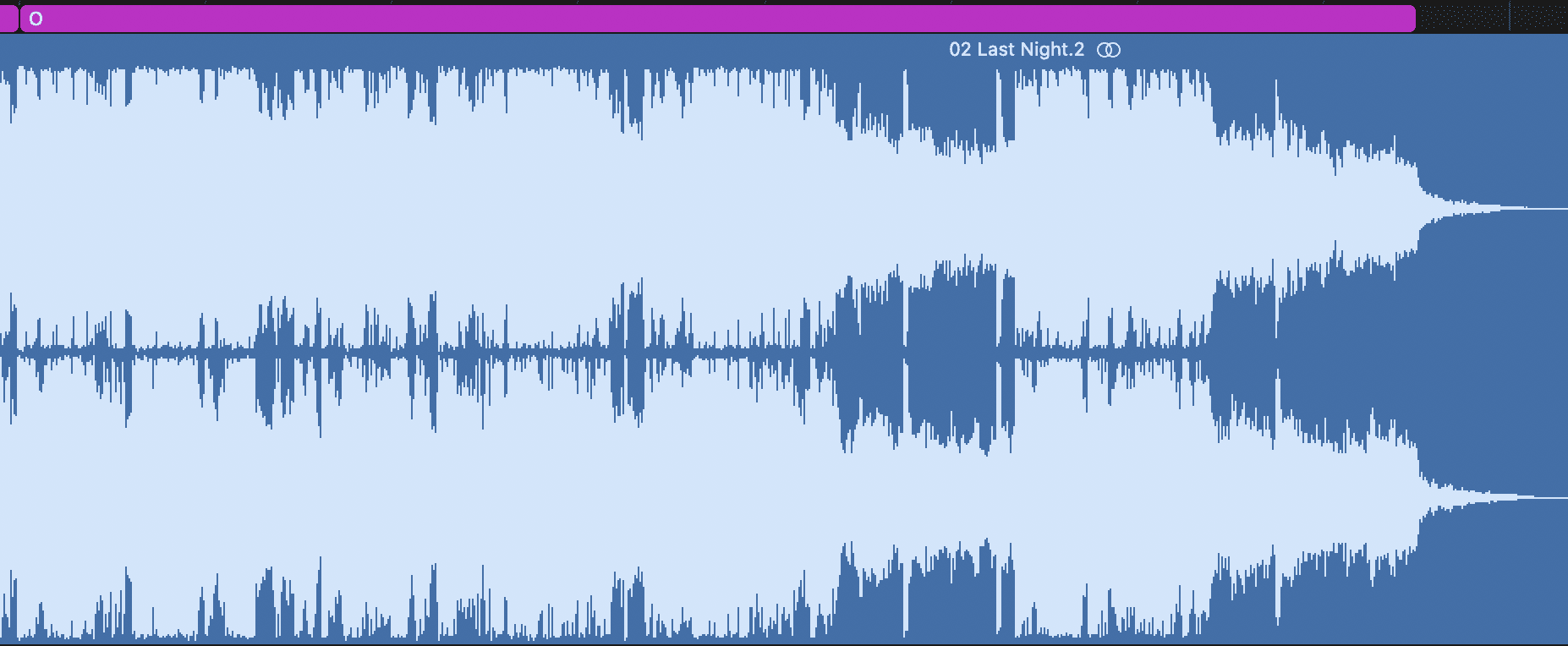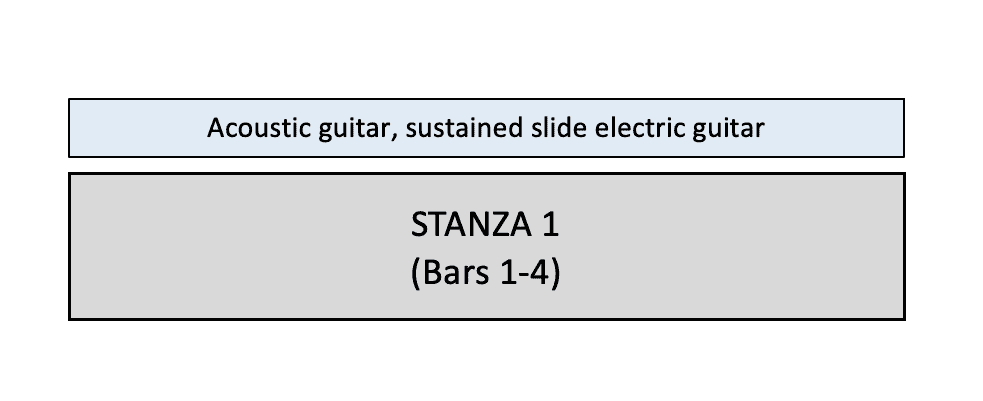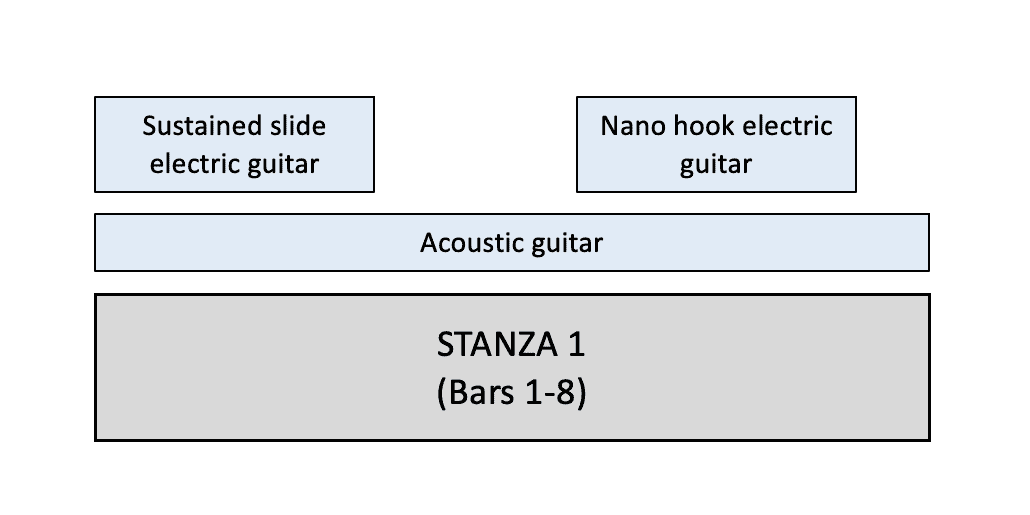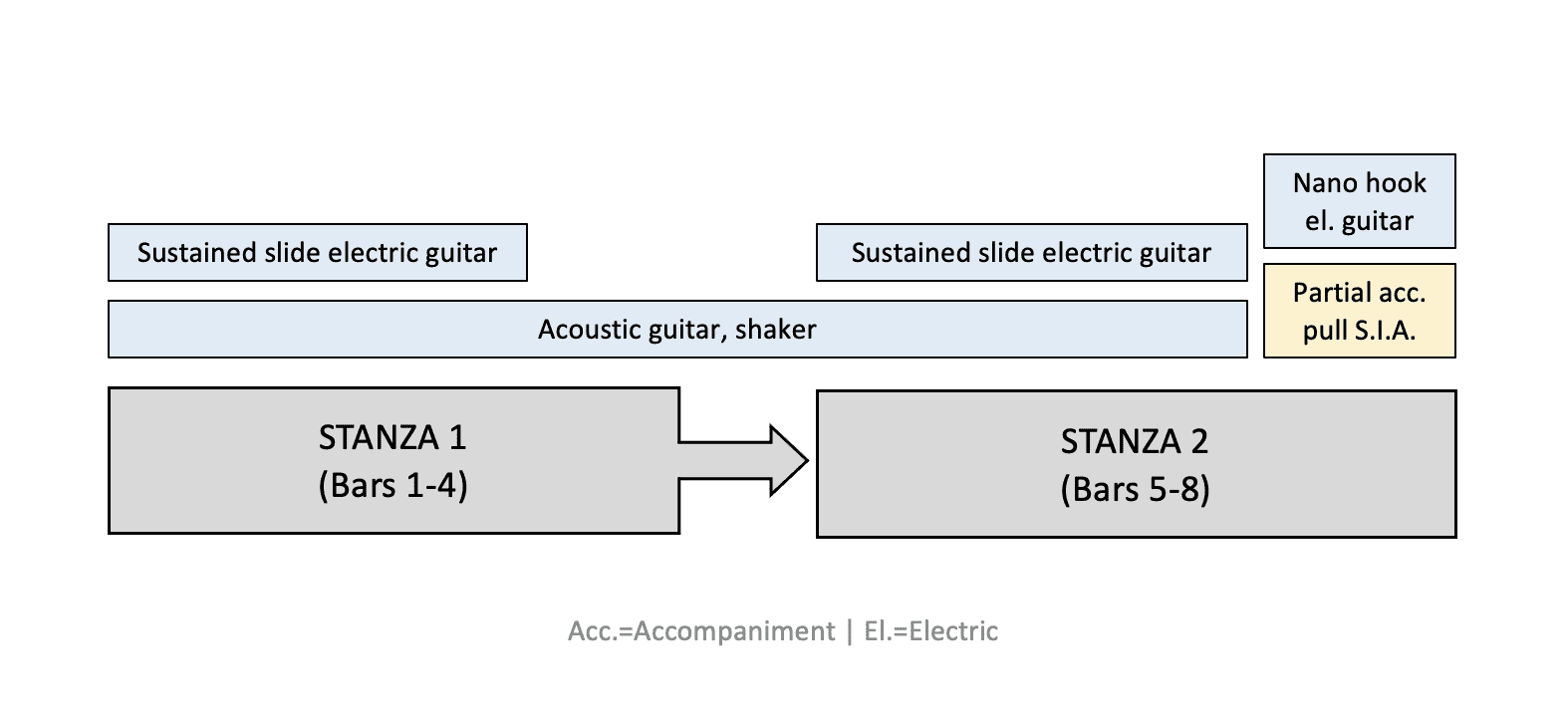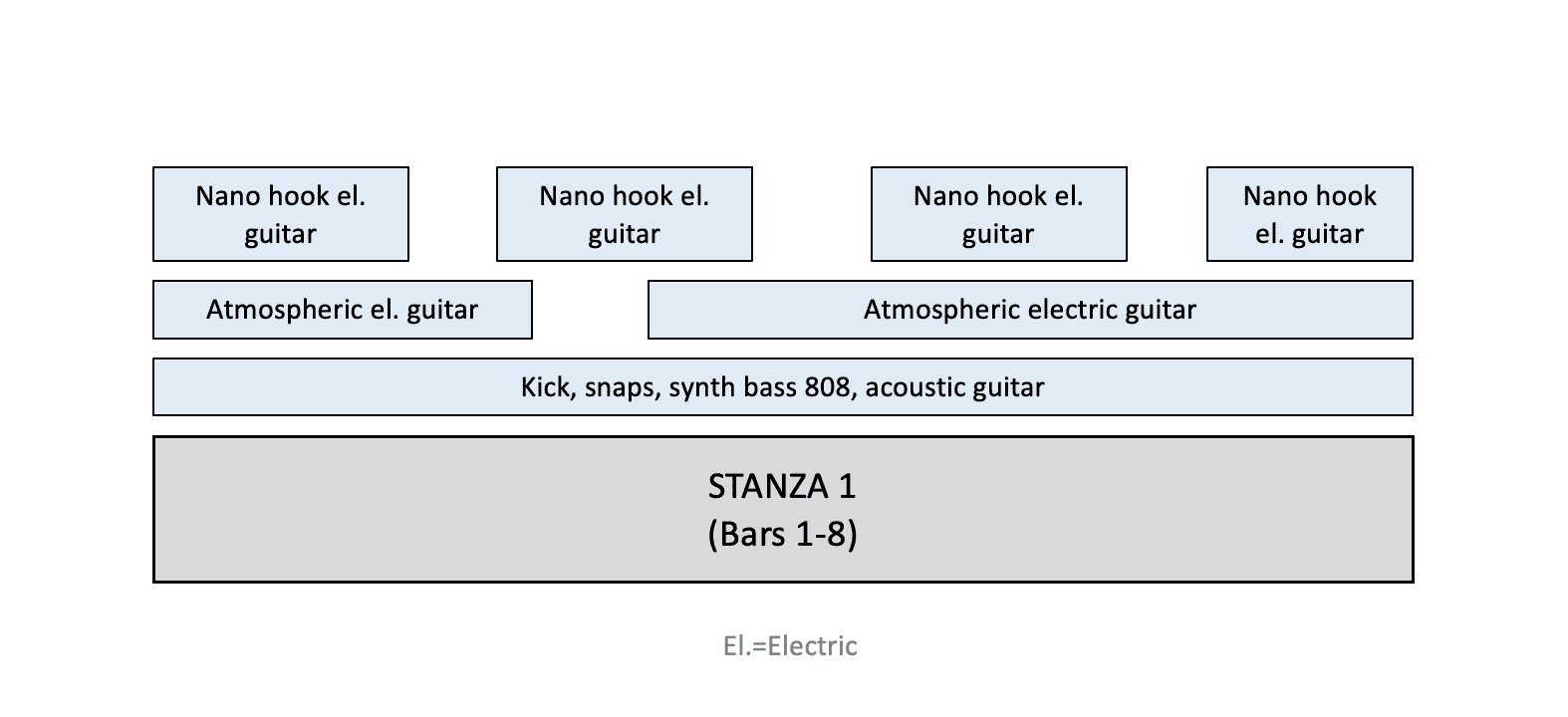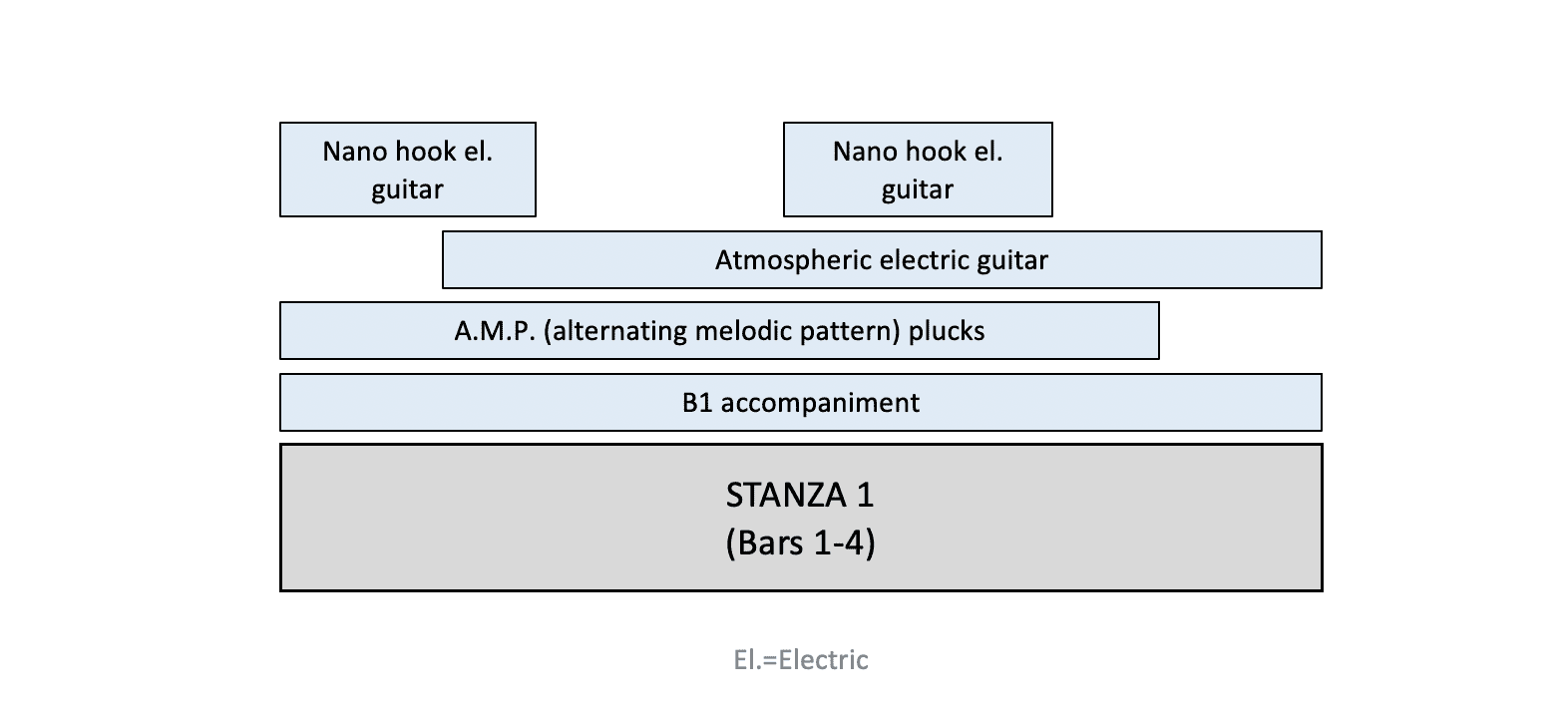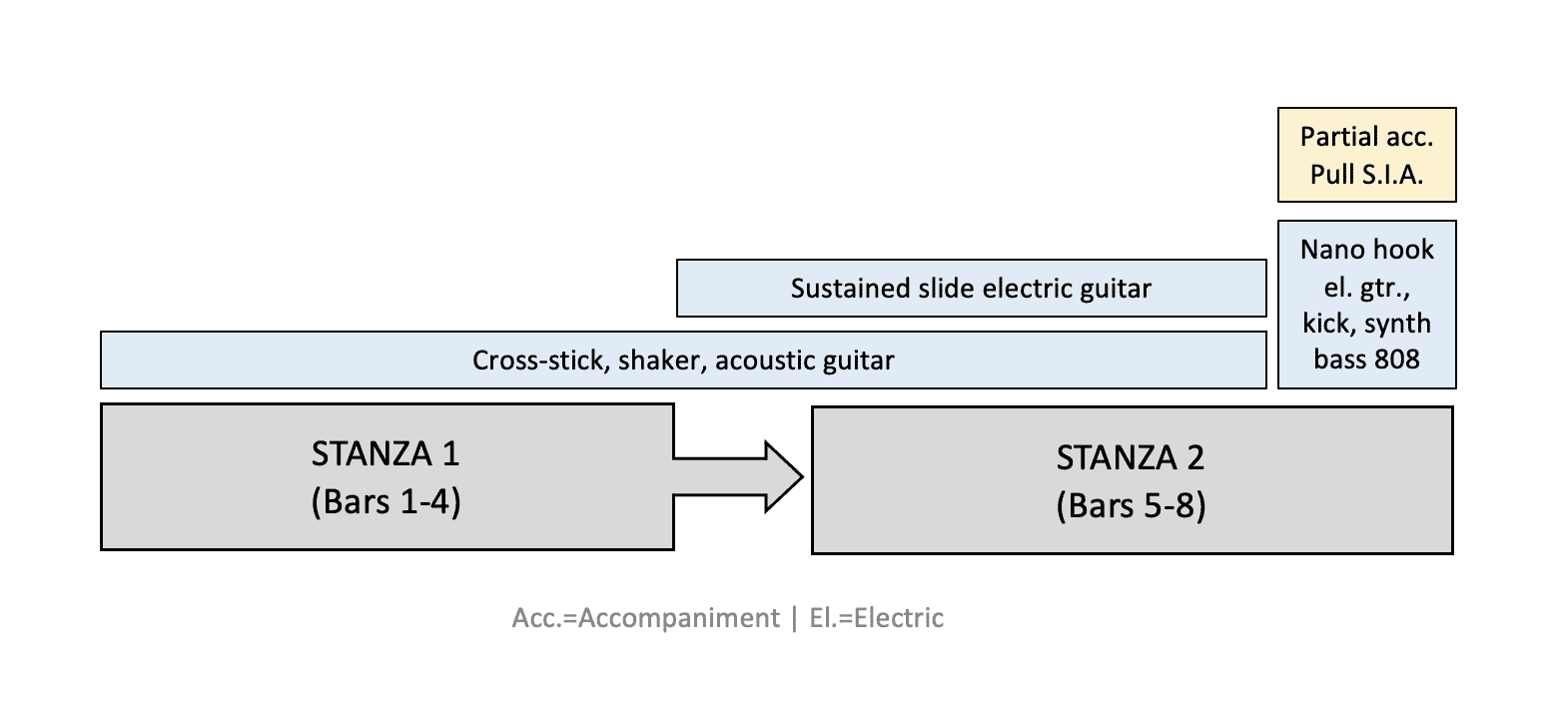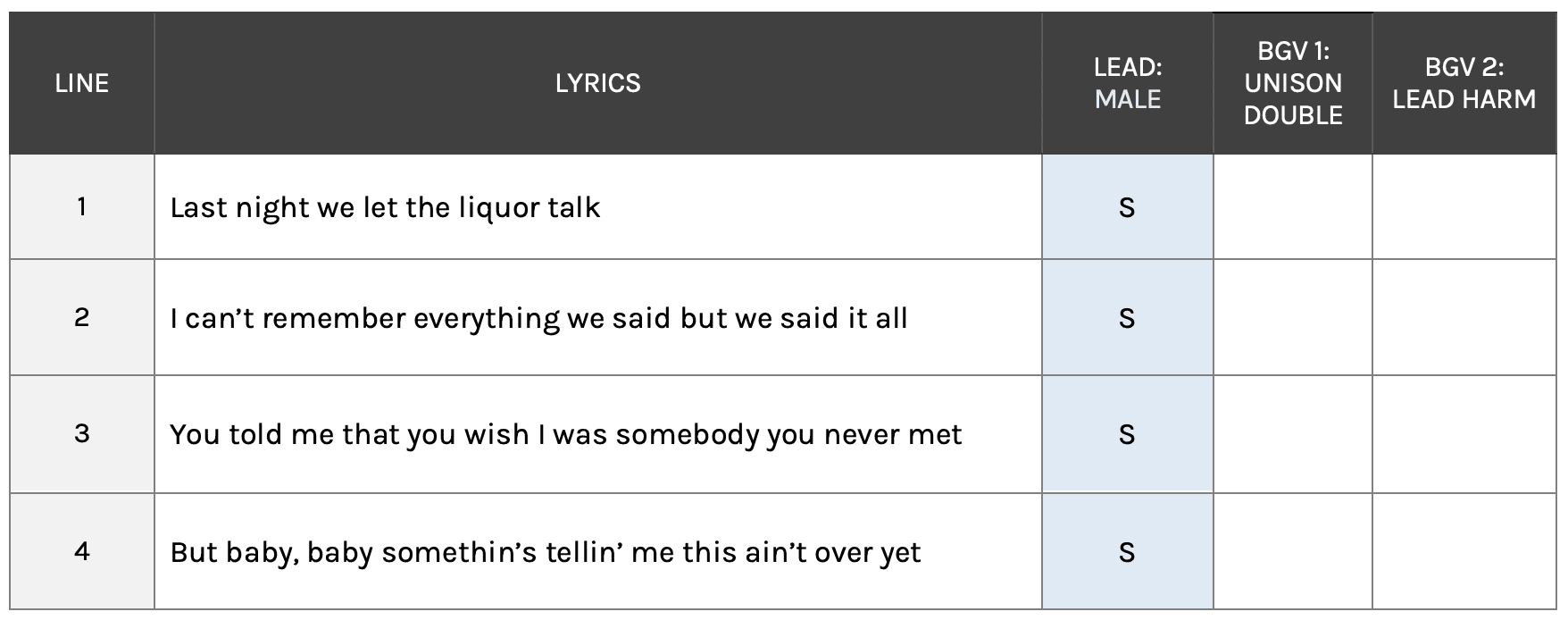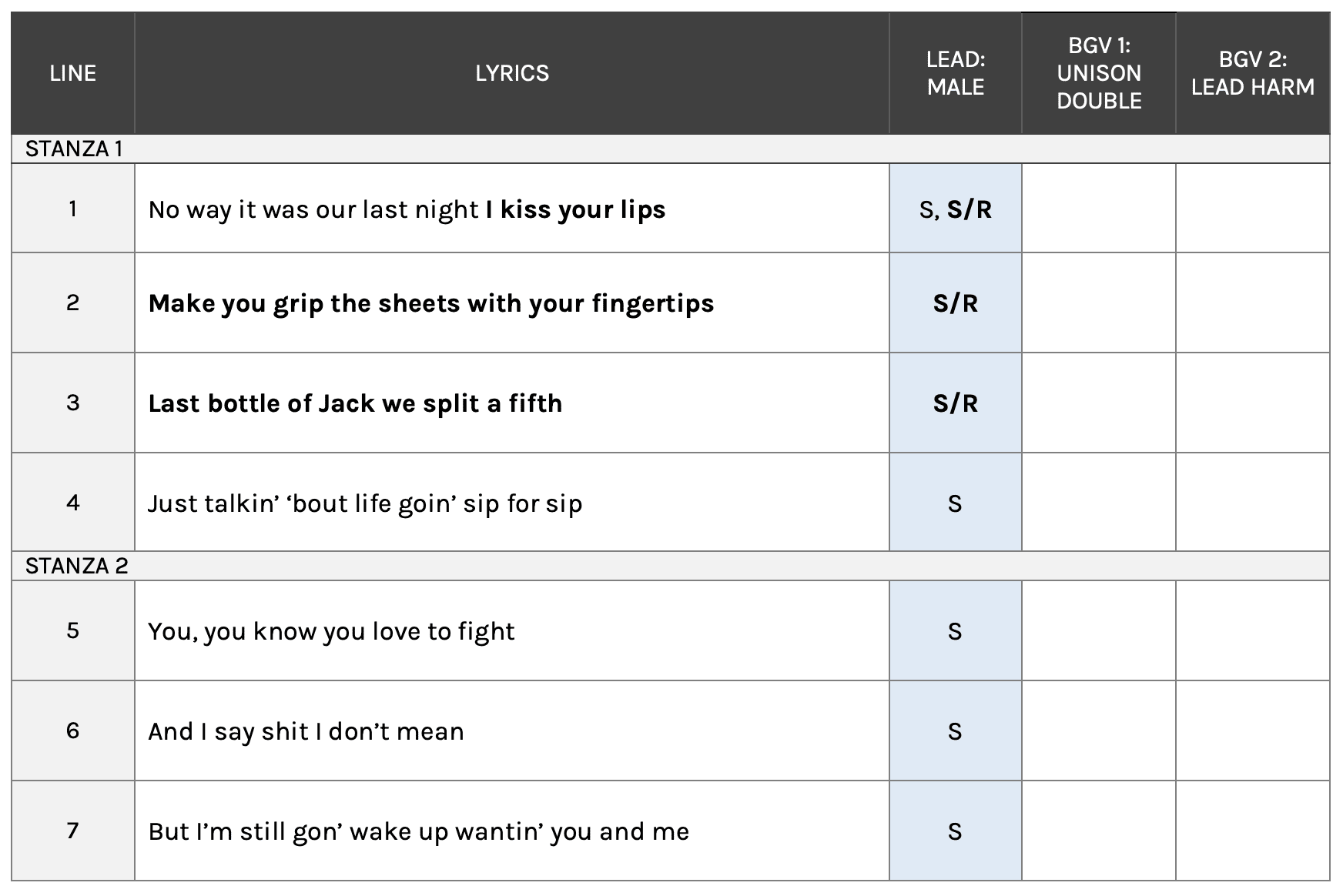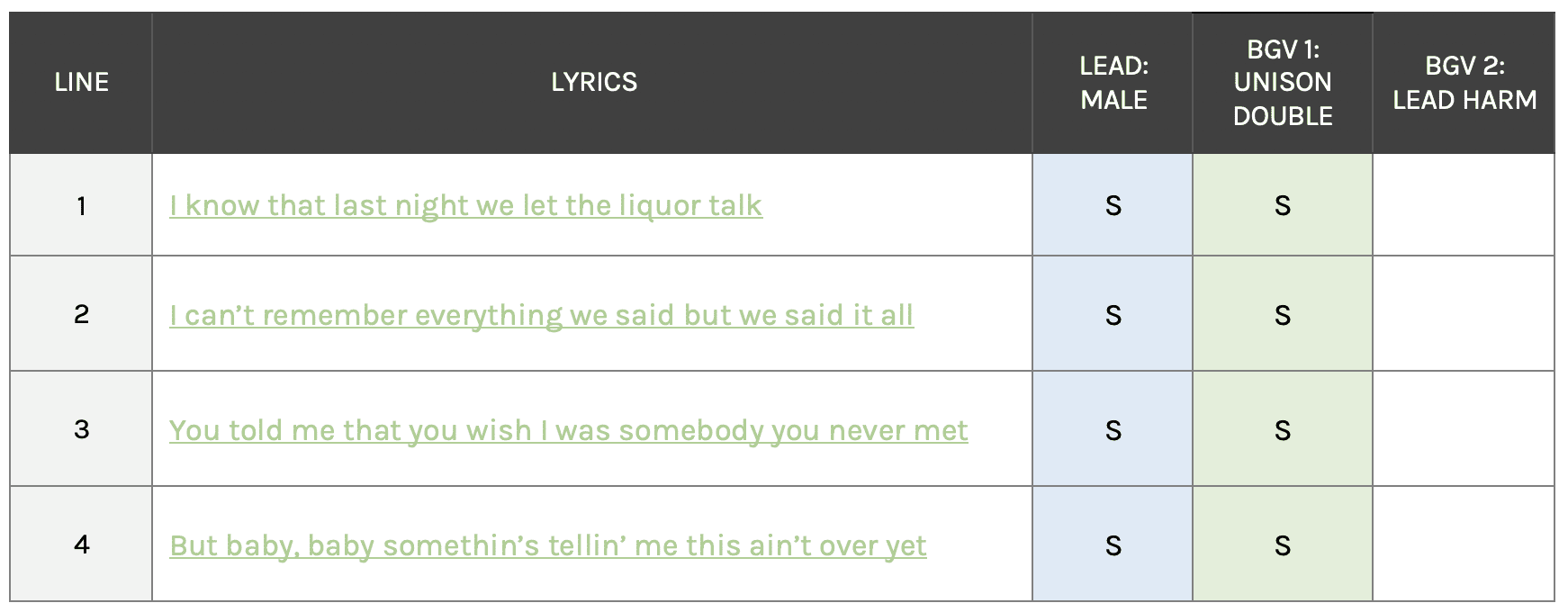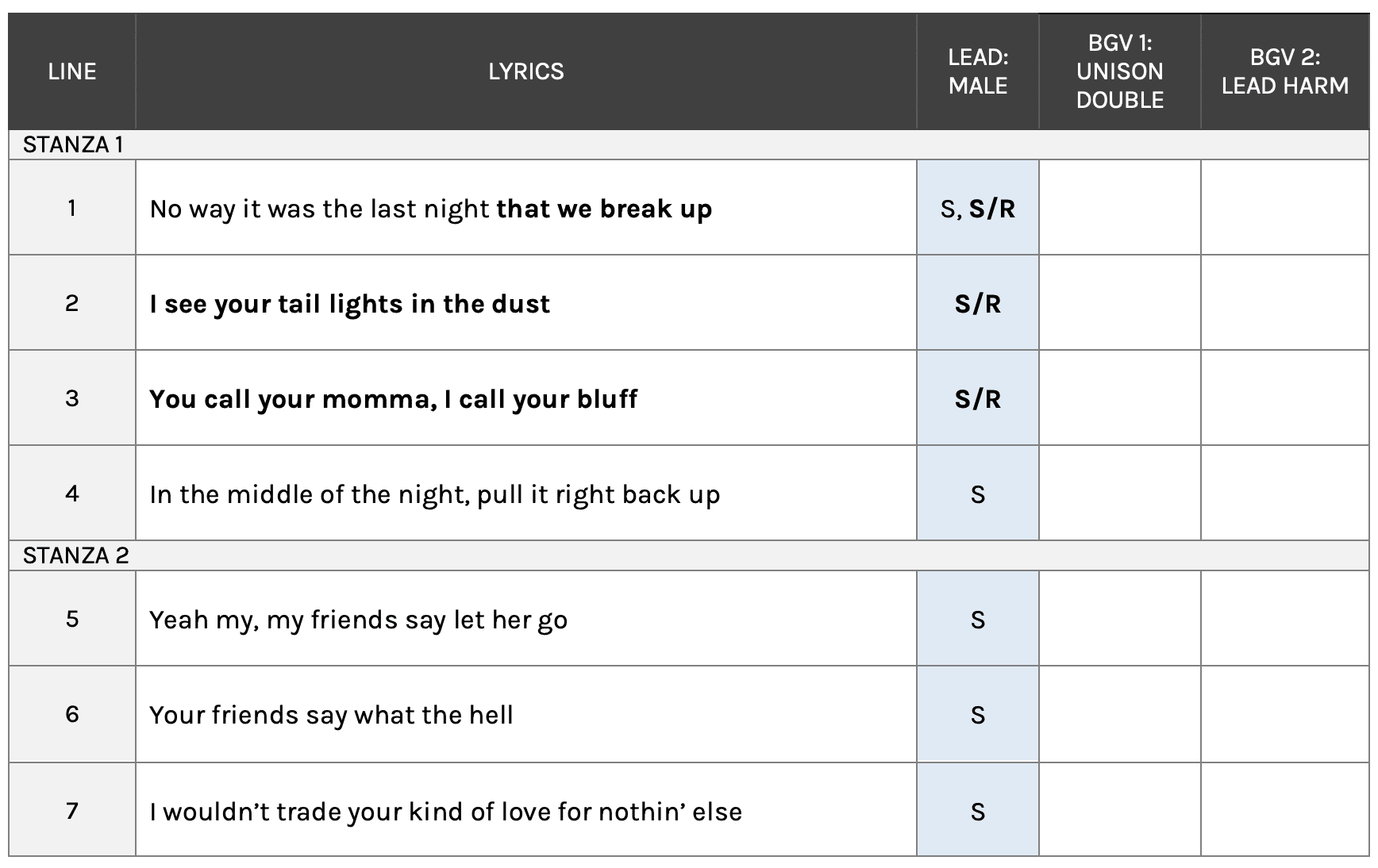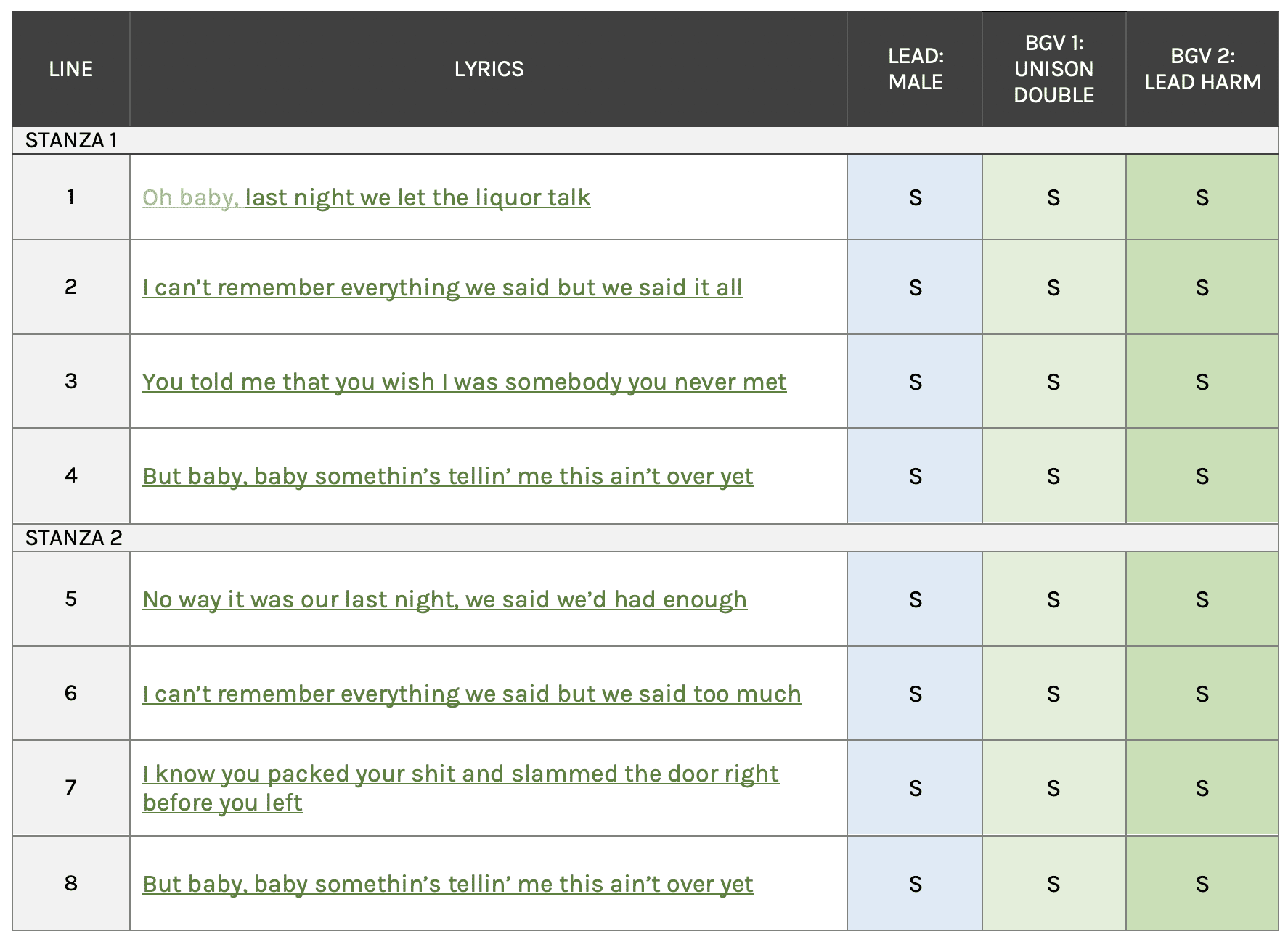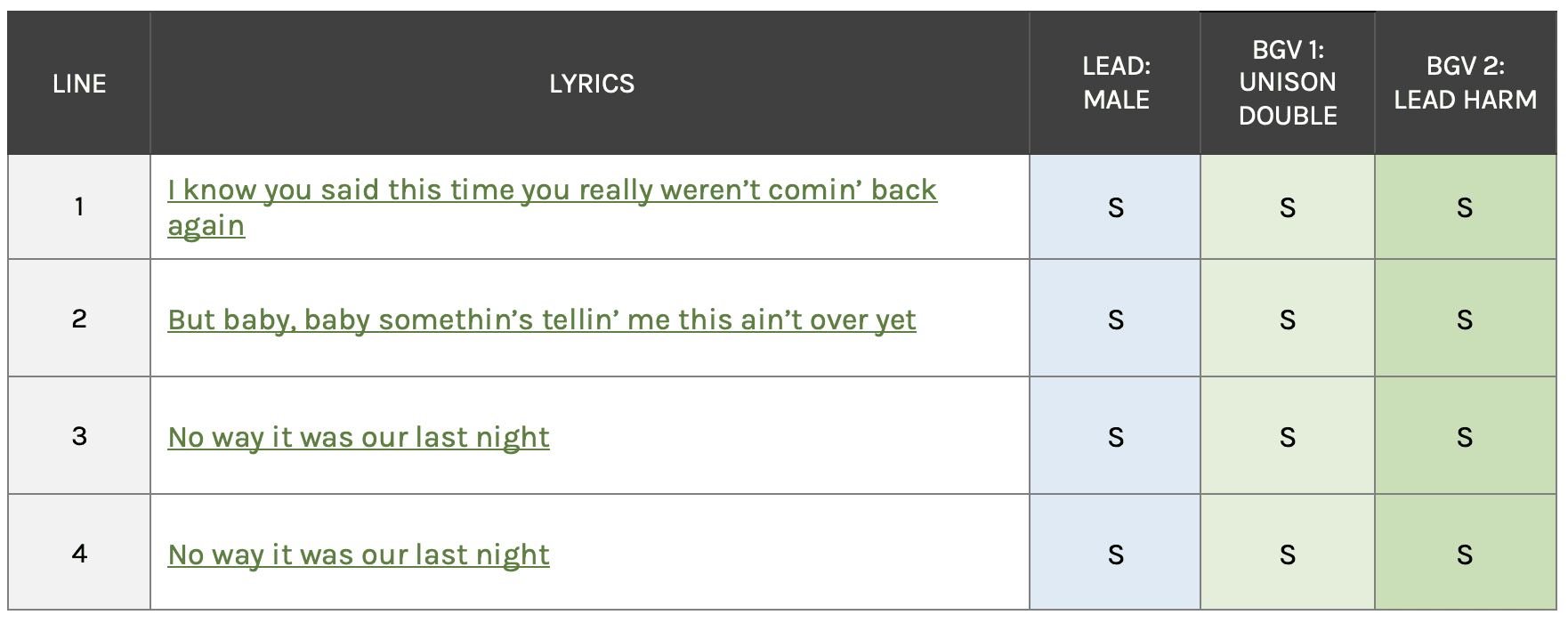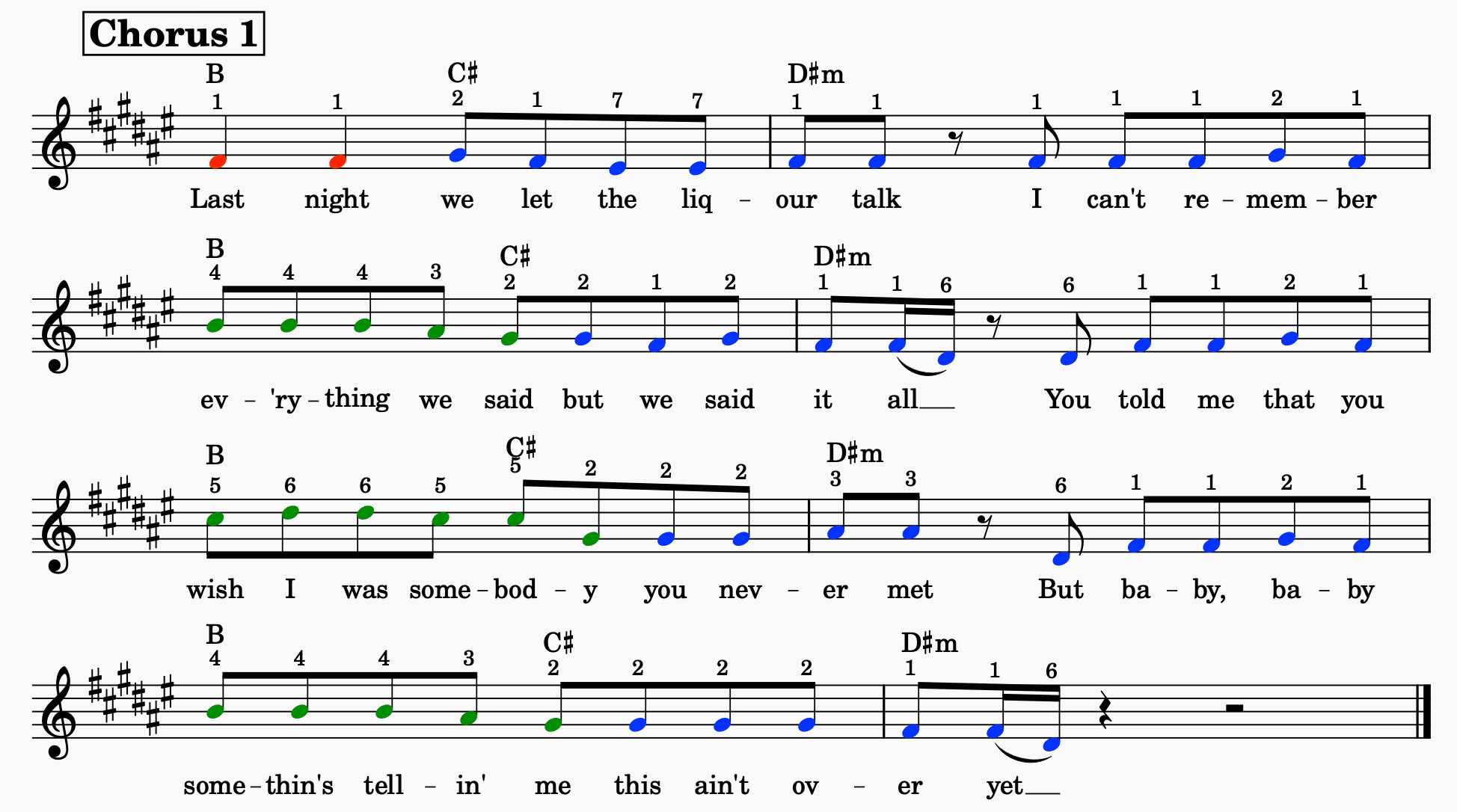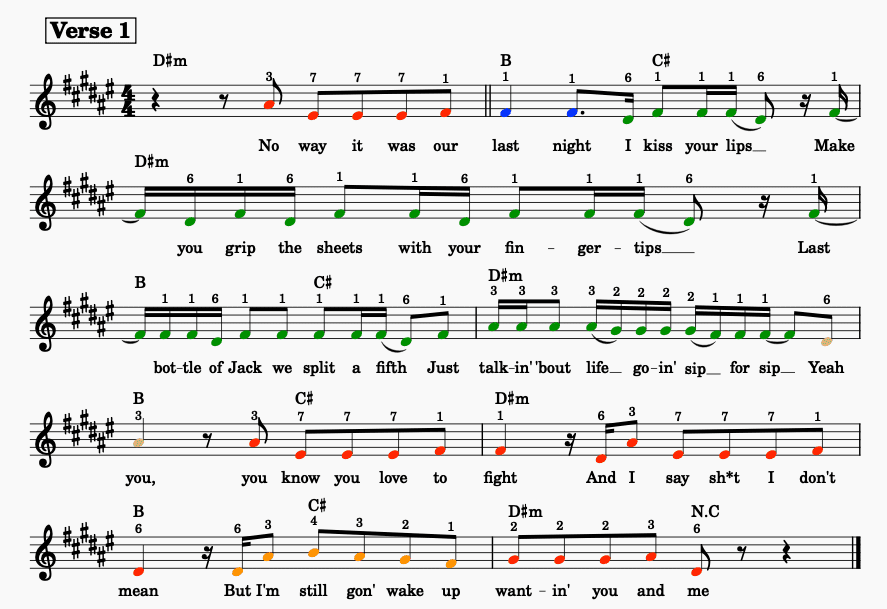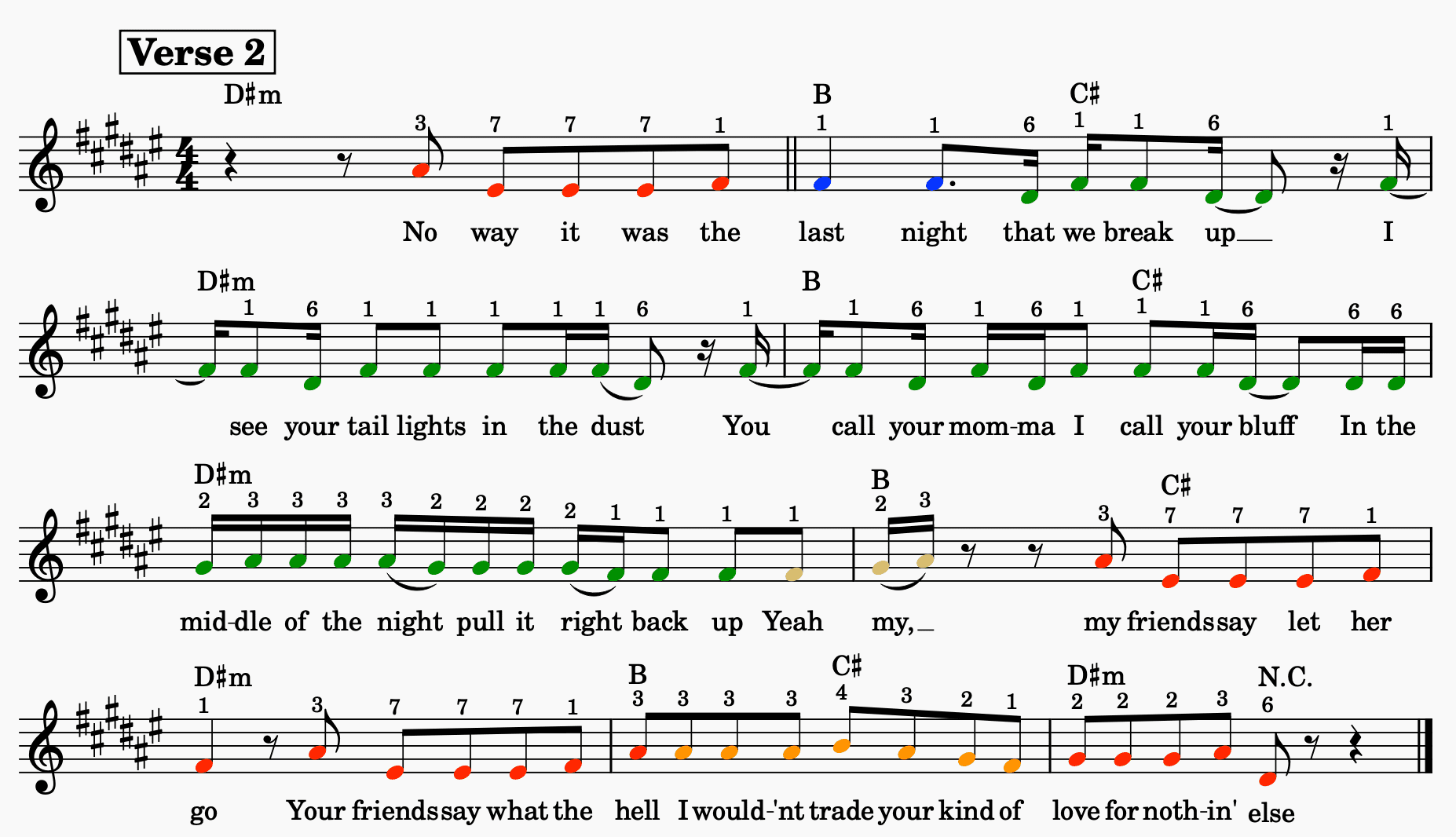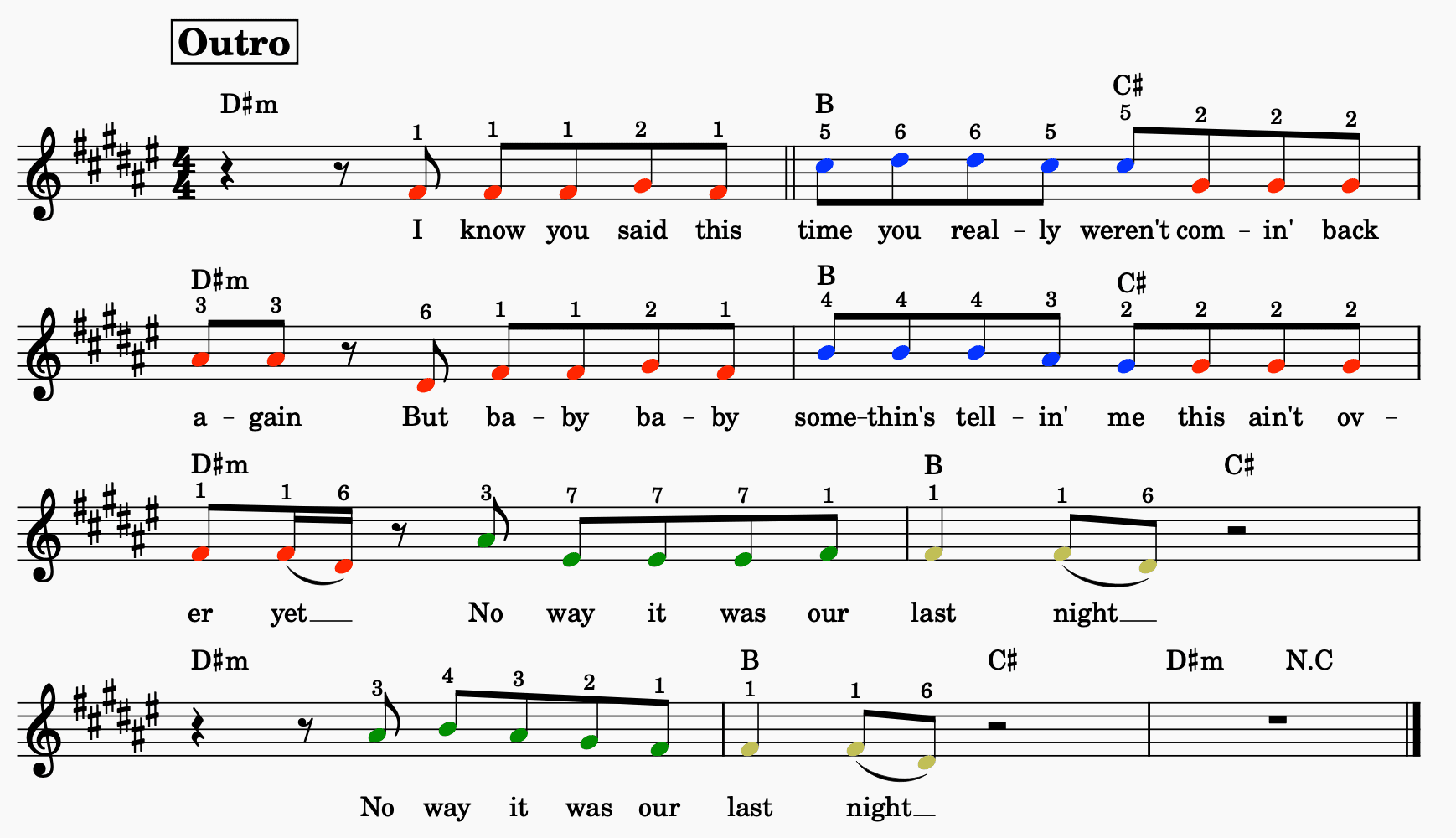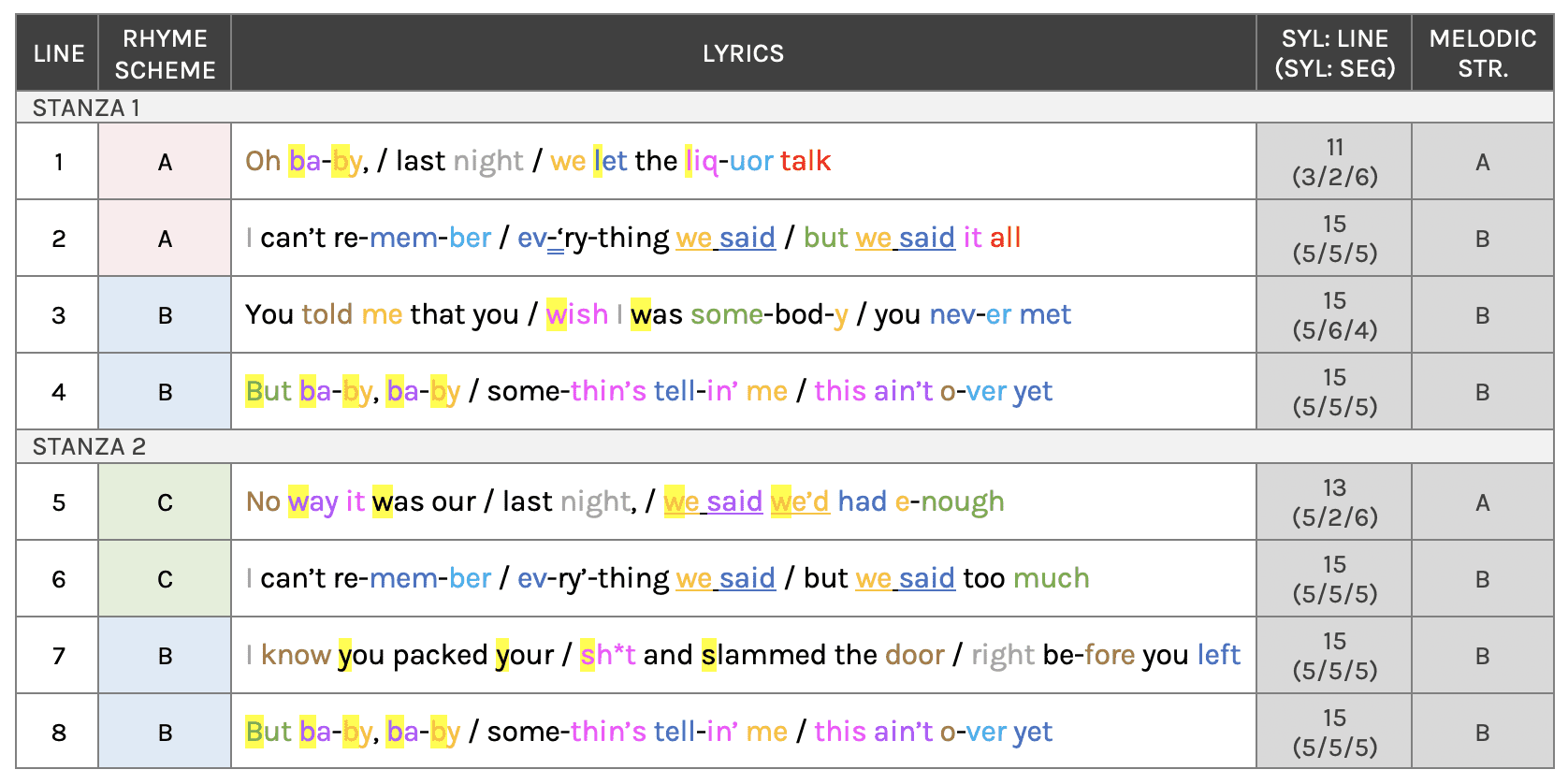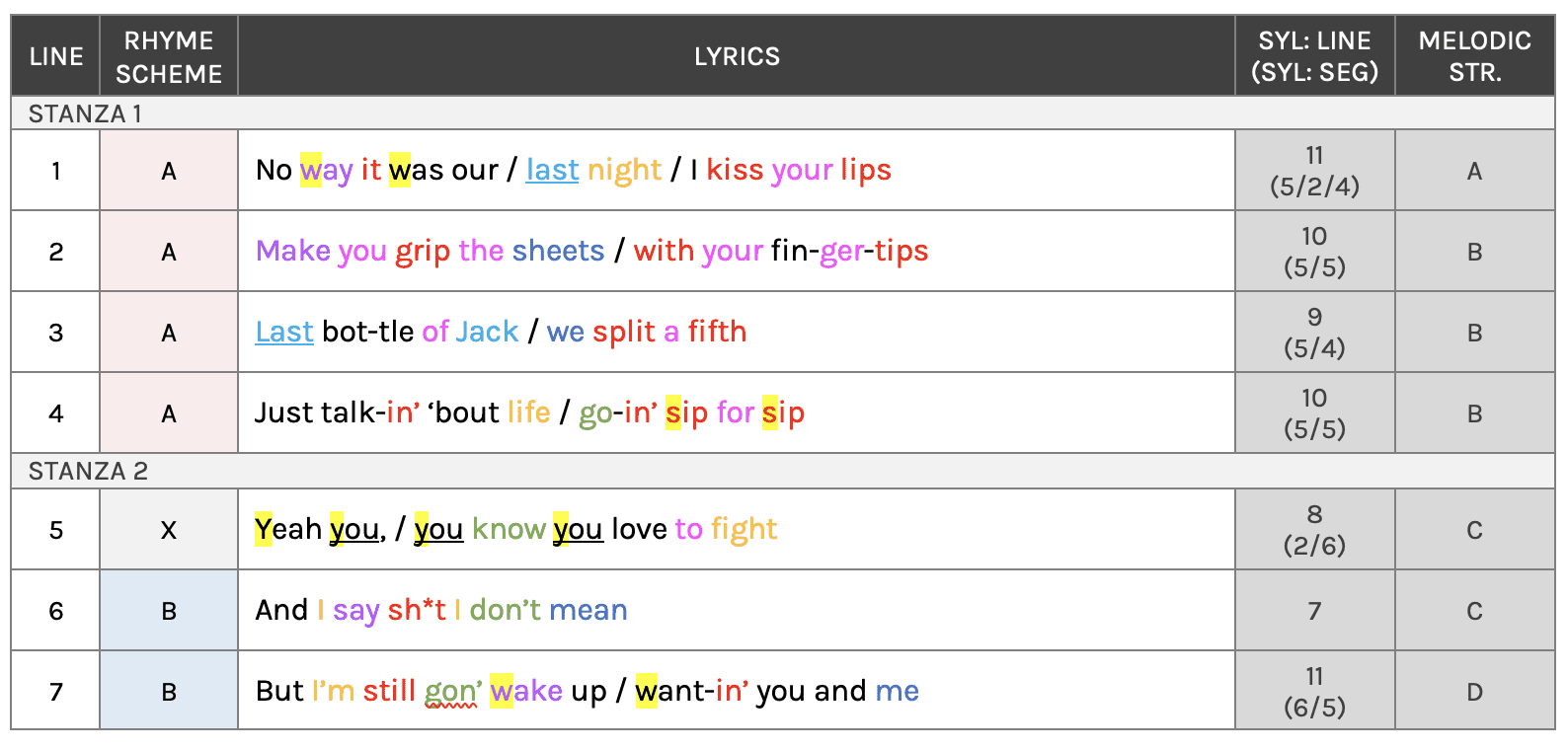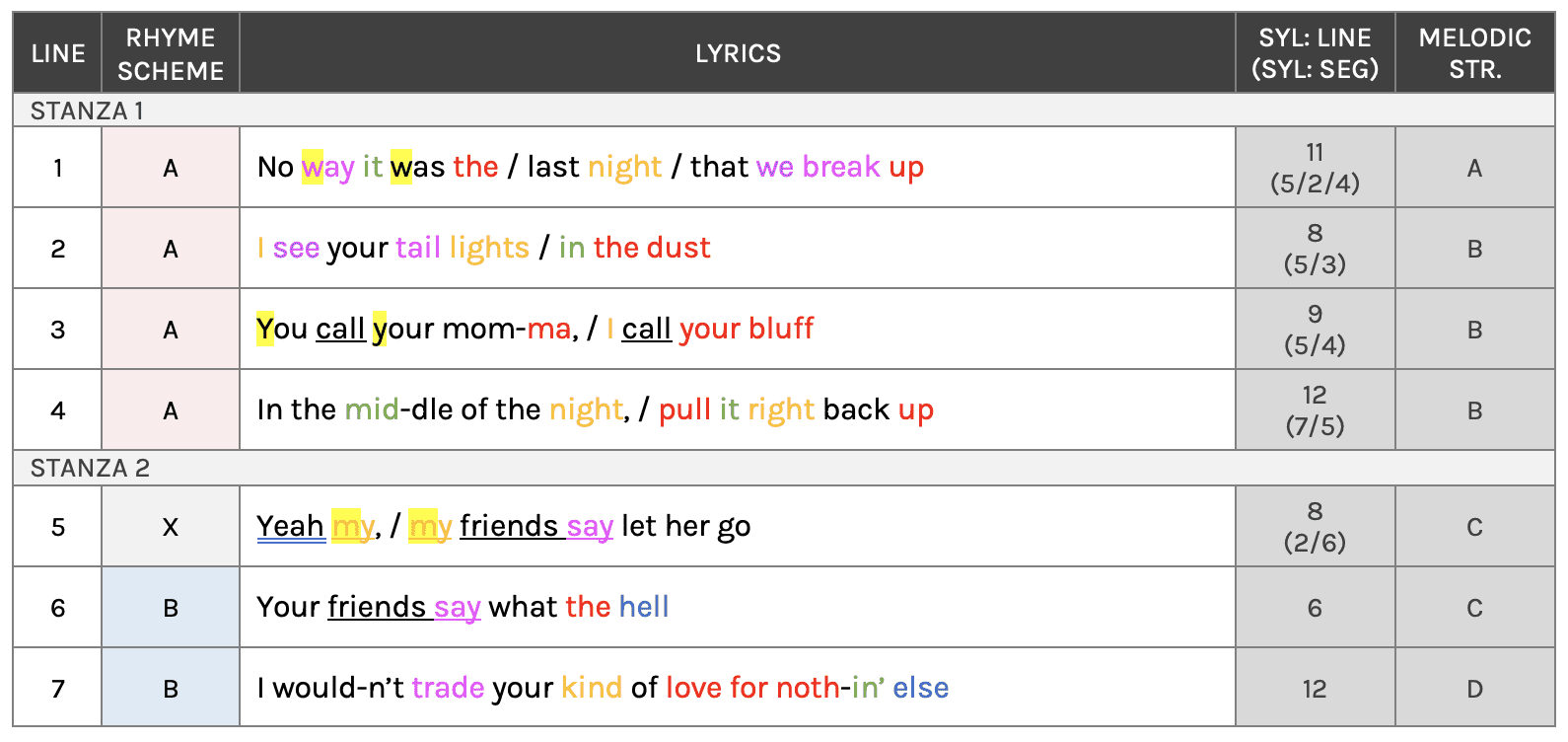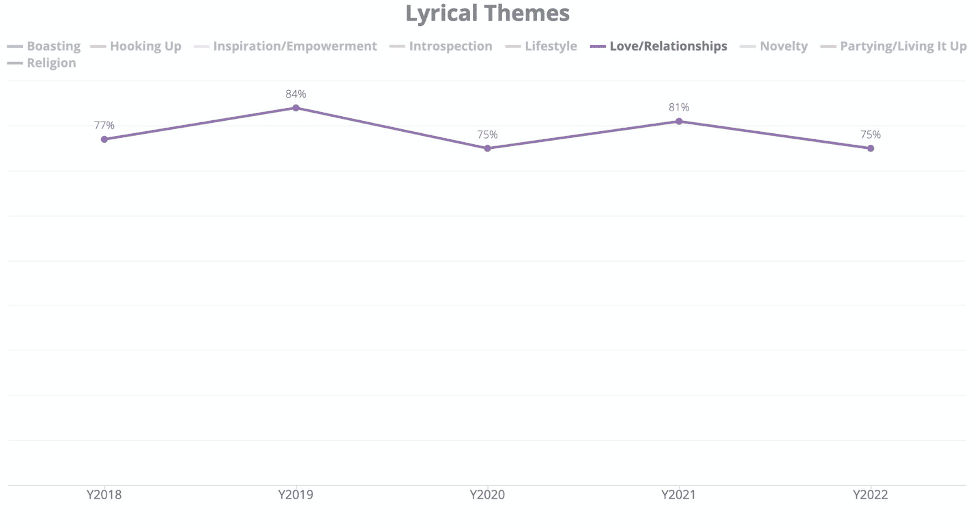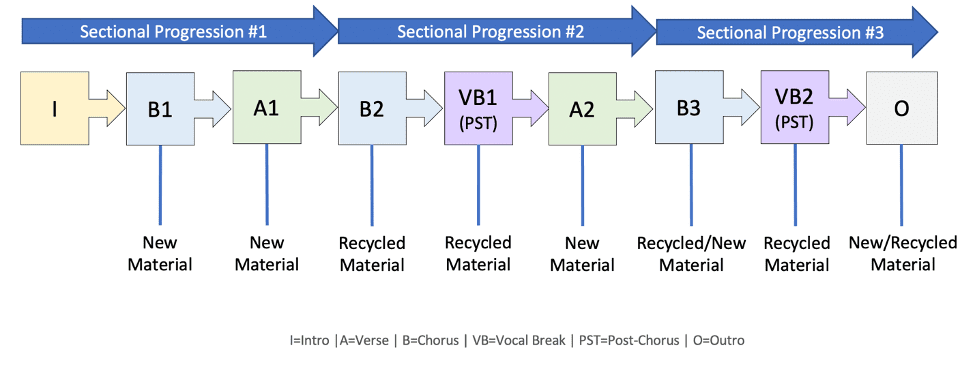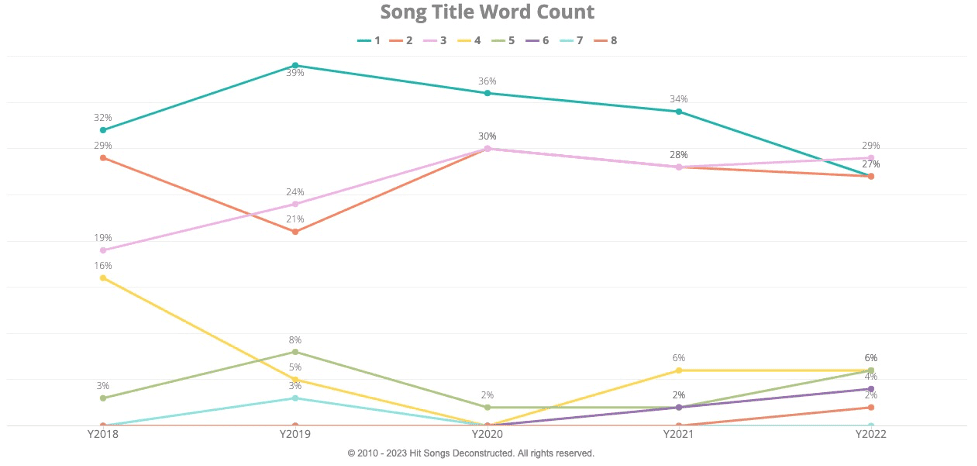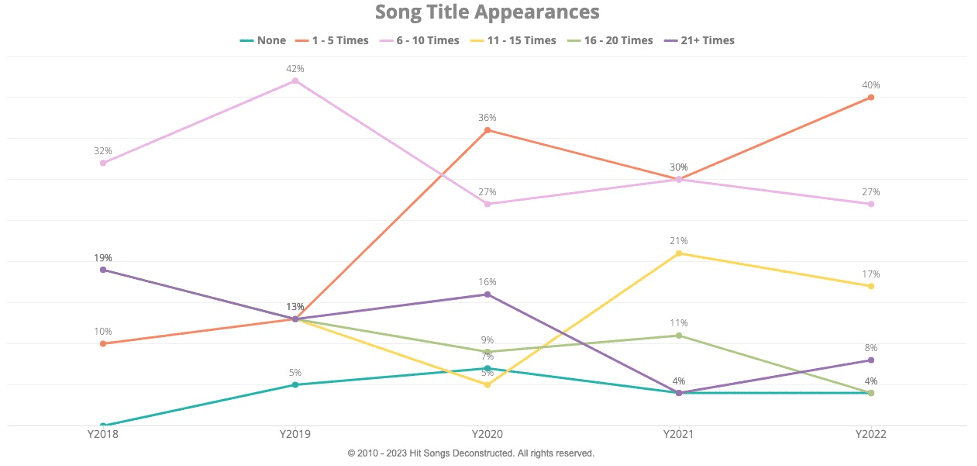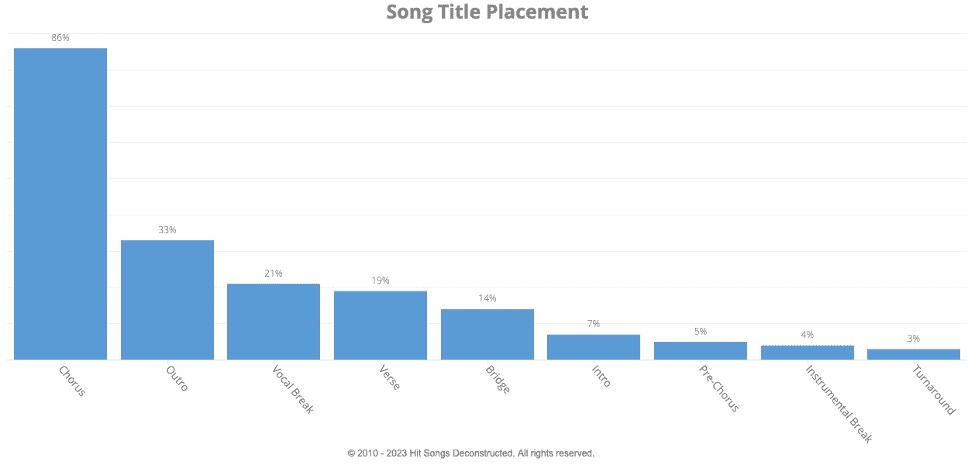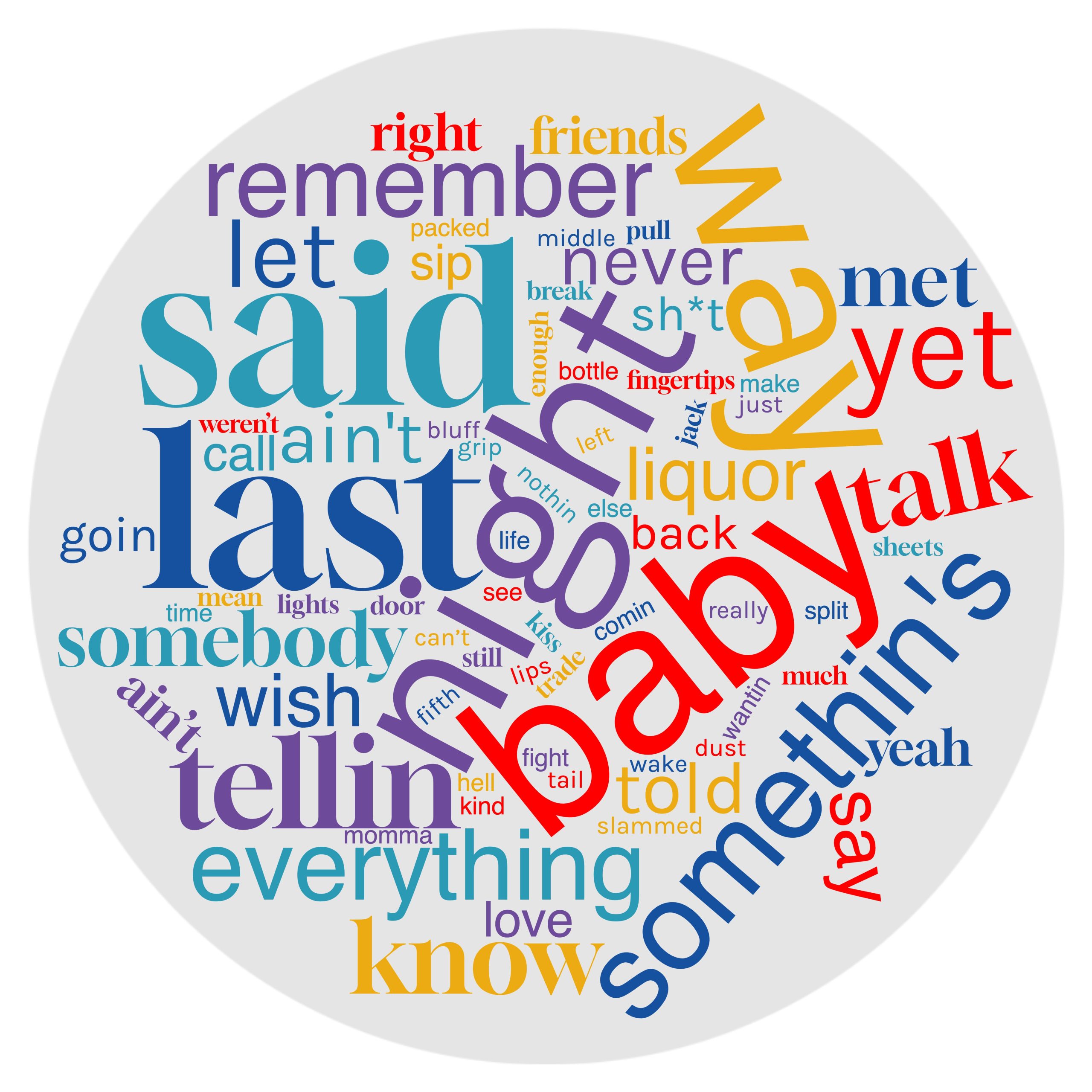

Morgan Wallen
Last Night’s success is a result of the individual strengths and collaborative efforts of the writers and producers, along with Wallen’s ability to bring it to life. Together, they effectively balanced traditional country with mainstream pop and hip hop, connecting and resonating with a wide fan base while at the same time staying true to Wallen’s overall body of work.
In addition to the Hot 100, Last Night has also reached the top spot on the Australia ARIA and Country Hot 50 charts, the Billboard Country Airplay and Hot Country Songs charts, and cracked the Top 10 on the Billboard Mainstream Top 40 chart.
In this report, we take a deep dive into the song’s structure, genres & influences, instrumentation & arrangement, vocal melody & production, lyrics & rhymes, hooks, and more.
At-A-Glance
Artist: Morgan Wallen
Song: Last Night
Songwriters: Ashley Gorley, Charlie Handsome, Jacob Kasher, John Byron
Producers: Charlie Handsome, Joey Moi
Mastering Engineer: Ted Jensen
Mixer: Joey Moi
Record Label: Republic
Primary Genre: Country
Influences: Country, Hip Hop/Rap, Pop, Rock
Length: 2:39
Form: I-B-A-B-VB-A-B-VB-O
Key: F# Major
Tempo: 102 BPM
First Chorus: 0:09 / 6% of the way into the song
Intro Length: 0:09
Electronic vs. Acoustic Instrumentation: Electronic/Acoustic Combo
Prominent Instruments: Bass (Synth), Guitar (Acoustic), Guitar (Electric), Snaps
Primary Lyrical Themes: Love/Relationships
Title Appearances: Last Night appears 12 times in the song
Overview, Highlights & Takeaways
Hooks
I = Intro | A = Verse | B = Chorus | VB = Vocal Break | PST = Post-Chorus | “D” = Departure | O = Outro
Number: Denotes the number of times that a particular hook/motif appears within a section
Vocal Hooks
Song Title Hook
Last Night’s main vocal hook is “no way it was our last night,” appearing in the verses, vocal break post-choruses and outro. At its core is K.I.S.S. ME (keep it simple, singable and memorable) construction, consisting mainly of a stepwise and stagnant eighth and quarter-note driven pattern within a limited range.
There are two variations of the hook, each possessing similar and contrasting qualities:
- Verses: Each verse begins with the same hook melody and lyric (“no way it was the last night”) but concludes with a lyrical variation (“kiss your lips” and “we break up,” respectively). In verse 1, the hook cleverly serves to both summarize the preceding chorus and kick off the ensuing verse development. In verse 2, it does the same but following the vocal break post-chorus.
- Vocal Break Post-Choruses & Outro: Following choruses 2 and 3, the vocal break post-choruses feature two back-to-back repetitions of the song title hook. While the first iteration features the same melody heard at the top of the verse sections, the second iteration features a subtle melodic variation that heightens interest and the emotion of the lyric. This same pattern repeats at the end of the outro, bringing the song to a conclusion on a familiar and memorable note, while the new context helps to maintain interest
Instrumental Hooks
Foundational Instrumental Hook
Last Night’s foundational hook is an arpeggiated acoustic guitar pattern featured throughout the song. Its heard most notably in the intro’s sparse arrangement, where it serves to establish the song’s laid back country influence while functioning as an instantly recognizable calling card. It is then reinforced in each subsequent section in varying degrees of prominence, serving as a cohesive thread underneath Wallen’s vocals.
Nano Hook
The electric guitar nano hook performs a brief, atmospheric, country-influenced lick in every section save for the intro, first chorus and outro. It is strategically placed throughout the song, functioning in a transitional manner leading into choruses 2 and 3 and at the midway point within chorus stanzas, where it serves as a subtle, catchy embellishment.
Creative Hook Foreshadowing & Reinforcement
Song Title Hook Reinforcement
The “no way it was our last night” song title hook is melodically reinforced across the last three lines of both verse sections. The first two iterations (3-7-7-7-1) are melodically similar to the hook’s first appearance at the top of the verse, vocal break post-choruses and outro. The last iteration (3-4-3-2-1) is similar to the hook’s second appearance in the vocal break post-choruses and outro. The melody’s new lyrics and context helps to keep things interesting as the song progresses while further ingraining the all-important hook in the listener’s head – albeit in a clever, under-the-radar manner.
Nano Hook Fragment
Fragments of the electric guitar nano hook are heard in each chorus and the outro. In chorus 1, it serves to subtly foreshadow the full hook that makes its first appearance at the end of verse 1 leading into chorus 2. Subsequent iterations serve as familiar embellishments while preventing the full hook from becoming overly redundant.
Genres & Influences: Overview
Last Night features a combination of country, pop, hip hop/rap and rock influences that are put into effect by the qualities of the vocals, instruments, lyrics, and the overall production.
Key
X: The influence appears prominently within the stanza and/or section
x: The influence appears minimally within the stanza and/or section
Instrumentation & Arrangement: Overview
Last Night’s instrumental arrangement expertly fuses modern mainstream pop and hip hop with traditional country. Along with broadening the song’s appeal and jibing with Wallen’s body of work, the timbre and patterns of the instrumentation perfectly complements the vocals and lyrics to heighten the listener’s emotional connection with the song.
Energy: Overview
In contrast to many of today’s hits, Last Night traverses through two energy level waves as opposed to three, which is due to its lack of an energy-reducing “D” section. The song features both subtle and notable energy shifts, effectively maintaining groove and vibe and calling attention to specific sections.
S.I.A. (Section Impact Accentuator) Key
Downward Yellow S.I.A.: A part of the accompaniment is removed from the mix, resulting in a brief reduction in energy
Harmony: Overview
Last Night uses one main chord progression with no significant deviations.
Progression 1
Progression 1: Variation 1a (Intro)
B – C# – D#m
Vocal Production: Overview
Lead Vocal Gender
Last Night features a solo male lead vocal from Morgan Wallen. In 2022, solo male leads among non-hip hop hits were most common, tied with solo female leads at 38% of songs.
Lead Vocal Gender in Hot 100 Top 10 (Non-Hip Hop Hits): 2018 – 2022
Lead Vocal Delivery
Last Night features a combination of sung and sung/rapped deliveries. While the song’s main “hook centers” (choruses, vocal break post-choruses and outro) are entirely sung, Wallen shifts to a more rap-styled performance in the first stanza of both verses.
Over the past five years, roughly one-fifth to one-third of non-hip hop Hot 100 Top 10 hits have featured a combination of sung and rap-styled deliveries.
Lead Vocal Delivery in Hot 100 Top 10 (Non-Hip Hop Hits): 2018 – 2022
Background Vocals
Complementing Wallen’s lead are unison and harmonizing background vocals featured exclusively in the last two choruses, post-choruses and outro. Their addition serves to heighten interest and bolster the impact of the song’s main “hook centers.”
Effects & Processing
Last Night features common hit song vocal processing, employing reverb, compression, and subtle autotune to heighten the effectiveness of the vocal performance.
Vocal Delivery Arrangement Overview
Lead: Male (Morgan Wallen): Morgan Wallen’s lead vocal
BGV 1: Male (Unison Double): Background vocal doubles in unison with the lead
BGV 2: Male (Lead Harmony): Background vocals that harmonize with the lead on different pitches
Key
S/R: Sung/Rapped
BGV: Background vocals
Vocal Melody: Overview
Last Night possesses all the melodic qualities that one would expect to find in a chart-topping hit. At its core is the K.I.S.S. ME principle (keep it simple, singable and memorable), with logically unfolding melodic patterns, easy-to-lock into rhythms, generally short phrases, and an effective balance between stepwise/stagnant motion and intervallic leaps.
The song unfolds in an engaging manner within and across sections, varying the range, direction, and rhythms to maintain interest while heightening the listener’s emotional connection with the lyrics. This is perhaps most notable in the choruses, with their “up and down a hill” arching melodic progressions.
Rhymes: Overview
Last Night features an abundance of expertly crafted rhymes and other connection accentuators that bolster the song’s ability to get firmly ingrained in the listener’s head. Among them are logically unfolding end-of-line rhyme schemes and a plethora of strategically placed internal rhymes, double and triple rhymes, alliterations, lyrical repetitions, cross-section commonalities and unique pronunciations to make rhymes happen where they otherwise wouldn’t. In addition, mirroring between the end-of-line rhyme scheme, melodic structure and syllabic structure in certain sections further heightens cohesion and connection value.
Key
A, B & C: End-of-line Rhymes
X: Non-rhymes
Lyrics: The primary rhyme at the end of each line
Colors and rhyme schemes are unique to each section
Last Night is a love/relationships-themed song about a toxic, on-again/off-again relationship and the main character’s feeling, and hope, that it won’t end. The relatable, mainly universal subject matter is conveyed in an easy-to-grasp manner using an effective combination of A.I.D.E. principle components (action, imagery, detail devices, emotion) and a balance of common and clever lyricism. The story unfolds logically within and across sections, with all developments relating to one another while providing the story with additional depth and engagement value.
Among the song’s atypical and clever aspects that bolster its impact are the atypical kickoff chorus, which provides the summation before the backstory and further piques the listener’s curiosity to find out more; the song title hook that simultaneously concludes and begins sections; and conveying sexual content in a PG manner that foregoes the need for an airplay edit.
In addition, the overarching relationship/drinking scenario jibes with Wallen’s overall body of work, defining the narratives of notable hits such as You Proof, One Thing At A Time and others.
Song Structure
Overview
Last Night possesses structural qualities that are both in line with, and depart from, recent Hot 100 Top 10 trends. Notable commonalities include its easy-to-follow form, beginning with an intro and concluding with an outro, inclusion of a post-chorus, omission of a pre-chorus, and clocking in on the shorter-end of the spectrum, among others.
However, the song also goes against the grain in certain key areas as well. Two of the most notable are having its first chorus precede the first verse and the inclusion of a highly atypical chorus stanza 2 “D” section, as opposed to a much more common bridge.
Song Sections
Last Night contains 9 sections in its framework:
- One intro section
- Two verse sections
- Three chorus sections
- Two vocal break post-chorus sections
- One outro section
Song Section Classifications
Post-Chorus Section Classification
Last Night’s post-choruses are the vocal breaks following choruses 2 and 3. Both recycle the acoustic guitar foundational hook and summative “no way it was our last night” vocal hook over the continuation of the chorus accompaniment.
Post-chorus popularity among non-hip hop Hot 100 Top 10 hits has varied over the past five years, most recently rising to 60% of songs in 2022 following a significant drop in popularity in 2021.
Post-Chorus Sections in Non-Hip Hop Hot 100 Top 10 Hits: 2018 – 2022
Structural Anomalies
Atypical "D" Section
While the inclusion of a “D” (departure) section in non-hip hop Hot 100 Top 10 hits is highly common (generally found in 80% of songs or more over the past five years) the use of a chorus “D” section as opposed to a much more common bridge, isn’t (only 5% of songs during the same time-period featured one).
Furthermore, in hits that do contain a chorus “D” section, the departure typically occurs in the first stanza as opposed to the second and features a variation in the instrumental arrangement (i.e., a breakdown) as opposed to a lyrical changeup.
However, Last Night shares a commonality with other hits in terms of its “D” section placement. Occurring at 71% of the way into the song, this is smack in the middle of where mainstream listeners have become conditioned to expect it (i.e., between 67% and 75% of the way into the song).
Use of a "D" Section in Non-Hip Hop Hot 100 Top 10 Hits: 2018 – 2022
Chorus Preceding First Verse
Last Night goes against the grain of most non-hip hop Hot 100 Top 10 hits by introducing its first chorus following the intro and preceding the first verse. While atypical, it’s effective in instantly hooking the listener into the song and piquing their curiosity for the backstory behind the lyrical summation. Furthermore, its unique sparse arrangement compared to the other choruses provides room for arrangement and energy growth in subsequent sections, a characteristic highly indicative of an intro.
Chorus Preceding First Verse in Non-Hip Hop Hot 100 Top 10 Hits: 2018 – 2022
Time and Percent into the Song When Core Sections Occur
Last Night
Non-Hip Hop Hot 100 Top 10 Core Sections: 2022
Compared to when “core sections” (verse, chorus and “D” section) occurred on average in non-hip hop Top 10s in 2022, only Last Night’s “D” section was on par (71% vs 69% of the way in). Note that this deviation is mainly due to its first chorus atypically preceding the first verse, which resulted in the verses occurring within a point of where choruses 1 and 2 occurred on average in the Top 10.
Song & Section Length
Song Length
Last Night clocks in at 2:39, 37 seconds shorter than the 2022 non-hip hop Hot 100 Top 10 average of 3:16. Over the past five years, the under 3:00 song length range has been rising in prominence and surpassed the 3:00-3:29 range in 2021 to become most popular. In 2022, the under three-minute remained most common, accounting for a little over one-third of songs.
Song Length Ranges of Non-Hip Hop Hot 100 Top 10 Hits: 2018 – 2022
Section Length
Last Night’s sections land at 4, 8 and 16 bars, which is highly common in non-hip hop Hot 100 Top 10 hits. The shortest sections in the song are the intro and vocal break post-choruses, serving to briefly hook the listener in and reiterate the song’s main vocal and instrumental hooks, respectively. The other sections follow at 8 bars save for chorus 3, which is doubled at 16 bars.
Compared to the song’s non-hip hop Hot 100 Top 10 contemporaries in 2022, all its sections averaged three to nine seconds shorter than the average save for chorus 3, which averaged 14 seconds longer.
*Note: Section lengths are rounded.
Total Section Breakdown
*Note that numbers may be rounded, resulting in slightly more or less than 100% of the song’s total composition
The greatest amount of time in Last Night is spent in its three choruses, comprising nearly half (48%) of its total composition. The verses distantly trail behind at 24%, followed by the outro and vocal breaks at 12% and 11%, respectively. The least amount of time is spent in the song’s intro, comprising just 6%.
In terms of trends, Last Night spends less time in the verse, more time in the chorus, and a near equal amount of time in the vocal break, intro and outro compared to the non-hip hop Hot 100 Top 10 average in 2022.
Last Night / 2022 Non-Hip Hop Hot 100 Top 10 Average Time Allocation
- Intro: 6% / 7%
- Verse: 24% / 31%
- Chorus: 48% / 35%
- Vocal Break: 11% / 13%
- Outro: 12% / 10%
Tempo and Key
Tempo
Last Night sits at 102 BPM, just 1 BPM slower than the 2022 non-hip hop Hot 100 Top 10 average. Note that this is in line with the Top 10’s gravitation towards faster songs, with the 100-109 BPM reaching its highest level of popularity since 2018.
Other notable recent hits that fall into this tempo range include the #1’s We Don’t Talk About Bruno and About Damn Time, and fellow country star Luke Combs’ The Kind of Love We Make.
Tempo Range in Non-Hip Hop Hot 100 Top 10 Hits: 2018 – 2022 (Top 5)
Key
Last Night is in the key of F# major. Major tonalities have been in the majority among non-hip hop hits since 2019, rising to 58% of songs in 2022.
Major vs. Minor Keys in Non-Hip Hop Hot 100 Top 10 Hits: 2018 – 2022
Hooks
I = Intro | A = Verse | B = Chorus | VB = Vocal Break | PST = Post-Chorus | “D” = Departure | O = Outro
Number: Denotes the number of times that a particular hook/motif appears within a section
Vocal Hooks
Song Title Hook
Last Night’s main vocal hook is “no way it was our last night,” appearing in the verses, vocal break post-choruses and outro. At its core is K.I.S.S. ME (keep it simple, singable and memorable) construction, consisting mainly of a stepwise and stagnant eighth and quarter-note driven pattern within a limited range.
There are two variations of the hook, each possessing similar and contrasting qualities:
- Verses: Each verse begins with the same hook melody and lyric (“no way it was the last night”) but concludes with a lyrical variation (“kiss your lips” and “we break up,” respectively). In verse 1, the hook cleverly serves to both summarize the preceding chorus and kick off the ensuing verse development. In verse 2, it does the same but following the vocal break post-chorus.
- Vocal Break Post-Choruses & Outro: Following choruses 2 and 3, the vocal break post-choruses feature two back-to-back repetitions of the song title hook. While the first iteration features the same melody heard at the top of the verse sections, the second iteration features a subtle melodic variation that heightens interest and the emotion of the lyric. This same pattern repeats at the end of the outro, bringing the song to a conclusion on a familiar and memorable note, while the new context helps to maintain interest
Instrumental Hooks
Foundational Instrumental Hook
Last Night’s foundational hook is an arpeggiated acoustic guitar pattern featured throughout the song. Its heard most notably in the intro’s sparse arrangement, where it serves to establish the song’s laid back country influence while functioning as an instantly recognizable calling card. It is then reinforced in each subsequent section in varying degrees of prominence, serving as a cohesive thread underneath Wallen’s vocals.
Nano Hook
The electric guitar nano hook performs a brief, atmospheric, country-influenced lick in every section save for the intro, first chorus and outro. It is strategically placed throughout the song, functioning in a transitional manner leading into choruses 2 and 3 and at the midway point within chorus stanzas, where it serves as a subtle, catchy embellishment.
Creative Hook Foreshadowing & Reinforcement
Song Title Hook Reinforcement
The “no way it was our last night” song title hook is melodically reinforced across the last three lines of both verse sections. The first two iterations (3-7-7-7-1) are melodically similar to the hook’s first appearance at the top of the verse, vocal break post-choruses and outro. The last iteration (3-4-3-2-1) is similar to the hook’s second appearance in the vocal break post-choruses and outro. The melody’s new lyrics and context helps to keep things interesting as the song progresses while further ingraining the all-important hook in the listener’s head – albeit in a clever, under-the-radar manner.
Nano Hook Fragment
Fragments of the electric guitar nano hook are heard in each chorus and the outro. In chorus 1, it serves to subtly foreshadow the full hook that makes its first appearance at the end of verse 1 leading into chorus 2. Subsequent iterations serve as familiar embellishments while preventing the full hook from becoming overly redundant.
Genres & Influences
Genres & Influence Blend
Key
x: The influence appears minimally within the stanza and/or section
Last Night features a combination of country, pop, hip hop/rap and rock influences that are put into effect by the qualities of the vocals, instruments, lyrics, and the overall production.
The song’s primary influence is country, which remains in effect throughout the entire song. Notable country elements include Wallen’s southern-timbred vocals, the style and prominence of the acoustic guitar, and the use of atmospheric guitar embellishments. Note that the qualities of these elements also provide Last Night with an underlying rock edge.
The song’s pop influence is put into effect by its catchy K.I.S.S. ME (keep it simple, singable and memorable) melodies and hooks, relatable love/relationships-themed subject matter and mainstream-friendly structure, to name a few. While it too is present throughout the entire song, it is not as defining as the song’s overt country qualities and is further minimized in the first stanza of both verses due to Wallen’s shift to a sung/rapped hybrid vocal. This, along with the addition of a prominent kick and sub bass beat in the song’s “hook centers” (each subsequent chorus, vocal break post-chorus and outro) provides Last Night with a subtle to moderate hip hop/rap influence.
Together, these disparate influences and their respective qualities helped Last Night both connect with Wallen’s core country fanbase while also appealing to mainstream pop fans.
Blending In & Standing Out in the Hot 100 Top 10
Looking at the Billboard Hot 100 specifically, country as a primary genre has been few and far between. For instance, over the past five years (2018-2022), only 10 songs represented the genre (3% of the Top 10), with none reaching the coveted top spot until Morgan Wallen’s Last Night in the first quarter of 2023. Country was equally sparse as an influence in non-hip hop hits in general, being featured in just 15 Top 10s over the same time period.
Conversely, and not surprisingly, pop, hip hop and rock have been notably more popular. Every non-hip hop hit over the past five years has possessed some degree of a pop influence; and while hip hop’s influence is down compared to its heyday a few years earlier, it was still a factor in 38% of songs in 2022. And as for rock, it’s generally held steady between one-quarter and one-third of songs over the same time period.
Country as a Primary Genre in the Hot 100 Top 10: 2018 – 2022
Influences in the Hot 100 Top 10: 2018 – 2022 (Outside the Hip Hop/Rap Primary Genre)
Energy & Dynamics
Overview
In contrast to many of today’s hits, Last Night traverses through two energy level waves as opposed to three, which is due to its lack of an energy-reducing “D” section. The song features both subtle and notable energy shifts, effectively maintaining groove and vibe and calling attention to specific sections.
Loudness
Last Night’s loudness levels generally progress from low to high throughout the song, with a combination of sustained and notably varied levels along the way. Levels range from -14.5 in the intro (quietest) to -7 in the last chorus, vocal break post-chorus and first-half of the outro (loudest). Note that the song’s main “hook centers” (choruses, post-choruses and outro) are all subtly to substantially louder than the verse sections, which enables them to further stand out and connect.
Energy & Loudness: Section-By-Section
Wave 1: Intro (I) – Vocal Break 1 (VB1)
Intro (I)
As is the case with many of today’s hits, Last Night’s intro features the lowest energy level in the song, which provides room for growth in subsequent sections. This is due to the sparseness of the arrangement, which consists solely of acoustic guitar that provides a subtle degree of motion, and low-level electric guitar atmospherics.
Chorus 1 (B1)
With the sparse instrumental arrangement of the intro remaining in effect, chorus 1 provides a slight bump in energy due to the addition of Wallen’s emotive vocals into the mix.
Verse 1 (A1)
Last Night’s energy further increases – albeit slightly – in the first stanza of verse 1. This is mainly due to Wallen’s shift to a rap-influenced, more rhythmically propulsive and dense vocal delivery, and the addition of low-level shaker. Stanza 2’s energy remains relatively on par with stanza 1, but with a higher degree of tension and emotive energy and a lesser degree of rhythmic energy as the song heads into the second chorus.
S.I.A. #1
Chorus 2 (B2)
Following the engaging partial accompaniment pull S.I.A., chorus 2 thrusts the song’s energy up to its first peak. As opposed to the rhythmic and tension-based energy in the verse, here the energy is mainly defined by the addition of kick and deep bass, which provide a notably heightened degree of power, backbeat snaps, and a doubled lead vocal.
Vocal Break 1 (VB1)
Following the climactic second chorus, vocal break post-chorus 1 keeps energy at a high due to the continuation of the chorus’ powerful accompaniment and the addition of eight-note A.M.P. (alternating melodic pattern) plucks. However, the level is slightly lower than the chorus due to the more restrained and sparse vocal performance.
Wave 2: Verse 2 (A2) – Outro (O)
Verse 2 (A2)
Following two sections of high energy, verse 2 brings the level back down at the beginning of “wave 2,” a commonality shared with many of today’s hits. This is put into effect through the reversion to the core qualities of its verse 1 counterpart, which leaves room for growth in subsequent sections. However, verse 2’s energy is a notch above verse 1 due to the unique addition of cross-stick on the backbeat, which provides the section with a subtly heightened degree of rhythmic energy.
S.I.A. #2
In the last two beats of verse 2, a partial accompaniment pull S.I.A. is once again employed to transition into the third and final chorus. However, in contrast to S.I.A. #1, the kick and bass are left in the mix, playing a pattern that doubles the chorus vocal pickup. Along with punctuating the vocals, this provides a comparatively more energetic lead in.
Chorus 3 (B3)
Like the verse 1/verse 2 relation, chorus 3 features slightly higher energy compared to its chorus 2 counterpart. Here it’s achieved through the addition of harmony on Wallen’s lead, which contributes to density and results in a subtly more powerful vocal performance.
Vocal Break 2 (VB2)
Following the climactic third chorus, vocal break post-chorus 2 sees a slight drop in energy due to a decrease in vocal rhythmic motion, similar to its first occurrence counterpart.
Outro (O)
Bars 1-4
After a slight decrease in energy in vocal break post-chorus 2, the first four bars of the outro return to the peak energy level of chorus 3 by maintaining the dense, powerful instrumental arrangement and reprising the chorus’ powerful, emotionally intense vocal delivery.
Bars 5-8
The last four bars of the outro energetically “wind down” the song with a thinned-out arrangement and a reversion to the more restrained post-chorus vocal.
Music & Instruments
Overview
Last Night’s instrumental arrangement expertly fuses modern mainstream pop and hip hop with traditional country. Along with broadening the song’s appeal and jibing with Wallen’s body of work, the timbre and patterns of the instrumentation perfectly complements the vocals and lyrics to heighten the listener’s emotional connection with the song.
Primary Instruments
Drums/Percussion
Kick (Electronic)
The electronic kick drum is initially heard in the second chorus and returns in every subsequent section save for verse 2. It is processed with compression and filtering and possesses a modern hip hop-styled timbre.
Cross-Stick (Acoustic)
The acoustic cross-stick snare is heard solely in verse 2, providing the backbeat. It is processed with a low-pass filter, copious reverb and is relatively low in the mix.
Snaps (Acoustic)
Acoustic snaps are initially heard in the second chorus and appear in every subsequent section save for verse 2. They feature a bright timbre and are processed with notable compression.
Shaker (Acoustic)
Initially heard in verse 1, the low-level, small acoustic shaker plays an eighth-note pattern that contributes to groove and texture.
Bass
Synth Bass (808)
The sole low-end instrument in the song is the 808 synth bass, initially heard in the second chorus and present in every subsequent section save for verse 2. It possesses a powerful, deep timbre that punctuates the mix and contributes to the song’s modern hip hop influence.
Guitars
Acoustic Guitar
Acoustic guitar is the song’s main accompaniment element and is present in every section of the song. It is double tracked, processed with compression, and panned across the stereo field, providing the song’s hook-based harmonic progression.
Sustained Slide Electric Guitar
The sustained slide electric guitar is initially heard in the intro, as well as in the first chorus and verses 1 and 2. It is processed with copious reverb and contributes to the atmospheric vibe.
Nano Hook Electric Guitar
The nano hook electric guitar is heard in the first verse, choruses 2 and 3 and the outro, predominantly performing a brief, country-influenced, atmospheric lick. It is processed with copious reverb and notable high and low-pass filtering.
Atmospheric Electric Guitar
The atmospheric electric guitar provides a low-level, filtered, heavily-reverbed whole-note pattern to the second and third choruses, both vocal break post-choruses, and the outro.
A.M.P. (Alternating Melodic Pattern) Ukulele (Acoustic)
An acoustic, steel-string ukulele with a bright timbre playing an eighth-note A.M.P. (alternating melodic pattern) is featured exclusively in the vocal break post-choruses and outro.
Music & Instruments: Section By Section
Intro (0:00 – 0:09)
Chord Progression: B – C# – D#m (F# Major: IV-V-vi)
Last Night’s intro features a sparse arrangement, consisting solely of acoustic guitar and sustained slide electric guitar.
- Acoustic: This guitar is featured up front in the mix, panned across the stereo field and is relatively dry in terms of processing, providing an intimate vibe. Its plucked pattern establishes the song’s country influence, laid-back groove, harmonic progression, and serves as the song’s recognizable foundational hook that remains in effect from start to finish.
- Sustained Slide Electric: In the back of the mix is an electric guitar playing a slide pattern processed with copious reverb. In addition to contributing to the intro’s sparse, country-influenced landscape, its atmospheric quality provides an underlying sense of tension and unease, which effectively sets the tone for the problematic storyline that lays ahead.
Furthermore, the general sparseness of the arrangement provides room for growth in subsequent sections, a quality found in the vast majority of recent hit song intros.
Intro Arrangement: At-A-Glance
Chorus 1 (0:09 – 0:28)
Chord Progression: B – C# – D#m (F# major: IV-V-vi)
The intro accompaniment seamlessly transitions into the first chorus, providing a cohesive thread across sections and allowing the listener’s full attention to be on the vocals and lyrics without distraction. The acoustic guitar foundational hook provides the main accompaniment throughout, while a low-level electric guitar subtly heightens interest while foreshadowing the full chorus 2 nano hook in the second half of the section.
Chorus 1 Arrangement: At-A-Glance
Verse 1 (0:28 – 0:47)
Chord Progression: B – C# – D#m (F# major: IV-V-vi)
Verse 1 maintains the chorus accompaniment, again allowing the listener’s focus to be on the vocals and lyrics while maintaining vibe and further reinforcing the foundational guitar hook. The sole instrumental difference between sections is the addition of low-level shaker, which provides subtle rhythmic motion and texture.
At the end of the verse, a partial accompaniment pull S.I.A. (section impact accentuator) is implemented by removing all elements save for a more prominent iteration of the nano hook electric guitar. This jarring moment serves a few key purposes, including:
- Heightening engagement and tension leading into the subsequent chorus.
- Highlighting the chorus vocal pickup.
- Highlighting the full guitar nano hook, which was partially foreshadowed in chorus 1.
- Allowing the more powerful chorus arrangement to hit with increased perceived impact due to the contrast imparted.
Verse 1 Arrangement: At-A-Glance
Chorus 2 (0:47 – 1:06)
Chord Progression: B – C# – D#m (F# major: IV-V-vi)
Chorus 2 provides the most notable shift in the instrumental arrangement heard thus far in the song. With the acoustic guitar foundational hook and low-level shaker providing cross-section continuity, the following elements are introduced for the first time:
- Kick and synth bass: An electronic kick and deep 808 synth bass provide notable bottom-end power for the first time in the song. This, along with the hip hop-inspired pattern, calls further attention to the chorus and allows it to further stand out and connect with the listener. Furthermore, note that their dark timbres effectively jibe with the problematic nature of the lyrics to create effective prosody and bolster the listener’s emotional connection with the song.
- Snaps: Complimenting the kick and synth bass are acoustic-timbred snaps sounding on the backbeat (beats 2 and 4). In addition to providing a steady rhythmic pulse against the more varied kick/bass pattern, they contribute mid/high frequency information that balances between the higher-frequency acoustic guitar and the lower-frequency kick and bass.
- Electric guitar embellishments: Following the electric guitar nano pickup at the end of the verse, two more full and partial repetitions are featured throughout the chorus. Along with the heavy reverb processing, they provide the chorus with a subtle, catchy, country-influenced quality along with a heightened degree of atmosphere. In addition, another heavily reverbed and filtered guitar is featured even lower in the mix that serves the main purpose of providing a heightened degree of underlying atmosphere.
Chorus 2 Arrangement: At-A-Glance
Vocal Break 1 (1:06 – 1:15)
Chord Progression: : B – C# – D#m (F# major: IV-V-vi)
Vocal break post-chorus 1 continues the core instrumental arrangement from the chorus. This results in maintained vibe and groove while allowing the listener’s full attention to be on the repetition of the song title hook. In addition, a steel-string ukulele playing an A.M.P. (alternating melodic pattern) is added to the mix, which contributes density and texture along with subtly heightening cross-section interest.
Vocal Break 1 Arrangement: At-A-Glance
Verse 2 (1:15 – 1:34)
Chord Progression: B – C# – D#m (F# major: IV-V-vi)
Following the dense chorus and vocal break post-chorus, verse 2 strips the arrangement back to the verse 1 accompaniment, which creates like-section familiarity and provides room for the song to grow once again. However, this time around a new filtered cross-stick replaces the chorus’ snaps on the backbeat, heightening interest with its unique timbre and texture. In addition, the underlying acoustic timbre is in line with traditional country, while the filtering and reverb processing puts it in a modern space.
Similar to its verse 1 counterpart, the section ends with a partial accompaniment pull S.I.A. that removes all the verse elements from the mix, along with the reintroduction of the electric guitar nano hook. However, here kick and bass are included as well, which serve to punctuate the vocal pickup and prevent cookie-cutter S.I.A. redundancy.
Verse 2 Arrangement: At-A-Glance
Chorus 3 (1:34 – 2:12)
Chord Progression: B – C# – D#m (F# major: IV-V-vi)
Chorus 3, which is twice the length of the preceding choruses, features essentially the same dense and powerful instrumental arrangement as its chorus 2 counterpart. Note that while many of today’s hits subtly develop the chorus to heighten interest against the vocal and lyrical repetition, here the like-section continuity provides a familiar base against the atypical lyrical changeups across stanzas.
Chorus 3 Arrangement: At-A-Glance
Vocal Break 2 (2:12 – 2:21)
Chord Progression: B – C# – D#m (F# major: IV-V-vi)
Vocal break post-chorus 2 features the same instrumental arrangement as its first occurrence counterpart, heightening like-section familiarity while achieving the same cross-section results.
Vocal Break 2 Arrangement: At-A-Glance
Outro (2:21 – 2:39)
Chord Progression: B – C# – D#m (F# major: IV-V-vi)
The first segment of the outro (bars 1-4) maintains the preceding vocal break post-chorus instrumental arrangement. The cross-section continuity keeps the listener locked in and focused while the vocal developments serve to heighten interest.
The second segment of the outro then strips back the arrangement in a similar fashion as the verses. This achieves a few key things, including winding the song down after 20 straight bars of similar dense, energetic accompaniment, further heightening interest as the song draws to a close, and putting the listener’s main focus on the last repetition of the song title hook.
Outro Arrangement: At-A-Glance
Harmonic Progressions
Last Night uses one main chord progression with no significant deviations.
Progression 1
Progression 1: Variation 1a (Intro)
B – C# – D#m
Progression Characteristics
Last Night’s sole chord progression is rooted in the key of F# major, following a B – C# – D#m (IV – V – vi) pattern. The progression spans two bars, with the first two chords split across the first bar and the third chord performed for a full four beats, creating a subdominant – dominant – tonic flow that provides an underlying sense of forward motion. The harmony is led by the prominent acoustic guitar, which also serves as the song’s main foundational hook. Complementing it are additional electric guitars and synth bass, which reinforce aspects of the progression.
Furthermore, the progression lacks a resolution to the key’s major tonic, instead opting to provide a false resolution on the vi chord at the end of each progression, giving the progression a subtle minor quality.
Vocals
Vocal Production
Lead Vocal Gender
Last Night features a solo male lead vocal from Morgan Wallen. In 2022, solo male leads among non-hip hop hits were most common, tied with solo female leads at 38% of songs.
Lead Vocal Gender in Hot 100 Top 10 (Non-Hip Hop Hits): 2018 – 2022
Lead Vocal Delivery
Last Night features a combination of sung and sung/rapped deliveries. While the song’s main “hook centers” (choruses, vocal break post-choruses and outro) are entirely sung, Wallen shifts to a more rap-styled performance in the first stanza of both verses.
Over the past five years, roughly one-fifth to one-third of non-hip hop Hot 100 Top 10 hits have featured a combination of sung and rap-styled deliveries.
Lead Vocal Delivery in Hot 100 Top 10 (Non-Hip Hop Hits): 2018 – 2022
Background Vocals
Complementing Wallen’s lead are unison and harmonizing background vocals featured exclusively in the last two choruses, post-choruses and outro. Their addition serves to heighten interest and bolster the impact of the song’s main “hook centers.”
Effects & Processing
Last Night features common hit song vocal processing, employing reverb, compression, and subtle autotune to heighten the effectiveness of the vocal performance.
Vocal Delivery Arrangement Overview
Lead: Male (Morgan Wallen): Morgan Wallen’s lead vocal
BGV 1: Male (Unison Double): Background vocal doubles in unison with the lead
BGV 2: Male (Lead Harmony): Background vocals that harmonize with the lead on different pitches
Key
S: Sung
S/R: Sung/Rapped
BGV: Background vocals
Vocal Production: Section-By-Section Detail
Key
Header Markings
LEAD: MALE: Morgan Wallen’s lead vocal
BGV 1: UNISON DOUBLE: Background vocal doubles in unison with the lead
BGV 2: LEAD HARM: Background vocals that harmonize with the lead on different pitches
Vocal Delivery Markings
S: Sung
S/R: Sung/Rapped
Bolded Lyrics: Delineates sung/rapped delivery from sung delivery
Underlined Lyrics: Denotes unison doubles with the lead
Color-Coded Lyrics: Denotes lyrics sung in unison with the lead (light green) and in harmony with the lead (dark green). Note that this matches the color-coding of the above vocal arrangement overview table.
Chorus 1
Chorus 1 features Morgan Wallen’s solo lead. It is panned up the middle and minimally processed, with slight compression helping to bring out the subtle nuances in his voice. This, along with the inclusion of Wallen’s breaths, creates an intimate vocal performance that effectively serves the lyrics and heightens the listener’s emotional connection to the song.
Verse 1
Verse 1 features highly similar processing as the preceding chorus, which maintains the intimate vibe across sections. However, following the song title hook in line 1, and across lines 2 and 3, Wallen shifts to a more rap-styled delivery that is enhanced through compression to brings out the subtle vocal fry nuance at the end of each line. Along with heightening interest, this delivery shift bolsters the song’s hip hop influence and puts it further in line with Wallen’s overall body of work.
Wallen then reverts to a more melodic, sung delivery for the remainder of the section, which provides a cohesive lead-in to the ensuing chorus.
Vocal Break 1
The first vocal break post-chorus features similar vocal layering and processing as the preceding chorus, along with the addition of a half-note delay that echoes the song title for four beats at the end of each line. This serves two key purposes, including filling the space between song title hook phrases and subtly reinforcing the title with the listener.
Verse 2
Following the greater degree of vocal production in the chorus and post-chorus, verse 2 strips things back to a level on par with its verse 1 counterpart. This achieves a few things, including heightening like-section familiarity and cross-section interest, bolstering the intimate vibe, and helping to set up the vocally denser chorus 3 for maximum impact.
Chorus 3
Following the stripped-back second verse, the ensuing chorus follows with the densest vocals heard thus far in the song. For the first time, lead-harmonizing background vocals are added to the mix, which serve both to heighten interest and further punctuate them in the dense instrumental arrangement.
Vocal Melody
Overview
Last Night possesses all the melodic qualities that one would expect to find in a chart-topping hit. At its core is the K.I.S.S. ME principle (keep it simple, singable and memorable), with logically unfolding melodic patterns, easy-to-lock into rhythms, generally short phrases, and an effective balance between stepwise/stagnant motion and intervallic leaps.
The song unfolds in an engaging manner within and across sections, varying the range, direction, and rhythms to maintain interest while heightening the listener’s emotional connection with the lyrics. This is perhaps most notable in the choruses, with their “up and down a hill” arching melodic progressions.
Key
Part Graphs
Graphs: Reflect lead vocals (excludes harmony)
Numbers in the Graphs: Depict the scale degree of each note
Curved Line: Slur across two or more pitches
Vocal Melody Part Classifications
Main melodic parts, such as upper-case A, B and C, reflect the main melodic structure of each line in a song section. Sub-melodic parts, such as lower-case a, b, c, reflect melodic structure both within and across lines.
The vocal melody part classifications in each section are specific to that particular section type (i.e., verses, pre-choruses, etc.) and do not relate to other section types. (i.e., part A classification in verse 1 does not relate to part A in the chorus, but part A in verse 1 does relate to part A in verse 2).
Vocal melody parts are determined by pitches, rhythms and melodic pattern commonalities.
Choruses
Overview
The chorus spans an octave, from D#3 to D#4. However, it’s mainly concentrated within a fourth (F#3 to B3), which along with other K.I.S.S. ME qualities (keep it simple, singable and memorable), including primarily eighth-note-driven rhythms, mainly stepwise and stagnant motion, and logically unfolding melodic patterns, makes it easier for the average listener to sing along to and remember.
In addition, the section features an effective balance of repetition and contrast with its overarching b-c-b melodic substructure, with subtle – and not-so-subtle – variations helping to keep things interesting along the way.
However, the section’s core strength is arguably its line-to-line “up and down a hill” arching melodic progressions. Each line starts in a low register followed by a pronounced leap to a pinnacle pitch, before descending once again at the end. This, along with each subsequent line’s higher peak save for the last, takes the listener on emotional journey that deepens their connection with the song.
Melodic Structure Overview & Detail
Chorus Melodic Direction: At-A-Glance
Chorus 1 Melodic Part Structure: At-A-Glance
Melodic Structure Detail
*Note that all images and analysis shown below pertains to chorus 1 unless otherwise noted. Differences between choruses 1, 2 and 3, if any, are detailed in each line grouping’s analysis.
Stanza 1
Lines 1 & 2
Line 1
Part a: Last night
Part b1: We let the liq-uor talk
Last Night’s opening line is composed of subparts a and b1. It’s a highly simple pattern, with the song title segment (part a) centered entirely on the root across two quarter notes, and the “we let the liq-our talk” segment (part b1) featuring a combination of stepwise and stagnant motion across a string of eighth notes.
Together, the line’s simplicity, limited range and centering on the root achieves a few key things at the top of the song:
- The simplicity allows the listener to easily connect with the all-important lyrical statement.
- The centering on the root delivers it in a direct, resolute manner.
- It provides room for melodic development in subsequent lines.
- The limited range, along with Wallen’s subdued delivery, establishes a downtrodden vibe that sets the tone for the lyrical content that lays ahead.
Line 2
Part b2: I can’t re-mem-ber
Part c1: Ev-‘ry-thing we said
Part b3: But we said it all
Line 2 is composed of subparts b2, c1 and b3. Subpart b2 picks up where b1 left off with a mostly stagnant, root-centric melody that provides cross-line cohesion as the melody progresses.
Subpart c1 then provides an engaging variation with a leap up to scale degree 4, followed by a stepwise descent to scale degree 2. Along with heightening interest against the lower-range a and b melodies that precede it, this leap of a fourth also serves to heighten the section’s emotional impact.
Line 2 concludes with a return to the lower-range b melody (b3), which is an A.M.P. (alternating melodic pattern) across scale degrees 1 and 2, followed by a descent to the tension-heightening scale degree 6 at the end.
Lines 3 & 4
Line 3
Part b2: You told me that you
Part c2: Wish I was some-bod-y
Part b4: You nev-er met
Line 3 is composed of subparts b2, c2 and b4. While the overarching b-c-b melodic pattern serves to heighten familiarity, the subtle – and not-so-subtle – variations keep things interesting as the chorus progresses.
Like line 2 that precedes it, the most notable variation occurs right in the middle of the line in the c melody. Here it initially leaps up a fifth, climbs to a pinnacle pitch on scale degree 6, then drops back down to scale degree 2 at the end. Along with notably heightening interest, this high-range melody takes the chorus’ emotional impact to its apex.
Line 4
Part b2: But ba-by, ba-by
Part c1: Some-thin’s tell-in’ me
Part b3: This ain’t o-ver yet
Line 4 is composed of subparts b2, c1 and b3. It is nearly identical to its line 2 counterpart, save for two subtle melodic variations in the b subparts. The return to this pattern achieves a few key things, including heightening the chorus’ memorability factor, further enabling the line 3 climax to stand out, and setting up the more resolute song title hook that follows at the top of the verse.
Chorus 2 & 3 Variation
Subsequent choruses are melodically highly similar to chorus 1, save for an additional pickup into the opening line, as well as into stanza 2 of chorus 3.
Verses
Overview
Both verse sections span a sixth, feature almost identical melodies, and largely adhere to the K.I.S.S. ME principle. Following the “up and down the hill” arching melodies in the preceding choruses, the first half of each verse largely centers on the tonic with a notably faster sixteenth note-driven rhythm. Along with providing engaging cross-section contrast and heightening excitement, this shift to a sung/rapped hybrid style bolsters the song’s hip hop influence.
The second half of the verses shift to a more restrained eighth-note rhythm, wider-ranging melodies, and an exclusively sung vocal delivery. This both heightens in-section interest and provides a seamless lead in to the chorus.
Melodic Structure Overview & Detail
Verse 1 Melodic Direction: At-A-Glance
Verse 2 Melodic Direction: At-A-Glance
Chorus Melodic Direction: At-A-Glance
Verse 1 Melodic Part Structure: At-A-Glance
Verse 2 Melodic Part Structure: At-A-Glance
Melodic Structure Detail
*Note that all images and analysis shown below pertains to verse 1 unless otherwise noted. Differences between verses 1 and 2, if any, are detailed in each line grouping’s analysis.
Stanza 1
Lines 1 & 2
Line 1
Part a1: No way it was our
Part b: Last night
Part c1: I kiss your lips
Line 1 is composed of subparts a1, b and c1. Subparts a1 and b comprise the song title hook, “no way this was our last night,” with a1 beginning a fifth above where the chorus leaves off. This leap, along with the hook’s conclusion on the root in the b melody, both calls attention to the hook and accentuates its emotional impact.
Subpart c1 that follows, “I kiss your lips,” shifts to faster-paced sixteenth notes for the first time in the song across a more stagnant, root-centered melody. This notable changeup serves as the entry point to Wallen’s more overt sung/rapped hybrid delivery style in the subsequent lines.
Line 2
Part c2: Make you grip the sheets
Part c1: With your fin-ger-tips
Line 2 is composed of subparts c2 and c1. Both maintain the fast-paced rhythm established at the end of line 1 with A.M.P. motion that alternates between scale degrees 1 and 6. Along with keeping excitement at a high, which jibes with and accentuates the hookup-themed lyrics, the sung/rapped hybrid delivery imparts an overt hip hop influence for the first time in the song.
Furthermore, note that the strategic interspersion of eighth notes against the sixteenths serves to heighten catchiness, singability and provide subtle segmentation that makes the full line easier to absorb.
Lines 3 & 4
Line 3
Part c2: Last bot-tle of Jack
Part c1: We split a fifth
Line 3 picks up where line 2 left off, featuring an almost identical fast-paced melody centered on the root across its c2 and c1 subparts.
Line 4
Part c3: Just talk-in’ ‘bout life
Part c4: Go-in’ sip for sip
Line 4 is composed of subparts c3 and c4. While both feature fast-paced rhythms and stagnant melodic patterns that maintain familiarity with the preceding two lines, they descend by alternating stepwise and stagnant motion across a 3-2-1 pattern. This wraps up the unique sung/rapped segment in an easy-to-latch-onto manner before changing up once again in the ensuing stanza.
Stanza 2
Lines 5 – 7
Line 5
Part d: Yeah you
Part a1: You know you love to fight
Line 5 is composed of subparts d and a1. Subpart d, which is composed of a leaping 6-3 melody with an eighth and quarter note rhythm, provides engaging contrast against the faster-paced, limited range melodies that precede it. This, along with the rests that precede and follow, heightens interest at the top of the second stanza, sets the stage for the subsequent melodic shift, and draws the listener into the new lyrical development.
Subpart a1 follows with a melody that is identical to the song title hook opening line. However, the new lyrics and context presents it in a fresh manner while further reinforcing the melody with the listener.
Line 6
Part a2: And I say sh*t I don’t mean
Line 6 is composed of subpart a2. It is highly similar to its a1 counterpart, save for the 6-3 leap at the beginning (a commonality shared with part d), and its conclusion on the tension-heightening scale degree 6.
Verse 2 Variation
The verse 2 melody is identical to verse 1, save for concluding on scale degree 3 as opposed to 6.
Line 7
Part e1: But I’m still gon’ wake up
Part a3: Want-in’ you and me
Line 7 is composed of subparts e1 and a3. While it maintains cohesion with the preceding lines through its mainly eighth-note rhythm, it differs in terms of its specific melodic patterns. After beginning with the familiar 6-3 leap, the e1 melody further climbs to scale degree 4, followed by a descending, stepwise pattern down to the root. Part a3 concludes the line with a shape that’s similar to the other part a melodies, but resides a third higher on scale degree 2. The line concludes with a downward leap at the end that once again features the tension-heightening sixth scale degree.
Together, the comparatively higher register of these lines concludes the section on an engaging note while accentuating the protagonist’s continued desire for his love interest.
Verse 2 Variation
Verse 2 features a subtle variation from its verse 1 counterpart by omitting the 6-3 leap in the e subpart, instead starting the segment off with a stagnant melody on scale degree 3.
Vocal Breaks
Overview
The vocal breaks span a sixth and are mainly comprised of stagnant and stepwise motion along with relatively small intervallic leaps. Both lines reinforce the song title hook, with line 1 being most reminiscent of the opening line of the verse, and line 2 recycling the higher-register, varied melody from line 7 of the verse, which heightens its emotional impact and prevents cookie-cutter redundancy.
Melodic Structure Overview & Detail
Vocal Break Melodic Direction: At-A-Glance
Chorus Melodic Direction: At-A-Glance
Verse 1 Melodic Direction: At-A-Glance
Verse 2 Melodic Direction: At-A-Glance
Vocal Break Melodic Part Structure: At-A-Glance
Melodic Structure Detail
Lines 1 & 2
Line 1
Part a1: No way it was our
Part b: Last night
Line 1 is composed of subparts a1 and b. Both are repetitions of melodies featured in the verse and chorus sections which, along with the lyrics, further reinforce the song title hook with the listener.
Line 2
Part a2: No way it was our
Part b: Last night
Line 2 is composed of subparts a2 and b. Subpart a2 recycles the e1 melody from the verses with an eighth note-driven rhythm (i.e., “I’m still gon’ wake up” in verse 1). Subpart b is identical to its line 1 counterpart save for the fall to scale degree 6. Together, they achieve a few key things, including:
- Heightening the song’s cross-section cohesion and memorability factors
- Rhythmically reinforcing the line 1 song title hook, while the melodic variation heightens interest and prevents redundancy.
- Heightening the song title hook’s emotional impact through its higher register.
Outro
Overview
The outro spans an octave and recycles melodic content from both the chorus and vocal break post-chorus.
Melodic Structure Overview & Detail
Outro Melodic Direction: At-A-Glance
Vocal Break Melodic Direction: At-A-Glance
Chorus Melodic Direction: At-A-Glance
Verse 1 Melodic Direction: At-A-Glance
Verse 2 Melodic Direction: At-A-Glance
Outro Melodic Part Structure: At-A-Glance
Melodic Structure Detail
Lines 1 & 2
Line 1
Part a1: I know you said this
Part b1: Time you real-ly weren’t
Part a2: Com-in’ back a-gain
Line 1 is composed of subparts a1, b1 and a2. As a whole it is nearly identical to line 3 from the chorus, heightening melodic memorability while the new lyrics keep things interesting.
Line 2
Part a1: But ba-by, ba-by
Part b2: Some-thin’s tell-in’ me
Part a3: This ain’t o-ver yet
Similar to line 1, line 2 is identical to line 4 in the chorus, along with the lyrics this time around.
Lines 3 & 4
Line 3
Part c1: No way it was our
Part d: Last night
Line 3 is composed of subparts c1 and d, and is nearly identical to line 1 in the vocal break post-chorus, save for the 1-6 fall on the lyric “night.”
Line 4
Part c2: No way it was our
Part d: Last night
Line 4 is identical to line 2 in the vocal break post-chorus, concluding the song on a familiar and memorable note.
Lyrics & Rhymes
Rhyme Schemes
Overview
Last Night features an abundance of expertly crafted rhymes and other connection accentuators that bolster the song’s ability to get firmly ingrained in the listener’s head. Among them are logically unfolding end-of-line rhyme schemes and a plethora of strategically placed internal rhymes, double and triple rhymes, alliterations, lyrical repetitions, cross-section commonalities and unique pronunciations to make rhymes happen where they otherwise wouldn’t. In addition, mirroring between the end-of-line rhyme scheme, melodic structure and syllabic structure in certain sections further heightens cohesion and connection value.
At-A-Glance: End-Of-Line Rhymes Section-By-Section
Key
A, B & C: End-of-line Rhymes
X: Non-rhymes
Lyrics: The primary rhyme at the end of each line
Colors and rhyme schemes are unique to each section
Rhymes: Section-By-Section
Key
A, B & C: End-of-line rhymes
X: Non-rhymes
Underline: Repetitive lyrics
Colors and rhyme schemes are unique to each section
*For simplicity of analysis, note that only lyrics connected by both rhyme and another notable characteristic (i.e., proximity, placement, melodic connection, etc.) are shown in each table. Lyrics that rhyme but are otherwise unconnected are not noted.
Choruses 1 & 2
End-Of-Line Rhymes
Chorus 1 is composed of one, four-line stanza that follows an AABB rhyme scheme. The A scheme features the “AH”-sounding commonality in the lyrics “talk” and “all,” and the B scheme features the “EH”-sounding commonality in the lyrics “met” and “yet.”
Internal Rhymes, Alliteration & Other Connection Accentuators
In addition to its end-of-line rhymes, chorus 1 features a host of other connection accentuators, with some of the most notable being:
- The “EE”-sounding rhyme (shown in yellow), which is present in each line in the lyrics “we,” “me,” “some-bod-Y,” and “ba-BY.”
- The “IH”-sounding rhyme (shown in pink), which appears at nearly the same spot into lines 1, 3 and 4 (six to seven syllables in).
- The “ER”-sounding rhyme (shown in green), which both creates a double rhyme at the end of lines 3 and 4 (“nev-ER met,” “o-VER yet”) and provides additional connection with lines 1 and 2.
- Lyrical repetition in the lyrics “we said” in line 2 and “baby, baby” in line 4.
- The use of alliteration, most notably in the super-alliterative “but ba-by, ba-by."
Chorus 2 Variation
Chorus 2 features the same lyrics as chorus 1 save for the addition of the pickup lyric “I know that.” The additional “EYE” commonality heightens the connection value of lines 1 and 2.
Chorus 3
Chorus 3, which uniquely consists of two lyrical stanzas as opposed to one, also features some unique lyrical changeups that affect the rhyme scheme:
- Line 1 begins with the lyric “oh ba-by,” a commonality shared with the beginning of lines 4 and 8.
- The lyrical changeups in line 5 create additional alliteration while maintaining familiarity with its line 1 counterpart (“we said” / “we let”).
- The lyrical changeup from “all” at the end of line 2 to “much” at the end of line 6 creates the new, interest-heightening C end-of-line rhyme with “e-NOUGH” in the line that precedes it while maintaining the same paired line flow throughout the section (i.e., AA-BB-CC-BB).
- Line 7, which is the most lyrically varied line in the section, features both in-line and cross-line rhymes and two instances of alliteration.
Verse 1
End-Of-Line Rhymes
Verse 1 is composed of two stanzas that follow an AAAA/XBB end-of-line rhyme scheme. The A scheme features the “IH”-sounding commonality in the lyrics “lips,” “fin-ger-TIPS,” “fifth,” and “sip,” and the B scheme features the “EE”-sounding commonality in the lyrics “mean” and “me.”
Line 5 at the top of the second stanza is unique in that it does not share an end-of-line rhyme with the other lines in the section. This, along with the shift to the B scheme in the lines that follow, correlates with the stanza’s melodic shift to notably heighten interest.
Internal Rhymes, Alliteration & Other Connection Accentuators
In addition to its end-of-line rhymes, verse 1 features a host of other connection accentuators, including:
- The “IH”-sounding rhyme (shown in red), which in addition to serving as an end-of-line rhyme in stanza 1 is also featured internally in every line save for line 5. Note that the “IH” rhyme is also featured in three of the four lines in the preceding chorus, further bolstering cross-section cohesion.
- The “EYE”-sounding rhyme (shown in orange) in lines 1, 4, 5, 6, and 7, which heightens the connectability of stanza 2 and rhymingly reinforces a fragment of the line 1 song title, “night.”
- The similarly placed “OH”-sounding rhymes (shown in green), which further reinforces stanza 2 against the melodic changeups along with bridging the two stanzas together in conjunction with the “EYE” rhyme (lines 4 and 5).
- The altered pronunciation of the lyrics “your,” “you,” “to,” “fin-ger” and “for” (shown in pink) as “UH” (i.e., “yUH,” "fUH,” etc.) to bolster connection value and cohesion along with the “of” and “a” lyrics.
- The double and triple lines that bolster end-of-line connection value in the first stanza (“kiss your lips,” “-ger tips,” “split a fifth,” “sip for sip”).
- Alliteration and repetitive lyrics in the second stanza, which are most notable in line 5 to bolster connectivity despite the lack of an end-of-line rhyme. Furthermore, the alliteration in line 1 makes the song title hook easier to connect with and remember (“no way it was”), while the repetition of the lyric “last” in line 3 further reinforces the first lyric in the song title.
Verse 2
End-Of-Line Rhymes
Similar to its verse 1 occurrence counterpart, verse 2 is composed of two stanzas that follow an AAAA/XBB end-of-line rhyme scheme, which creates structural familiarity between the two like-sections.
However, the sound of the end-of-line rhyme is changed to keep things interesting as the song progresses. Instead of the “IH” and “EE”-sounding rhymes in verse 1, verse 2 features the “UH” and “EHL”-sounding rhymes in the lyrics “up,” “dust,” “bluff,” “hell” and “else.”
Internal Rhymes, Alliteration & Other Connection Accentuators
In addition to the end-of-line rhymes, the second verse also features a number of other connection accentuators, including:
- The “UH”-sounding rhyme (shown in red), which in addition to serving as an end-of-line rhyme in stanza 1 is featured internally in every line save for line 5 and creates back-to-back double and triple rhymes in lines 2, 3 and 7. Furthermore, note that the “UH” rhyme was featured as the second-to-last syllable in the first stanza of verse 1, where it created a double end-of-line rhyme with the “IH” rhyme that followed, subtly heightening like-section cohesion.
- The similarly placed “EYE” sounding rhyme (shown in yellow) across the first stanza (“nights,” “light,” “I,” “lights”). Also like verse 1, this rhyme commonality between lines 4 and 5 serves to bridge the two diverse stanzas.
- The use of alliteration and repetitive lyrics in lines 1, 3, 5 and 6.
Vocal Break Post-Choruses 1 & 2
The vocal break post-chorus features the repetition of the song title hook. Further bolstering its connection value is the alliteration in “way it was,” as well as the exact mirroring between the rhyme scheme, main melodic structure and syllable structure, which makes the section even easier to connect with and remember.
Outro
Save for line 1, the outro recycles lyrical content from the chorus (line 2) and post-chorus and verses (lines 3 and 4). It is composed of one, four-line stanza that follows an AABB rhyme scheme, with the A scheme featuring the “EH”-sounding commonality in the lyrics “a-GAIN” and “yet,” and the B scheme featuring the “EYE”-sounding commonality through the repeated lyric “night.”
As is the case elsewhere in the song, the ample use of internal rhymes, alliteration and repetitive lyrics, along with the exact mirroring between the rhyme scheme, main melodic structure and syllable structure, helps to ensure that the song firmly sticks in the listener’s head as it draws to a close.
Narrative
Overview
Last Night is a love/relationships-themed song about a toxic, on-again/off-again relationship and the main character’s feeling, and hope, that it won’t end. The relatable, mainly universal subject matter is conveyed in an easy-to-grasp manner using an effective combination of A.I.D.E. principle components (action, imagery, detail devices, emotion) and a balance of common and clever lyricism. The story unfolds logically within and across sections, with all developments relating to one another while providing the story with additional depth and engagement value.
Among the song’s atypical and clever aspects that bolster its impact are the atypical kickoff chorus, which provides the summation before the backstory and further piques the listener’s curiosity to find out more; the song title hook that simultaneously concludes and begins sections; and conveying sexual content in a PG manner that foregoes the need for an airplay edit.
In addition, the overarching relationship/drinking scenario jibes with Wallen’s overall body of work, defining the narratives of notable hits such as You Proof, One Thing At A Time and others.
Lyrical Theme Trends
Love/relationships has consistently been the most popular lyrical theme among non-hip hop Hot 100 Top 10 hits, accounting for three-quarters of songs or more over the past five years.
Love/Relationships Lyrical Theme in Hot 100 Top 10 (Non-Hip Hop Hits): 2018 – 2022
Narrative Flow: At-A-Glance
- Chorus 1: Establishes a problematic relationship between the two main characters and the protagonist’s (Wallen’s) inclination that it isn’t the end.
- Verse 1: Stanza 1 focuses on the positive romantic and platonic qualities of the relationship; stanza 2 focuses on the negative qualities of the relationship and Wallen’s continued desire for his love interest.
- Chorus 2: Reiteration of chorus 1 in a summative manner.
- Vocal Break Post-Chorus 1: Reiterates the summative song title hook
- Verse 2: Stanza 1 focuses on the breakup and the implied reconciliation between the two characters; stanza 2 introduces a third party’s (friends) negative take on the relationship, and Wallen’s continued desire for his love interest.
- Chorus 3: Stanza 1 repeats the chorus 1 and 2 lyrics; stanza 2 reiterates the main summation while further summarizing the verse 2 developments.
- Vocal Break Post-Chorus 2: Repetition of the song title hook summation.
- Outro: Combines the summative statements from the chorus and post-chorus.
Key
Pers. (Perspective): The character whose perspective is reflected in each line (him, her, both)
Tone: The tone of the line, either positive (P) or negative (N)
Parentheses: The tone or A.I.D.E. component is implied and/or relates to the preceding line
A.I.D.E. Table: Reflects the type of lyricism being used in each line (action, imagery, detail devices, emotion) and whether the lyric is common or clever.
- Action: Describes a past, present or future physical action.
- Imagery: Describing something or someone that conjures up an image.
- Detail Devices: Enhancing the lyrics through notable descriptive adjectives, adverbs, idioms, metaphors and similes.
- Emotion: Lyrics that describe the way someone feels or elicit a feeling
Choruses
Chorus 1
Narrative Overview
Last Night atypically kicks off with the chorus, which both establishes and summarizes a toxic, love/hate, on again/off again relationship between the two main characters.
Structurally, the section unfolds in a logical, easy-to-follow manner. The first two lines set the scene of a past negative event (last night) between the two characters. Lines 3 and 4 then get more specific, providing insight into each character’s negative and positive outlook on the situation and overall relationship.
Bolstering the narrative’s impact is its lyricism. Each line is rooted in emotion (both implied and direct), with the incorporation of action and a combination of common and clever lyricism helping to deliver the story in a compelling and engaging manner.
Narrative Detail
Lines 1 & 2
- The song’s opening line draws the listener in with the intriguing, generalized statement, “last night we let the liquor talk.” Along with hitting the listener with the song title right from the get-go, it piques their curiosity to find out what happened between the two characters. While the line isn’t inherently positive or negative at face value, it has an implied negative connotation within the context of the story that is bolstered by Wallen’s vocal performance.
- Line 2 develops over line 1, detailing that both characters said what was on their minds after a night of drinking. Note that the lyric “I can’t remember everything we said” is a notably more impactful way to communicate the scenario as opposed to outright telling the listener that they got drunk.
Lines 3 & 4
- Line 3 heightens interest by delving deeper into the situation, expressing the negative sentiment of Wallen’s love interest that she likely wants nothing to do with him anymore.
- Line 4 follows with a shift to Wallen’s perspective, detailing his hopeful, positive outlook on the situation with the “down below” summative standout lyrical statement, “but baby, baby somethin’s tellin’ me this ain’t over yet.” Along with setting up the song title hook that follows in the ensuing verse, this statement also piques the listener’s curiosity to find out WHY the protagonist has this hopeful view despite his love interest’s negative outlook conveyed in the preceding line.
Chorus 2 Development
Chorus 2 is lyrically the same as chorus 1 save for the additional pickup lyric, “I know that.” Its addition was necessary to help bridge the section with the preceding verse and provide a seamless transition between sections. Furthermore, as opposed to piquing the listener’s curiosity to find out more, here the lyrics summarize why his love interest doesn’t want to be with him and why he thinks that the relationship isn’t over despite this.
Chorus 3 Development
Chorus 3 uniquely features two stanzas as opposed to one. Stanza 1 is the same as the other choruses save for the pickup, allowing the listener to easily connect through the familiarity imparted while bolstering the memorability of the song’s main “hook center.” Stanza 2, however, introduces new lyrical content alongside recycled content from stanza 1, which further heightens interest and prevents redundancy. While this is quite atypical for a hit song (most hit song choruses feature the same lyrics between iterations), these new lyrics remain in line with the overarching story and summarizing the developments brought to light in the preceding verse.
- Line 1: A unique pickup for the same reasons as the pickup added to chorus 2
- Line 5: The lyrics “we said we had enough” replace the stanza 1 lyrics “we let the liquor talk.” Note that this ties in with and summarizes the breakup development that precedes it in the second verse.
- Line 6: The lyrics “but we said too much” replace the stanza 1 lyrics “but we said it all.” This adds heightened dimension to the lyric’s stanza 1 counterpart while remaining in line with the overarching connotation.
- Line 7: This unique line functions to further accentuate the breakup development that transpired in the preceding verse while setting up the definitive statement “but baby somethin’s tellin’ me this ain’t over yet” that follows.
Yellow highlight: New lyrics featured in chorus 3
Vocal Break Post-Choruses
Following choruses 2 and 3, the ensuing vocal break post-choruses reiterate the song title hook featured at the top of both verse sections, minus any additional information (i.e., “I kiss your lips,” “we break up”). Note that the statement has two different emotional implications, depending on the interpretation by the listener:
- The protagonist’s optimism that it was not their last night together.
- The protagonist’s fear and disbelief that it was their last night together.
Verse 1
Narrative Overview
With the listener’s curiosity now piqued following the kickoff chorus, verse 1 provides additional detail both into the evening at hand and the overarching relationship between the two characters.
Stanza 1 provides narrative continuity coming out of the chorus by further elaborating on the events that transpired “last night” between the two characters. However, the tone is now positive, building off and substantiating Wallen’s hopeful outlook as conveyed at the end of the chorus. Stanza 2 then shifts back into negative territory, detailing the problematic qualities of each individual character before concluding with the protagonist’s continued desire for his love interest.
In terms of the section’s lyricism, it is mainly conveyed in a common, easy-to-grasp manner along with a clever, “under-the-radar” allusion to sex in line 2 (see below for details). Like the chorus, each line centers on emotion – direct or implied, and includes the use of action and the first instances of imagery to further bolster the narrative’s impact.
Narrative Detail
Stanza 1
Stanza 1 provides insight into the night’s, and the relationship’s, positive qualities. Note that this development is important to establish why the protagonist assumes, and hopes, that this wasn’t their “last night” together.
- Lines 1 and 2 illustrate the passion between the two characters. Line 1 begins with the song title hook, “no way it was our last night,” which essentially pulls double duty by reiterating the closing statement at the end of the preceding chorus, “but baby, baby somethin’s tellin’ me this ain’t over yet,” and conveying the protagonist’s conviction that it won’t be their last night together. Note that line 2’s “make you grip the sheets with your fingertips” is a clever, impactful, and PG way of communicating that it’s a sexual relationship, which does away with the need for an airplay edit. This was similarly done in The Chainsmokers’ hit, Closer, which features the lyric “pull the sheets right off the corner of that mattress that you stole.”
- Lines 3 and 4 illustrate the platonic, friendship side of the relationship, depicting the characters hanging out and talking about life while they drink. However, note that while the tone of these lines is seemingly positive, it also sets the scene for the impending negative outcome in the ensuing lines, likely a result of them drinking too much. Furthermore, line 3 features the only specific lyric in the song, “bottle of Jack [Daniels].” Note that this is a commonality shared with Wallen’s other Hot 100 Top 10 hit, You Proof, which features the clever lyric, “I’ve been throwin’ down the whiskey…but it ain’t doing jack.”
Stanza 2
Stanza 2 heightens interest by shifting into the problematic dynamic between the two characters. Bridging both disparate stanzas is the line 4 lyric, “goin’ sip for sip.” While its connotation is positive in the first stanza, it also serves as the likely catalyst for things going south between the two characters in stanza 2.
- Line 5 brings the focus back to Wallen’s love interest, depicting her “loving to fight,” which is followed by Wallen’s declaration in line 6, “and I say sh*t I don’t mean.” His line is particularly important because it both illustrates that whatever “sh*t” he says is not the true way he feels (leading to why he still wants to be with her), and that it is a likely reason for why they fight in the first place.
- Closing out the section is Wallen’s line 7 statement “but I’m still gon’ wake up wantin’ you and me,” which logically flows out of the line 6 development. This echoes, and further reinforces, his positive, hopeful sentiment expressed at the end of the chorus and at the top of the verse.
Verse 2
Narrative Overview
Verse 2 logically develops over its verse 1 counterpart by expounding on “last night’s” scene – namely the breakup, and the return, of Wallen’s love interest, as well as their friends’ negative views on the relationship.
Stanza 1 depicts the breakup and implied reconciliation, focusing on both characters. Note that while the lyrics pertain to “last night’s” events, it also alludes to the fact that this scenario has transpired before. This further lends credence to why Wallen thinks that the relationship will likely continue.
Stanza 2 initially shifts focus to each character’s friends and their respective disapproval of the relationship. This both provides the story with heightened dimension and prevents the him/her dynamic from becoming overly redundant. The section then concludes in a similar manner as the other sections, with a positive outlook on the part of the protagonist.
Narrative Detail
Stanza 1
- As previously mentioned, line 1 introduces the idea that “last night’s” breakup has occurred before. Lines 2, 3 and 4 go on to detail the scenario of the love interest driving away and returning shortly thereafter back to Wallen. Note that the groundwork for Wallen’s “calling her bluff” was established in the stanza’s opening line. Together, these lines confirm the on again/off again dynamic between the two characters, and the reason for Wallen’s hopeful view. Furthermore, note that the lyric “I see your taillights in the dust” is a much more impactful way of stating “you’re leaving me,” and further paints the picture of the scene at hand.
Stanza 2
- Lines 5 and 6 provide insight into the negative views of each character’s friends, adding interest and emotional dimension through the introduction of outside characters. Furthermore, this bolsters the story’s relatability, since most people who have been in a relationship have had a friend’s input, which they either valued or disavowed.
- Line 7 concludes the section on a positive note similar to the other sections, despite the negatives that precede it. However, in contrast, here we get further insight into the awareness Wallen has towards the toxicity of the relationship, emphasizing the idea that this type of fighting has occurred before and will occur again while the two stay together.
Outro
The outro recycles lyrical content from the chorus and vocal break post-chorus sections, save for line 1’s additional insight into the relationship. “I know you said this time you really weren’t comin’ back again” further expounds on the idea that their relationship is tumultuous, and gives additional merit to Wallen’s claims that “somethin’s tellin’ me this ain’t over yet.” The section then concludes with a repetition of the ambiguous song title hook, leaving the listener wondering if their story is truly over, or if the cycle of loving and fighting will continue.
Song Title
Clever/Powerful or Universal/Generic
Song titles fall on a spectrum ranging from unique, clever, attention-grabbing and/or powerful (e.g., Karma, Kill Bill, and Rock and A Hard Place) to those that possess more of a universal/generic quality (e.g., Hold Me Closer, Like Crazy, Thinkin’ Bout Me).
While Last Night lyrically falls on the universal/generic end of the spectrum, its past-tense, open-ended connotation piques the listener’s curiosity to find out just what happened “last night.”
Song Title Word Count
Two-worded song titles have consistently been among the top 3 most popular over the past five years, accounting for just over one-quarter of songs in 2022. Other notable, diverse recent #1s that contain two words in their title are Taylor Swift’s Anti-Hero, Glass Animals’ Heat Waves, and Steve Lacy’s Bad Habit, among others.
Song Title Word Count: Non-Hip Hop Hot 100 Top 10 Hits (2018 – 2022)
Song Title Appearances and Placement
The title “last night” is featured 12 times in the song, appearing in the choruses, verses, vocal break post-choruses and outro. The 11-15 song title appearance range has varied in popularity over the past five years, trailing behind the 1-5 and 6-10 appearance ranges at 17% of non-hip hop Hot 100 Top 10 hits in 2022.
Song Title Appearances: Non-Hip Hop Hot 100 Top 10 Hits (2018 – 2022)
Song Title Placement: Non-Hip Hop Hot 100 Top 10 Hits (2018 – 2022)
Song Title Connotation & Accentuation
The song title Last Night is featured in a multitude of contexts throughout the song, ensuring that it gets firmly ingrained in the listener’s head without becoming overly redundant. Furthermore, its “up top” and “down below” placement bolsters its visibility and ability to connect:
- Choruses 1 and 2: Featured in the impactful opening line, “(I know that) last night we let the liquor talk.”
- Chorus 3: Featured both at the top of both stanzas: “oh baby last night we let the liquor talk” and as part of the lyrically developed song title hook, “no way it was our last night (we said we had enough).”
- Vocal break post-choruses and outro: Featured 2x back-to-back as part of the proper song title hook, “no way it was our last night.”
- Verses 1 & 2: Featured as part of the lyrically developed song title hooks, “no way it was our last night (I kiss your lips) / (that we break up),” respectively.
Benchmark
This section spotlights Last Night’s familiarity and standout factors relative to the Hot 100 Top 10, both as a whole and independently of the hip hop genre specifically, in the quarter before the song entered the Hot 100 Top 10 (Q4 2022). The familiarity factors enable Last Night to connect with a mainstream audience more easily, while the more atypical factors help it to stand out from the pack.
Of the categories benchmarked in the table below, Last Night is in line with 67% of the top characteristics in the overall Hot 100 Top 10 and 58% in non-hip hop hits specifically.
“D” Section: A section that provides a pronounced vocal, lyrical, instrumental and/or energy level departure around two-thirds of the way into a song. “D” sections can include bridges, bridge surrogates, and diversified recycled sections.
*Indicates a particular song characteristic falling within a 5% margin of error of the most popular compositional characteristic in a given category
Additional Familiarity & Standout Factors
In addition to the commonalities shown in the chart above, other factors that contributed to Last Night’s ability to easily connect with mainstream audiences include its K.I.S.S. ME melodies (Keep It Simple, Singable and Memorable), catchy hooks, plethora of strategically placed rhymes, and relatable subject matter.
Conversely, a few notable places where the song stood out is its country primary genre (relative to the overall Hot 100 Top 10), lack of prominent drums, having its chorus precede the first verse, the inclusion of a double-length third chorus “D” section with unique lyrics, and its clever lyrical transitions between the chorus and verse (see the narrative section for details).
Companion
Logic Project
This file includes the correct meter, tempo and song arrangement displayed as empty MIDI regions for each instrument. Load your copy of the song to see when each instrument enters and leaves the mix, how the arrangement of like and cross-sections compare, how energy and dynamics are working from an arrangement point of view, and more.
Skip To:
This is a password protected page.
If you have signed up to stream this video on demand, please log in here.






